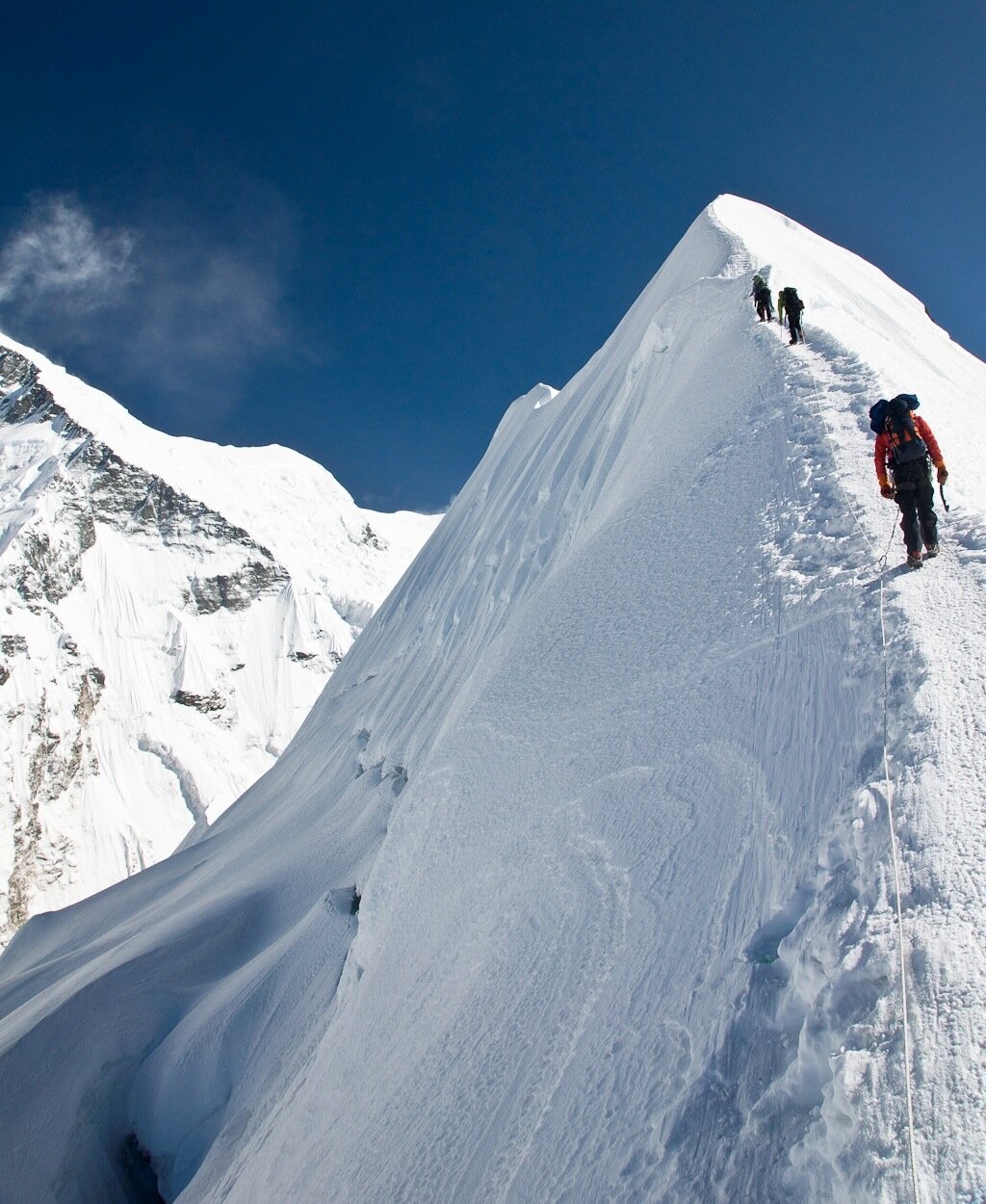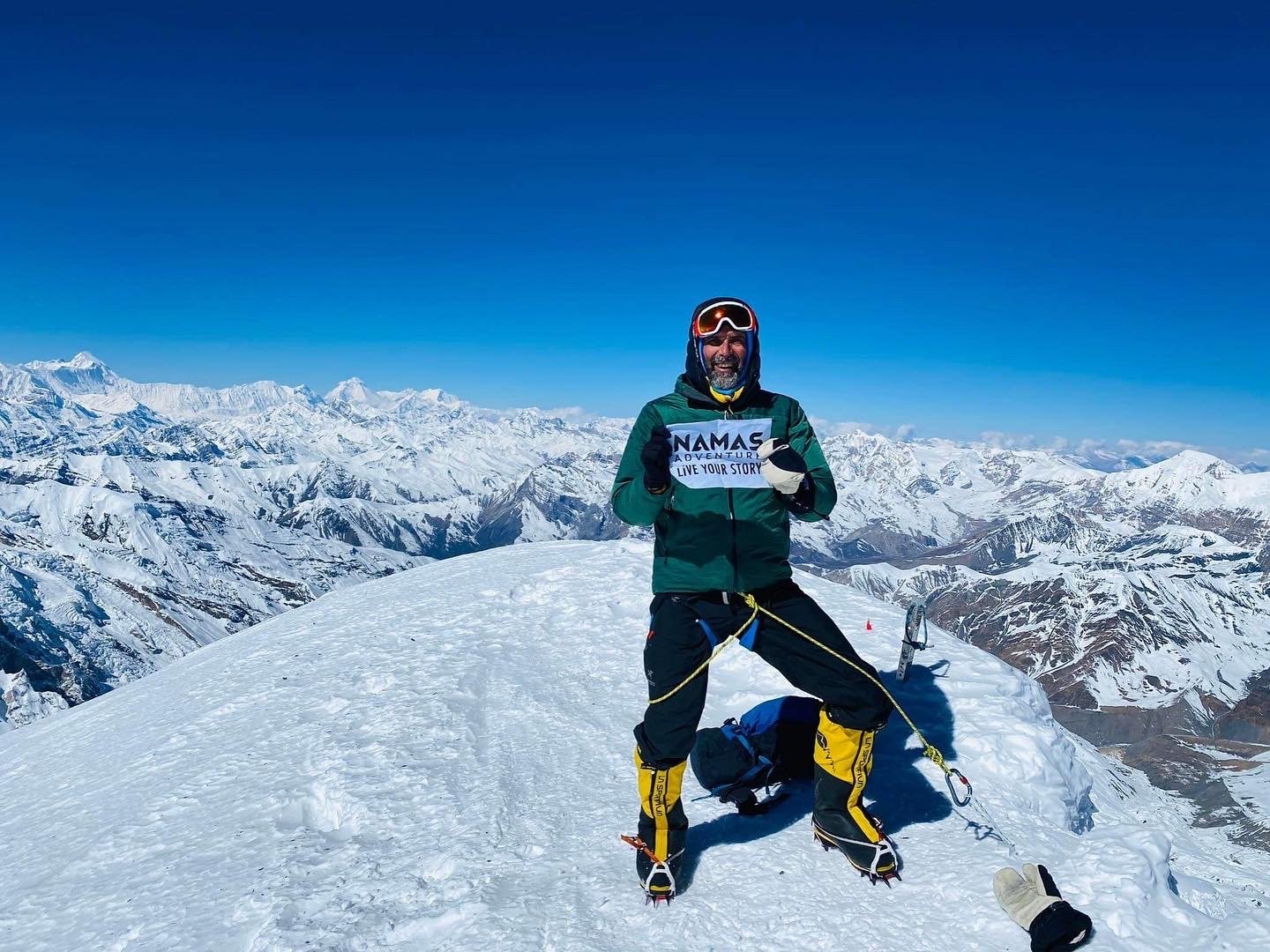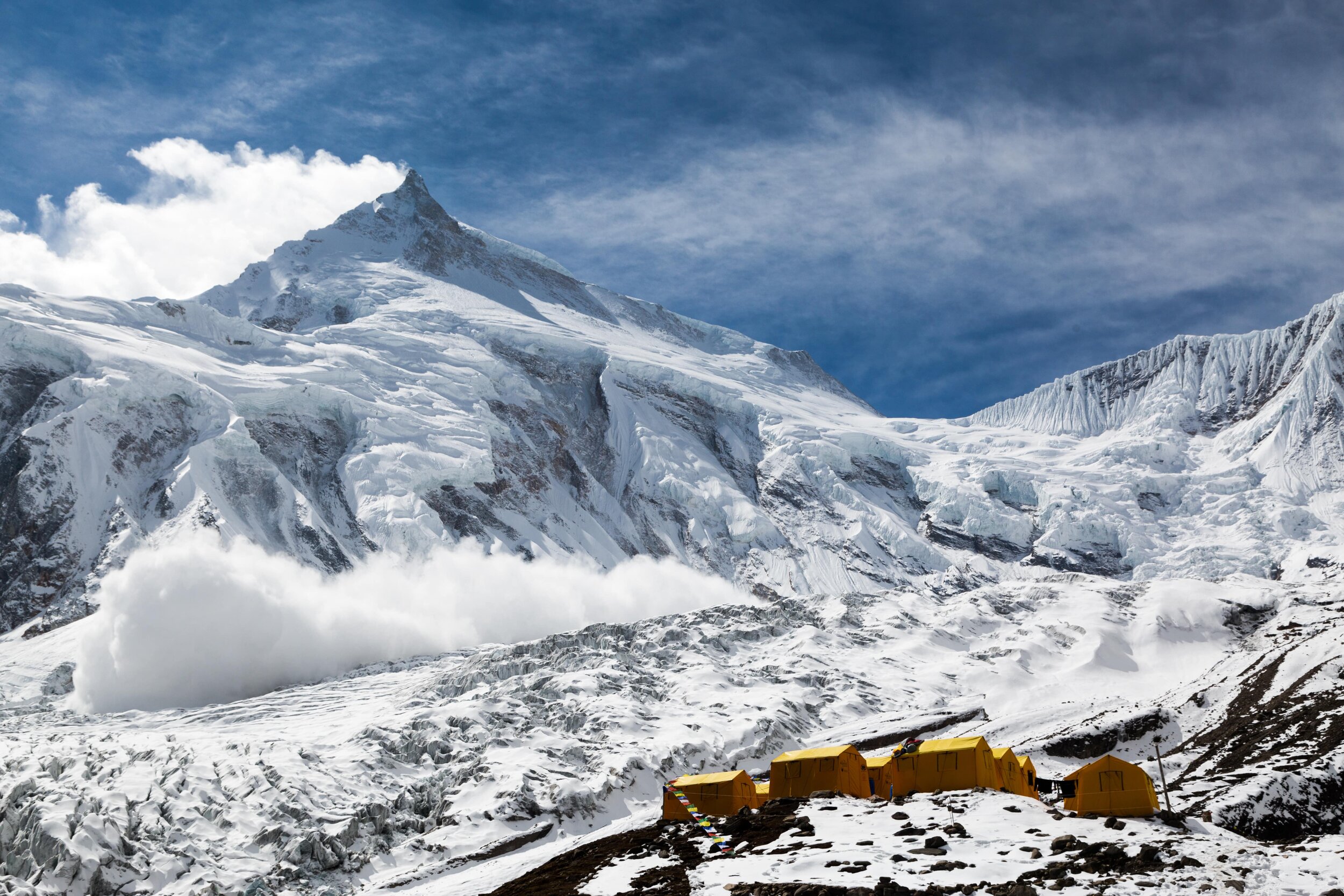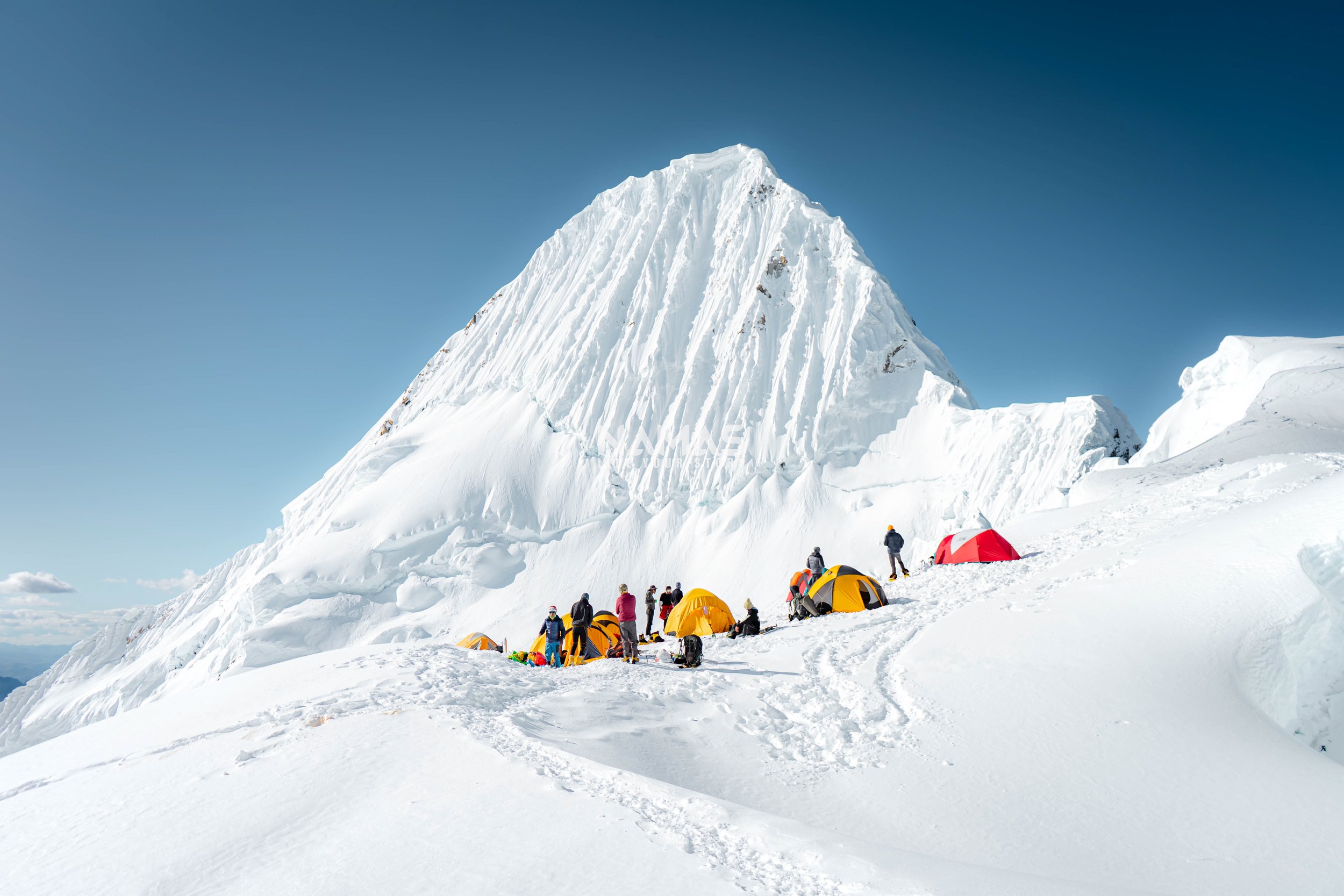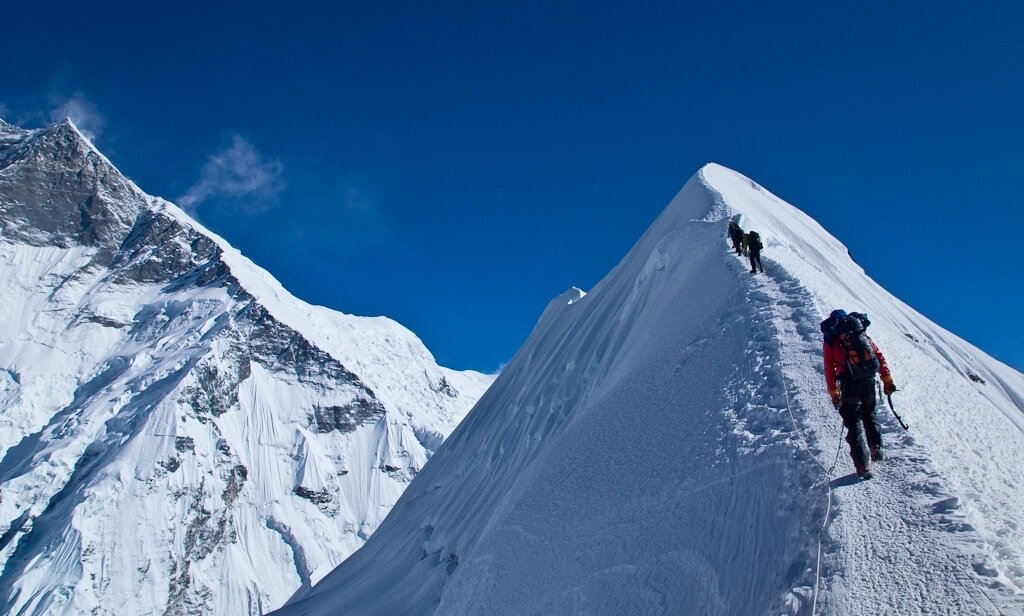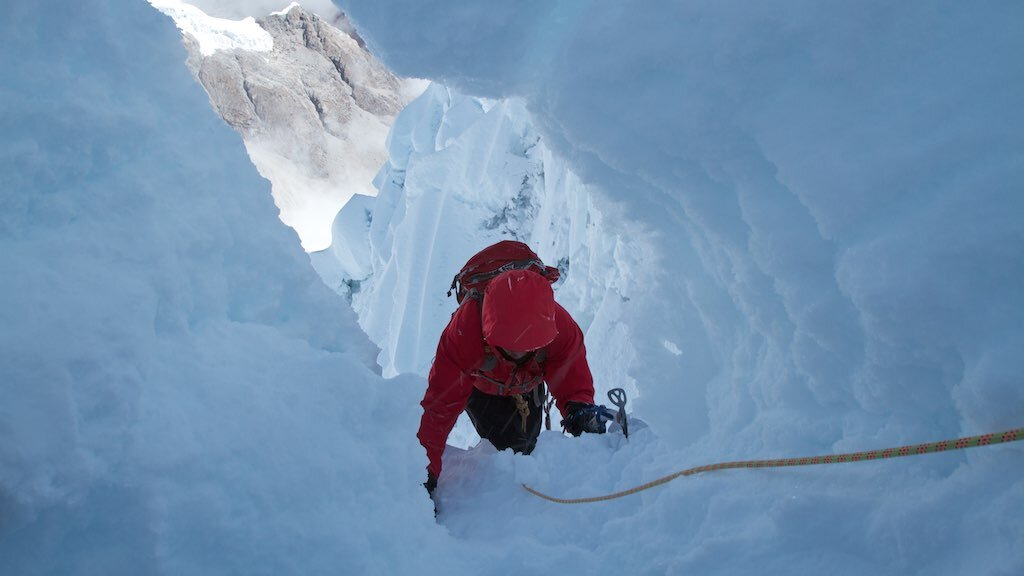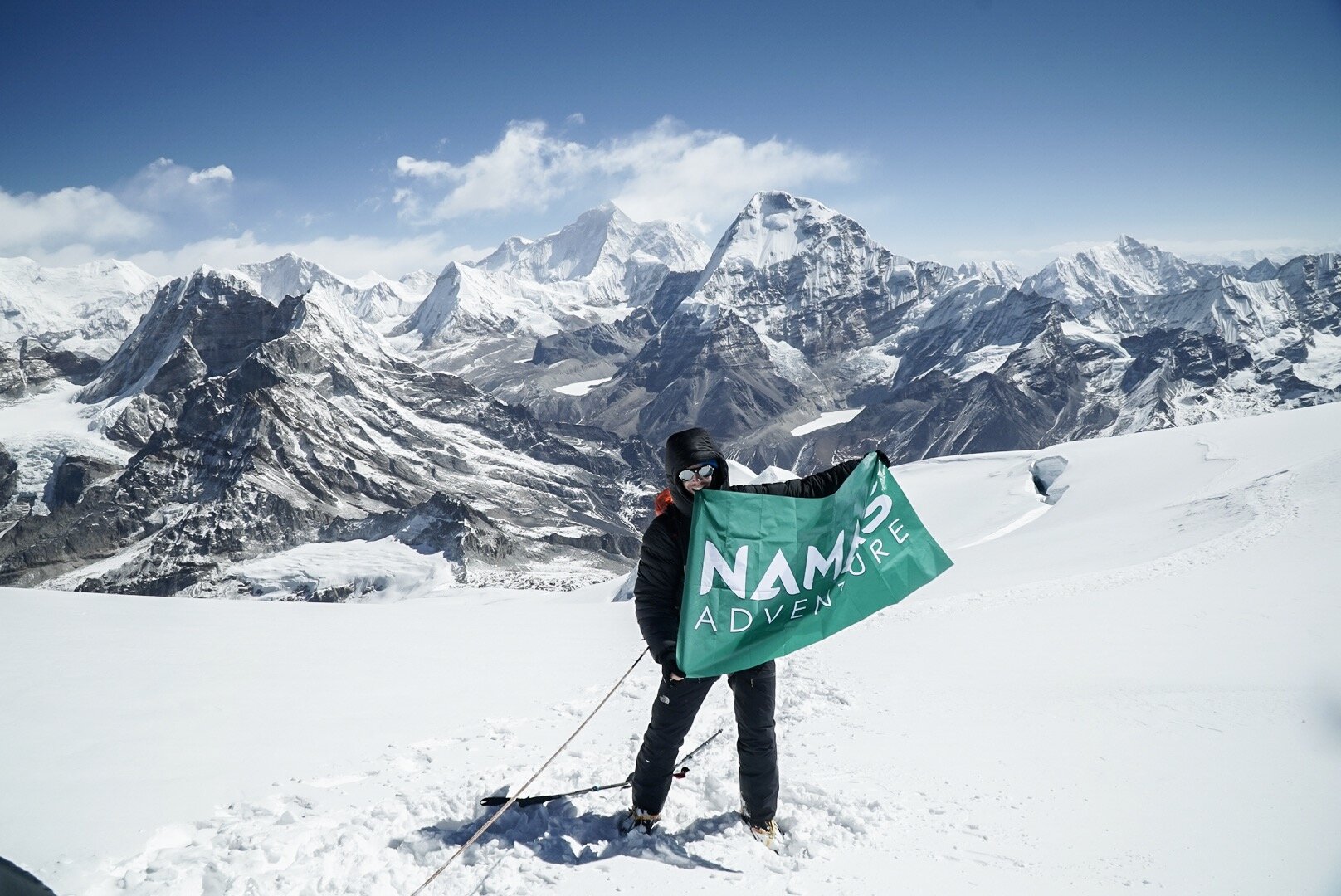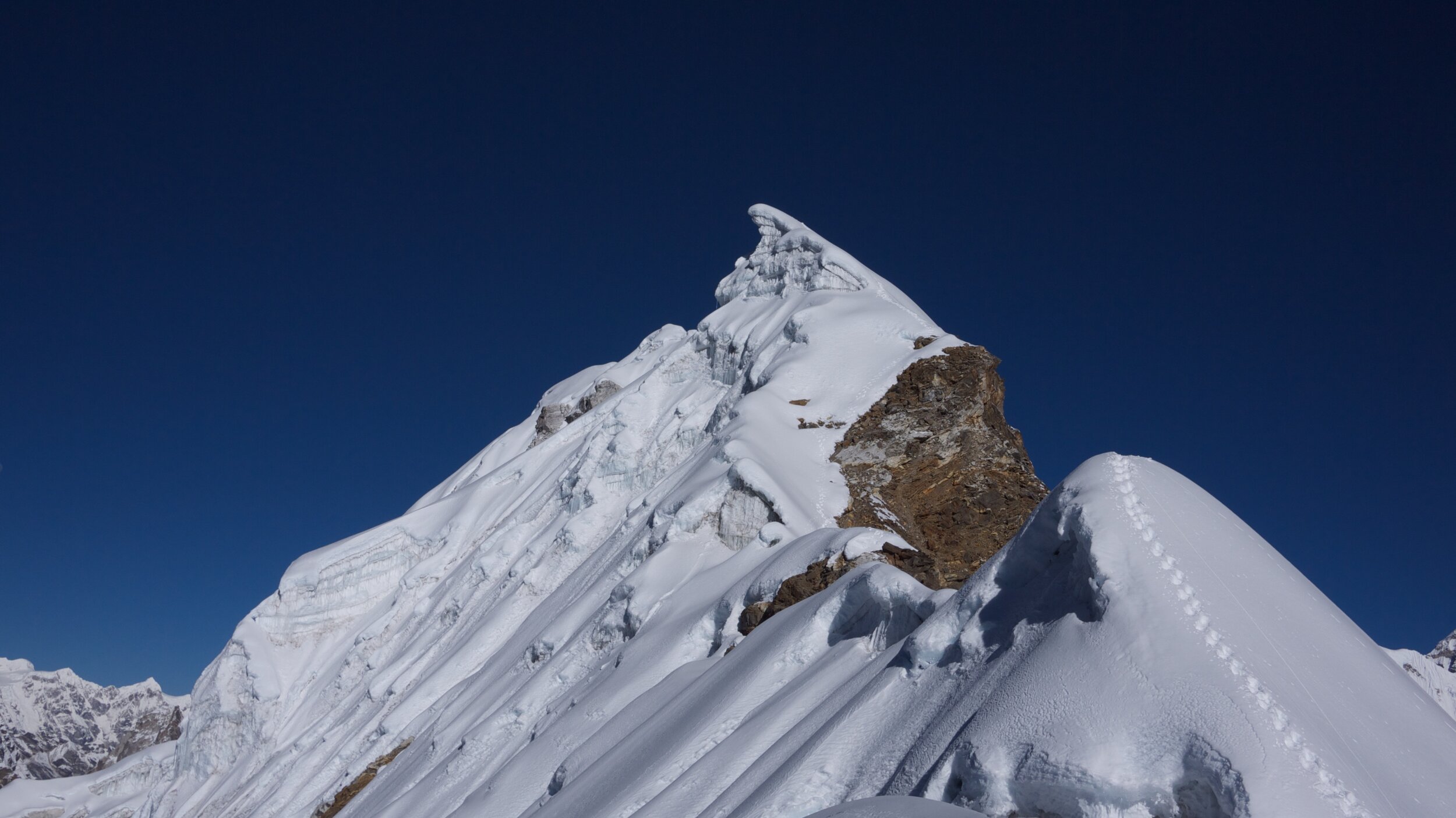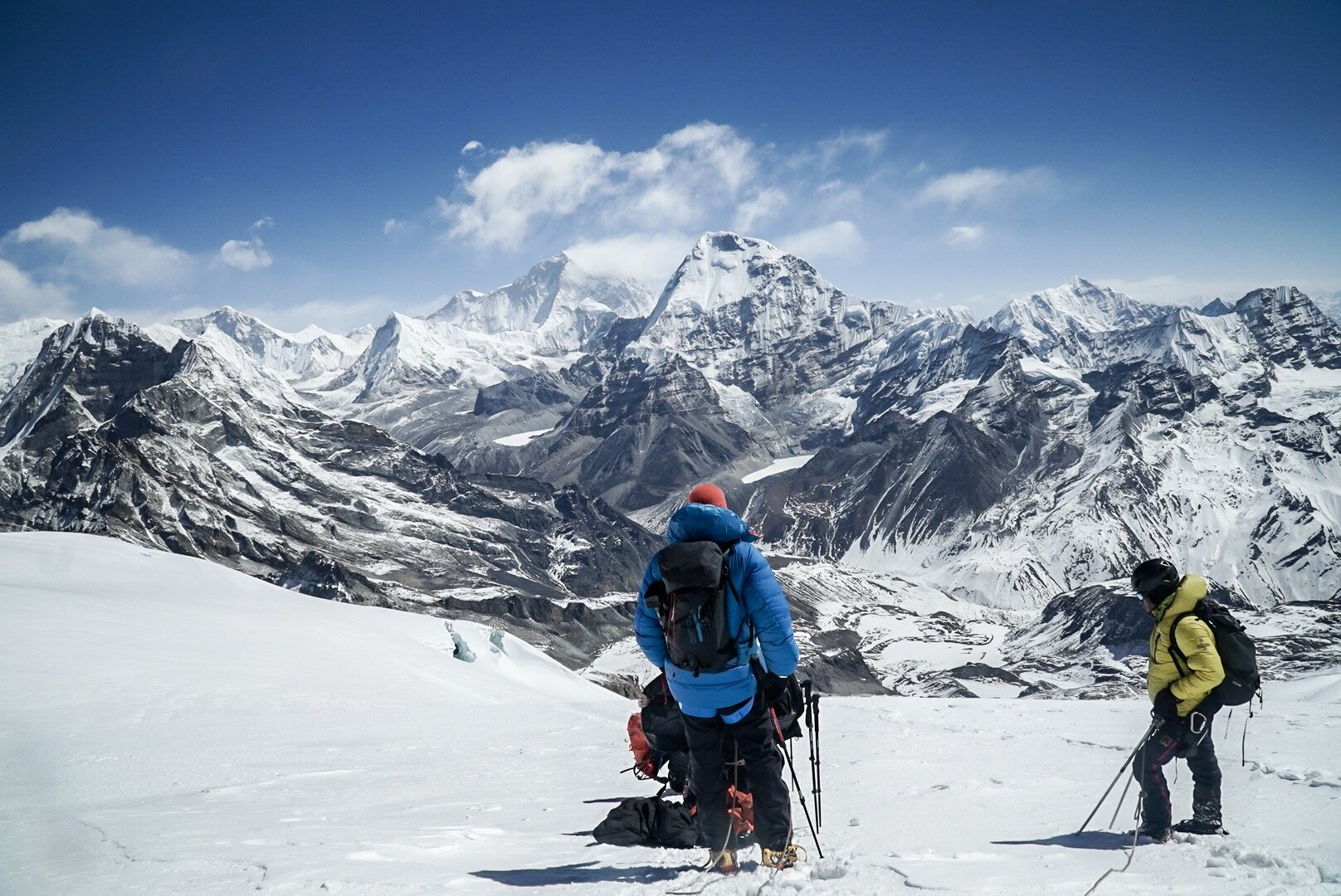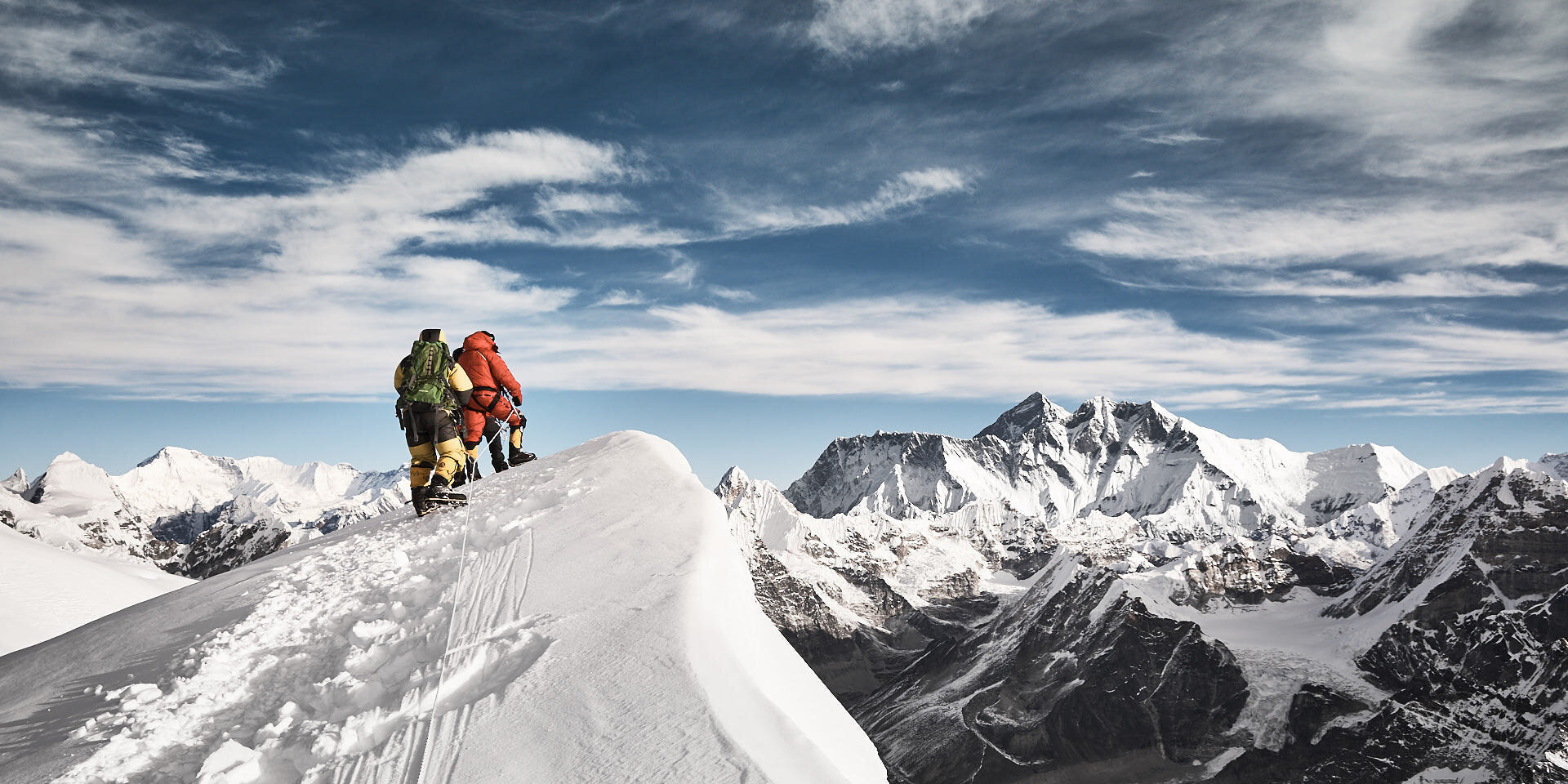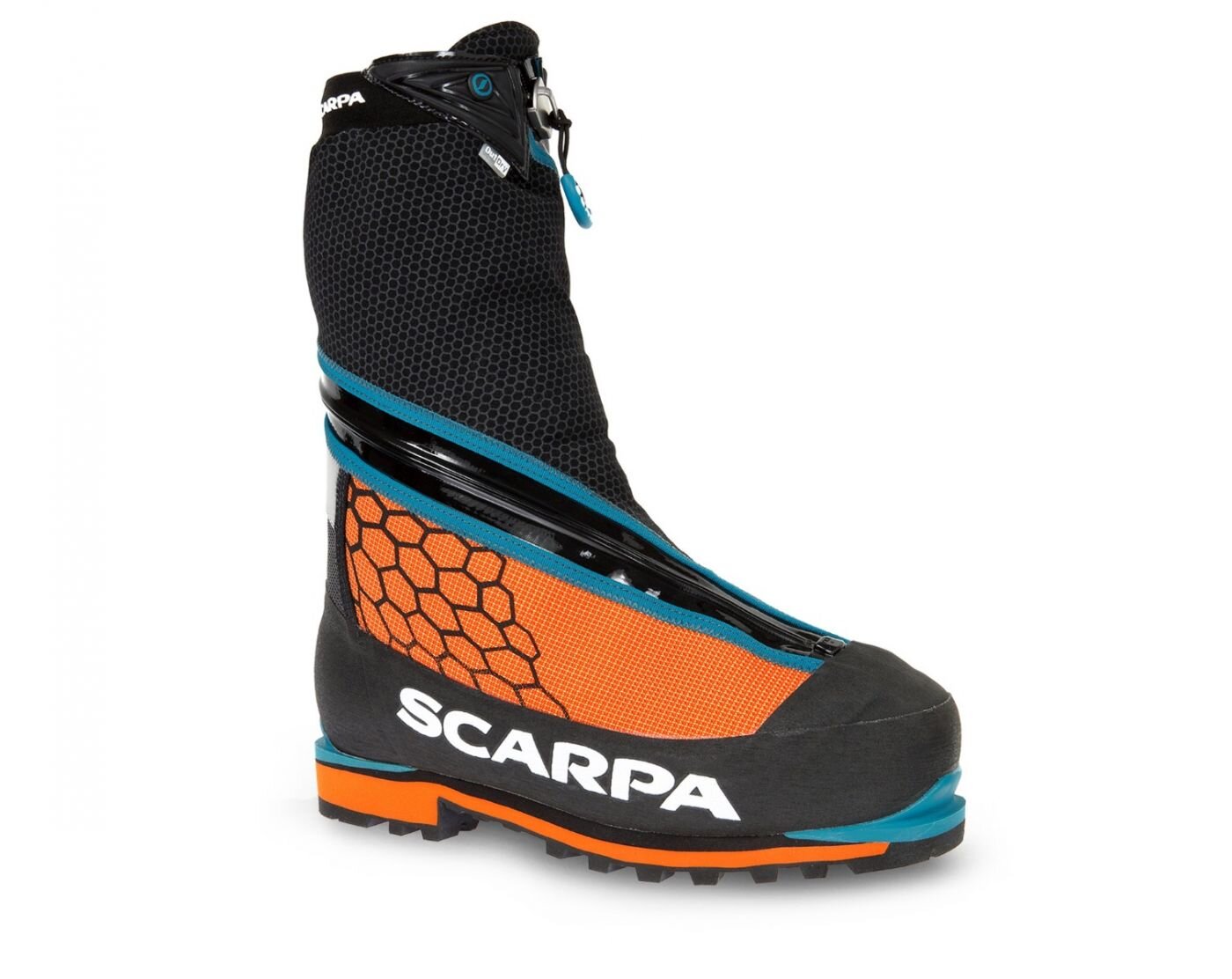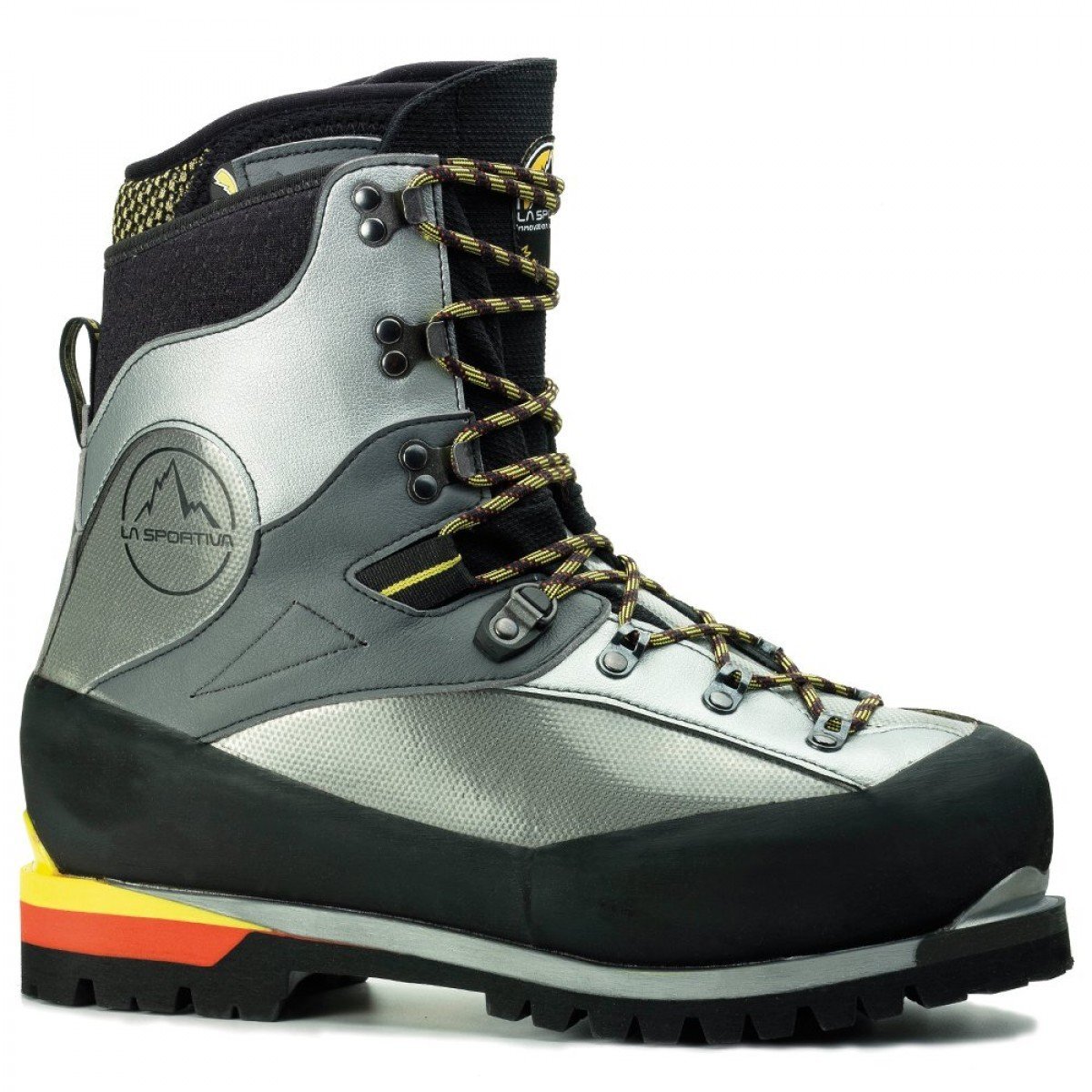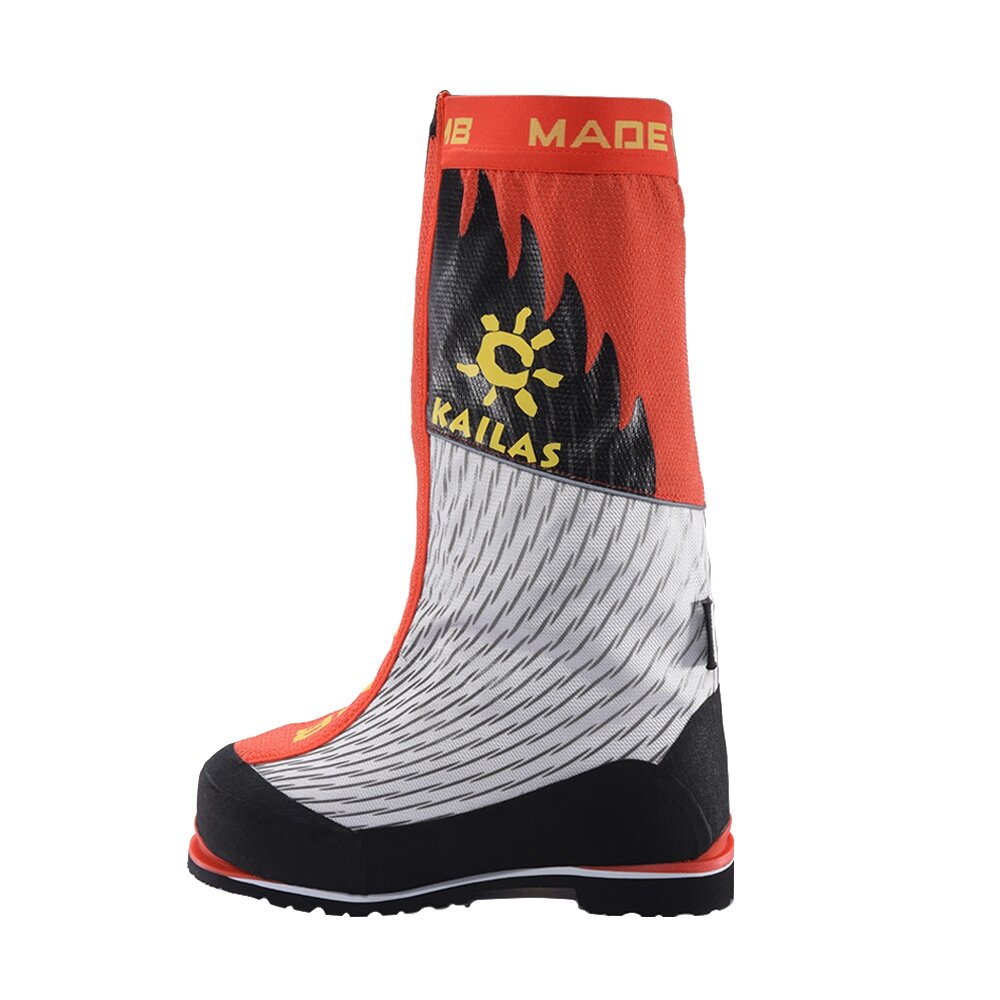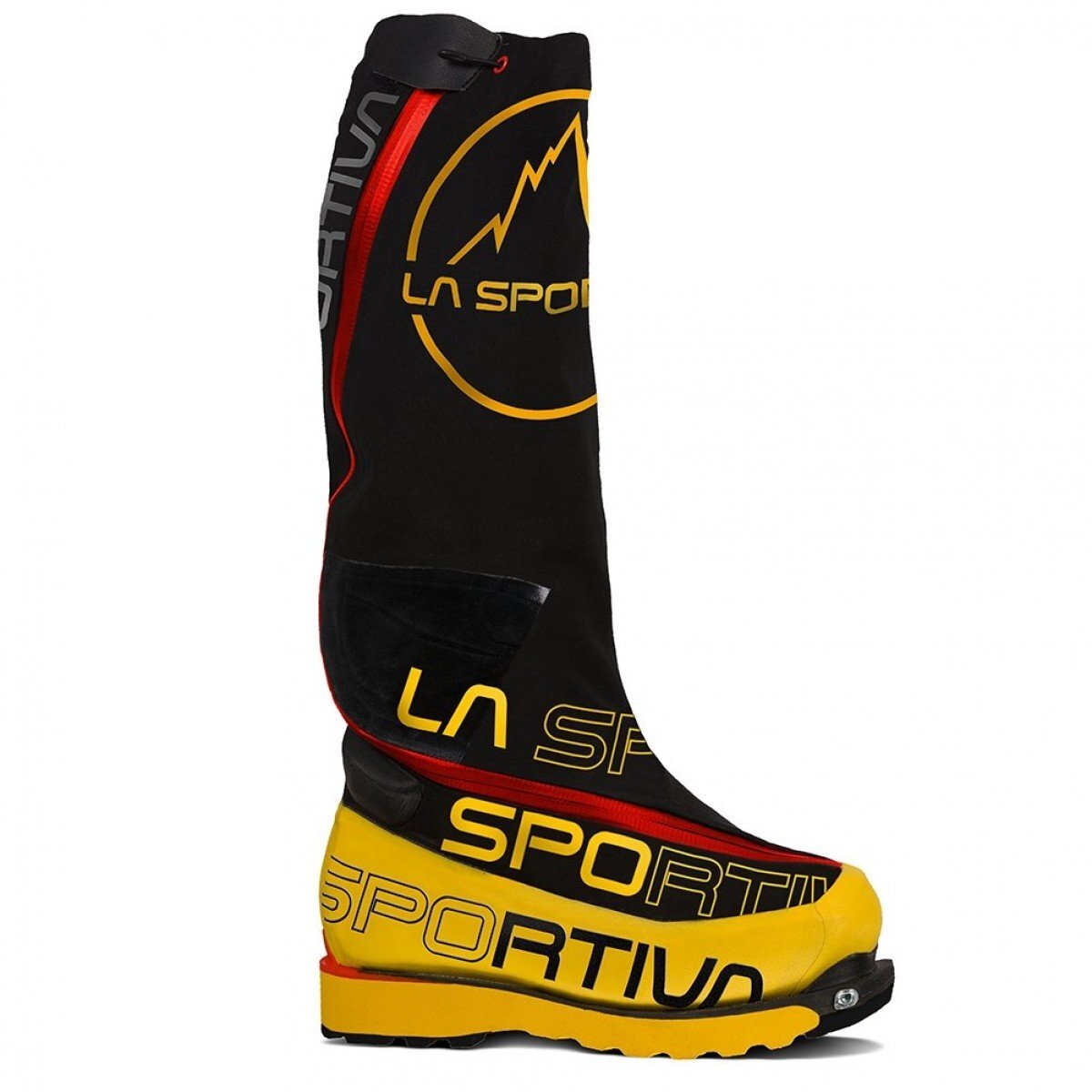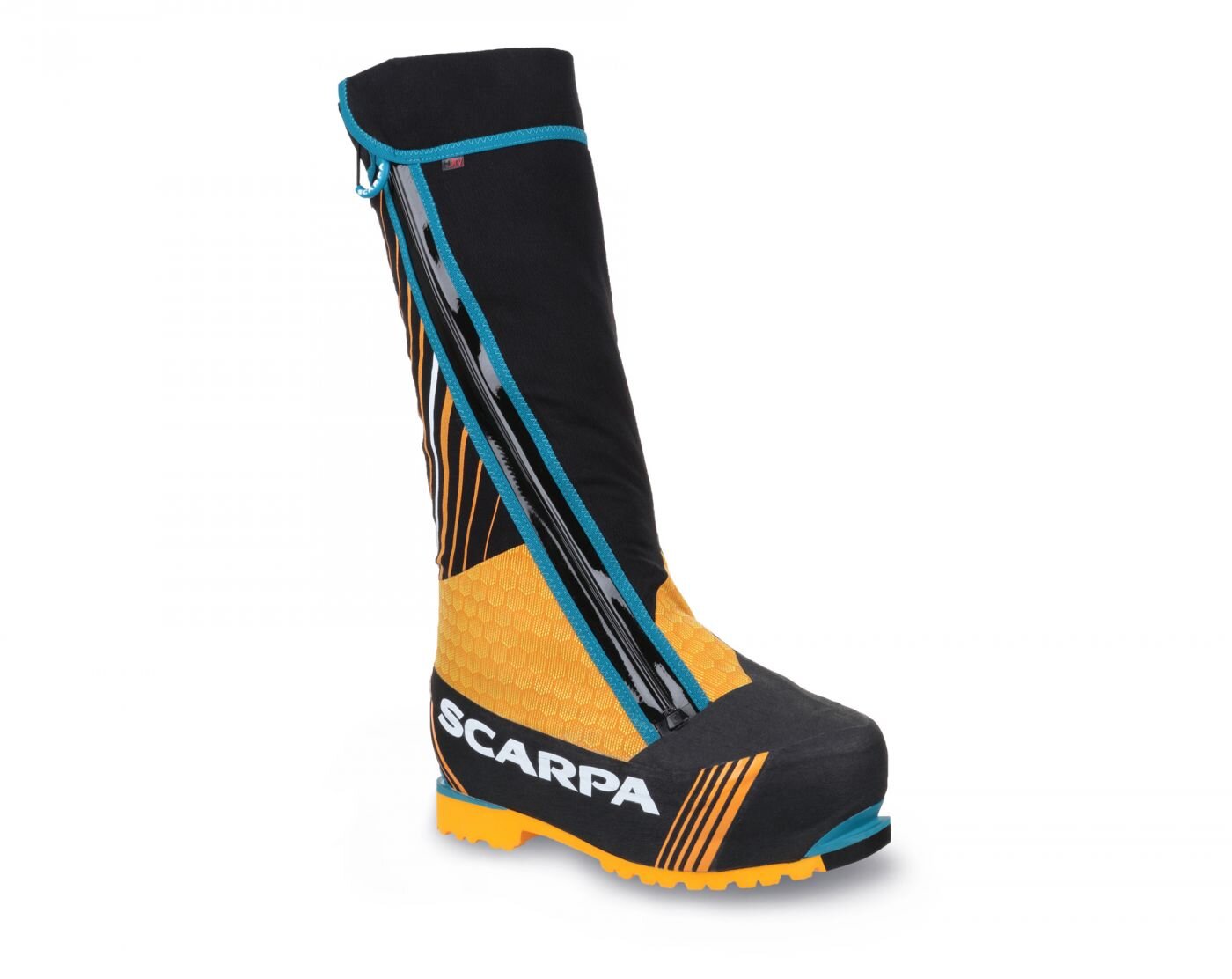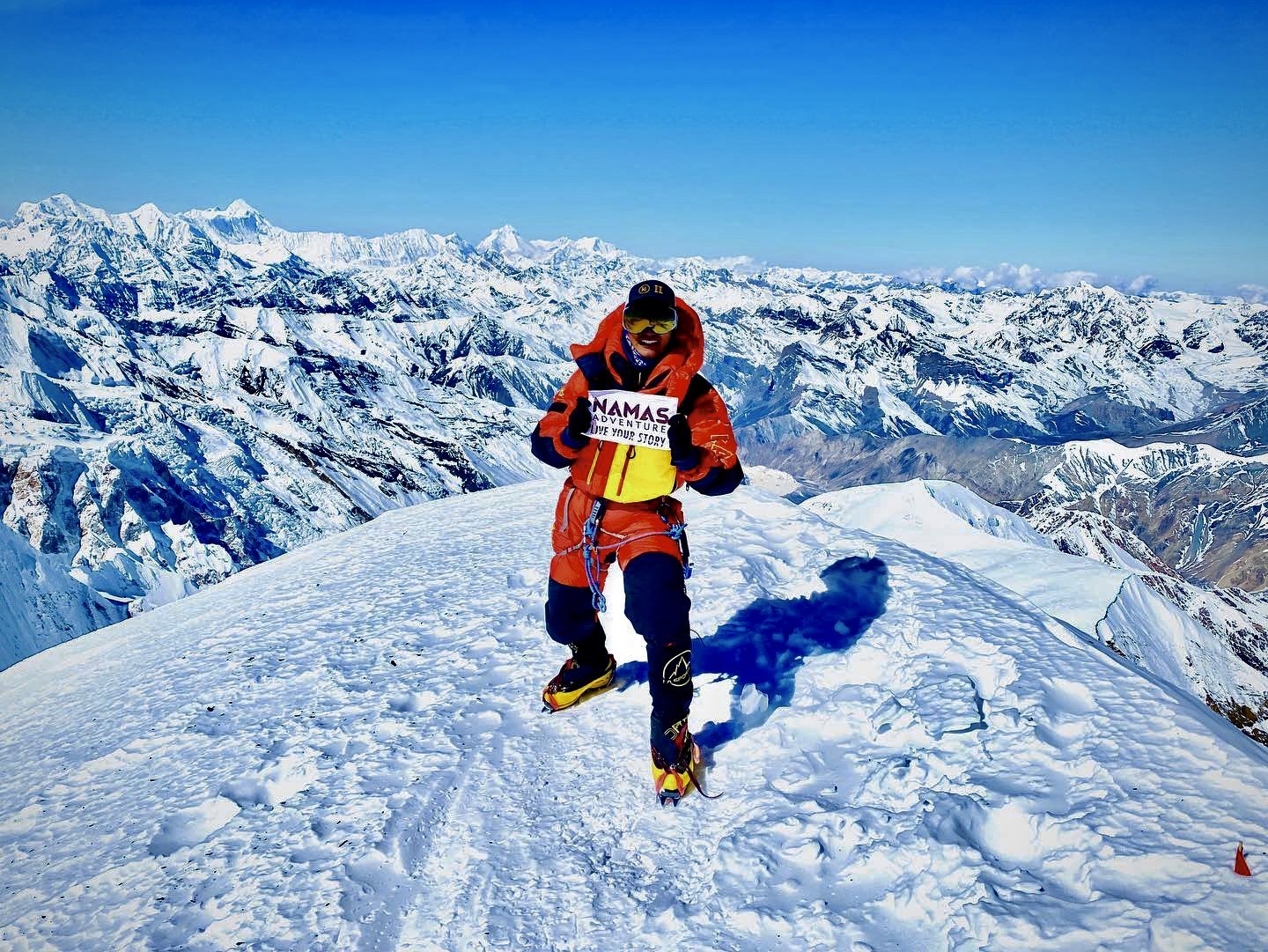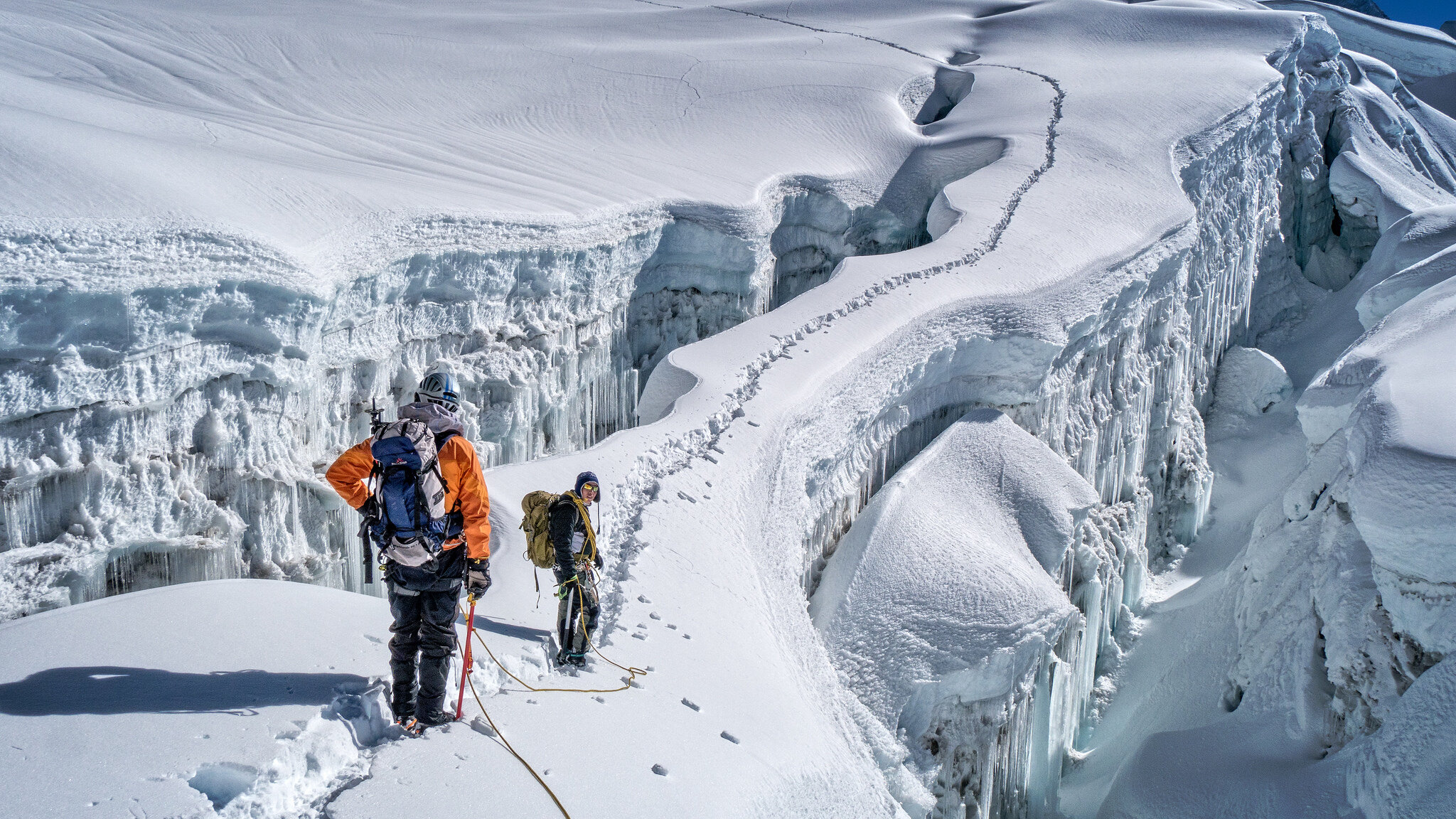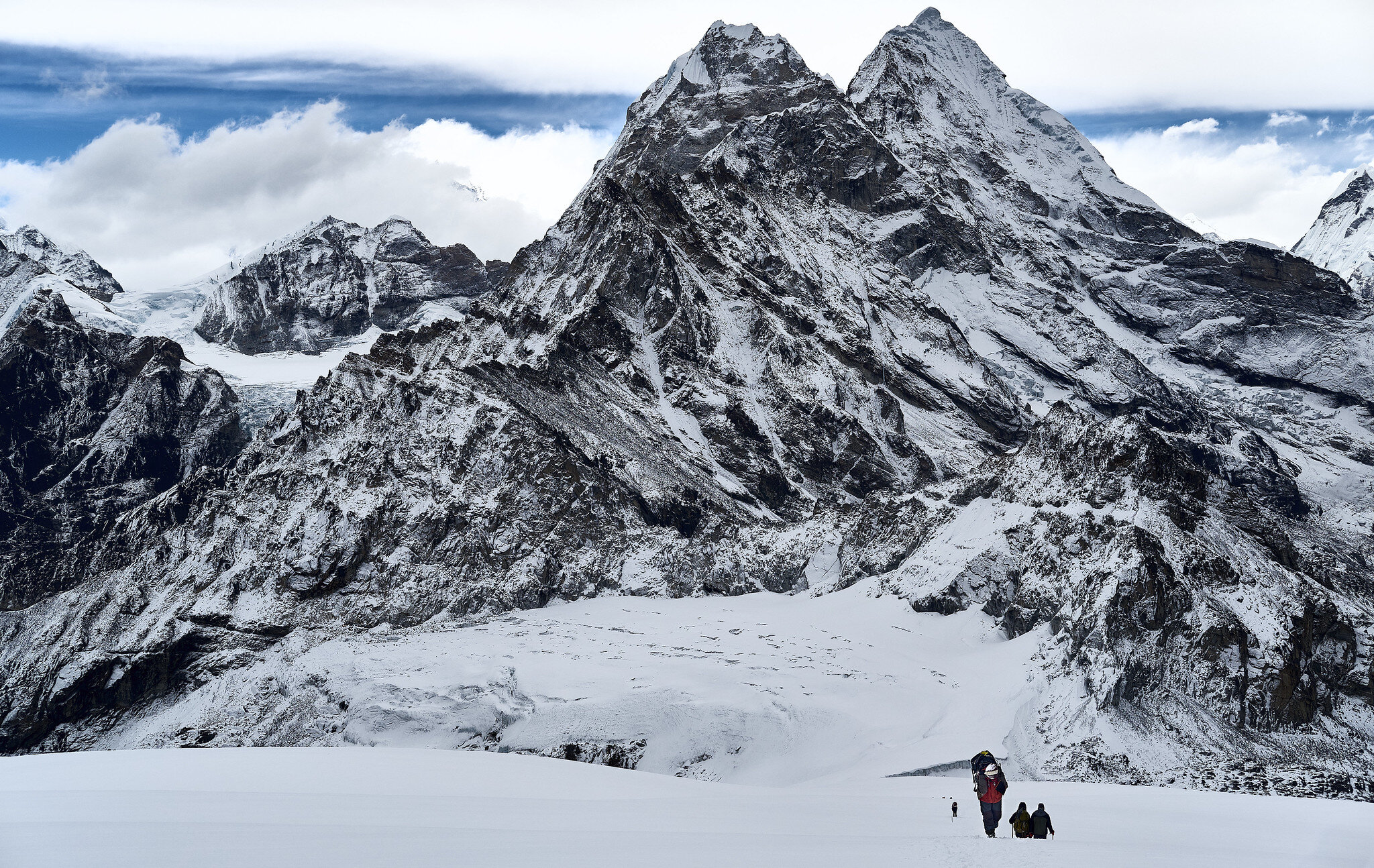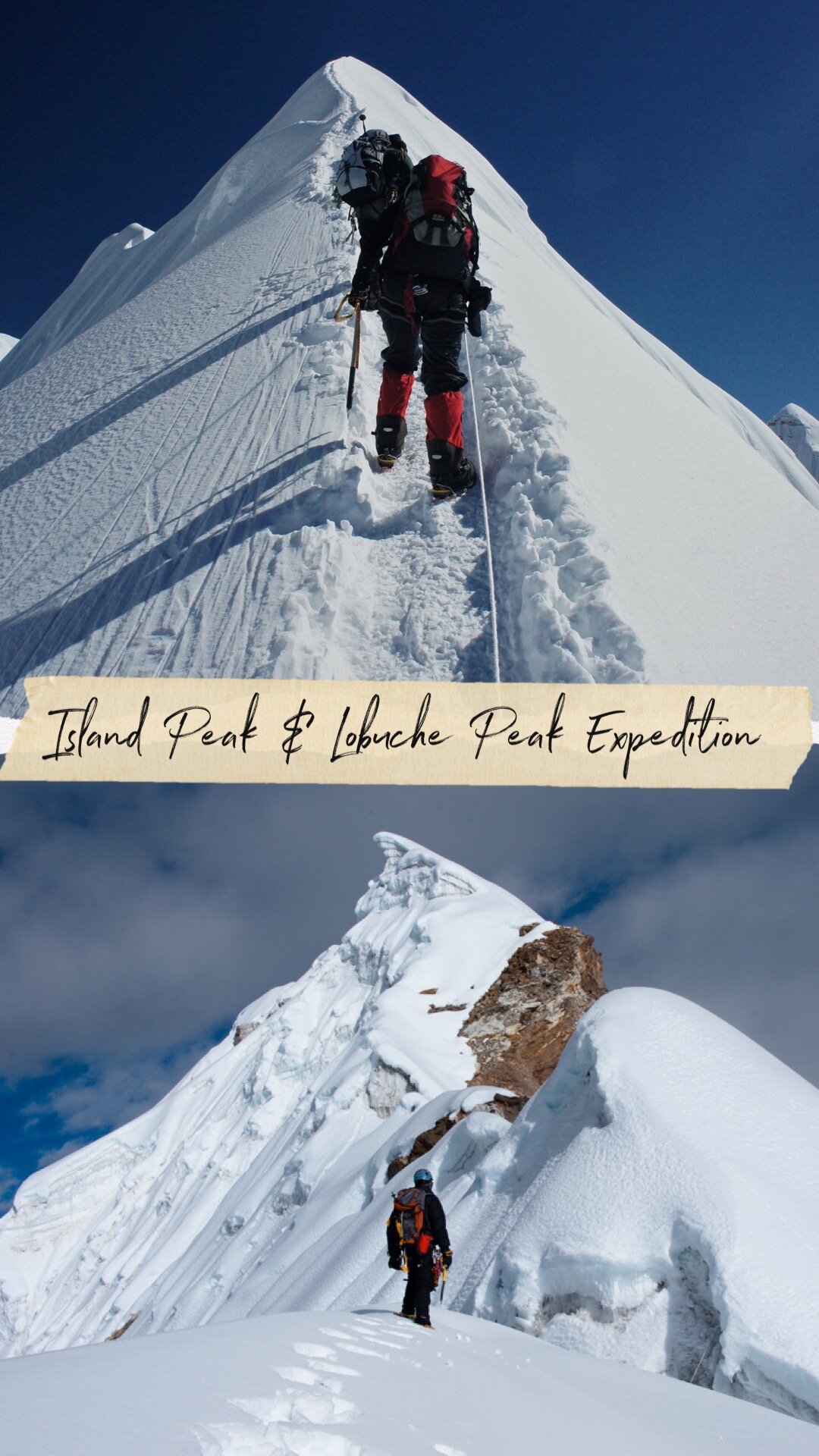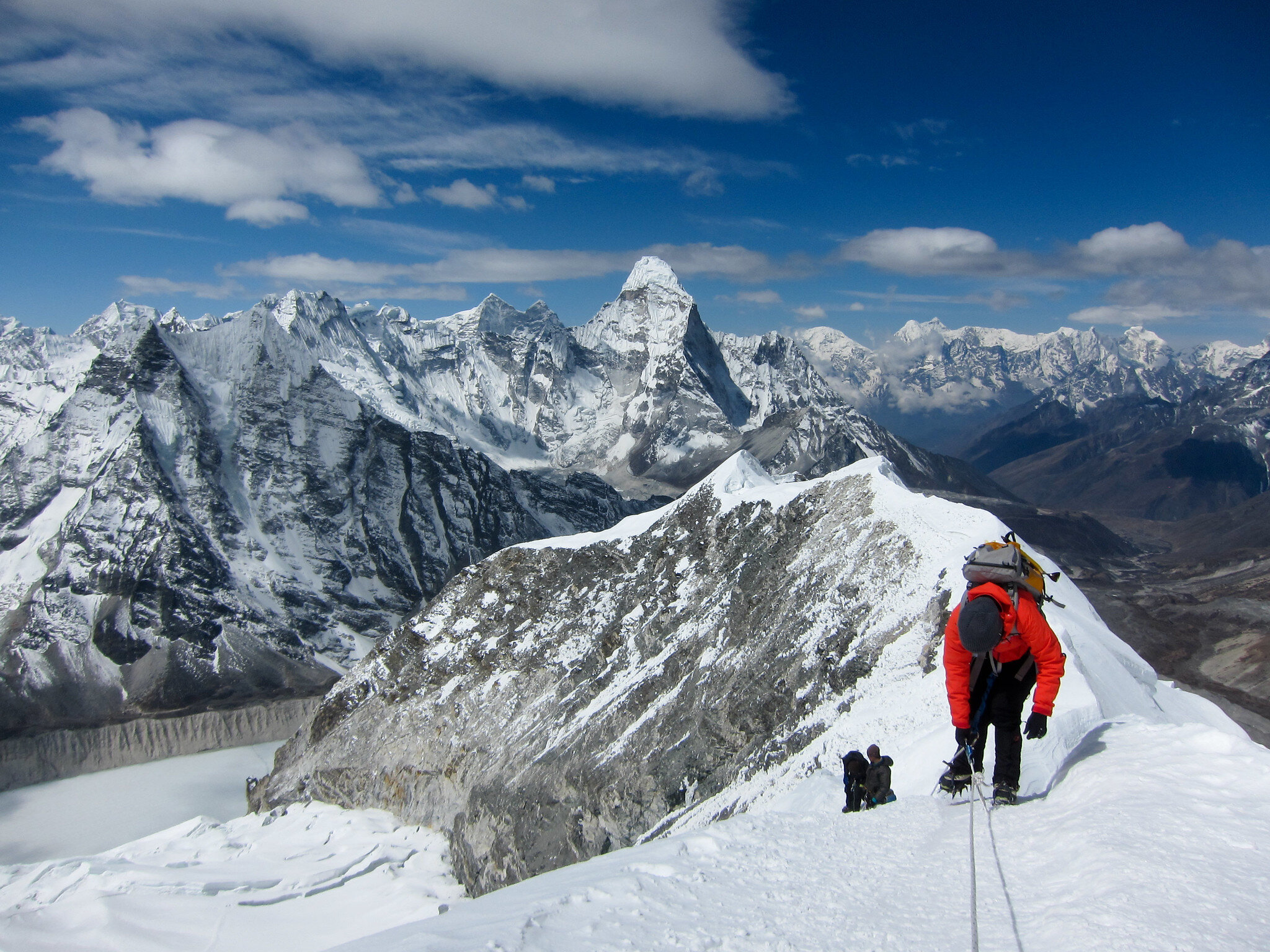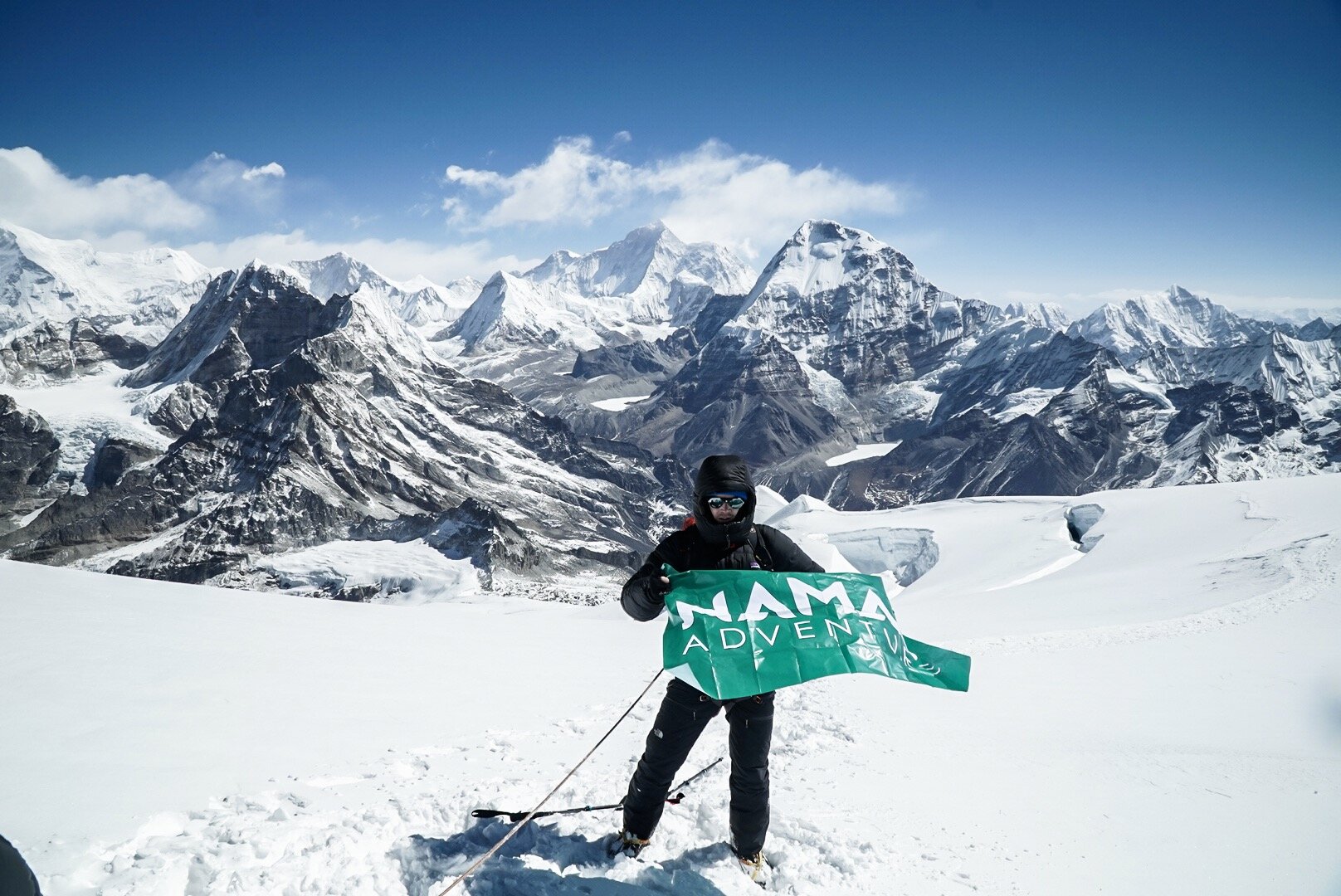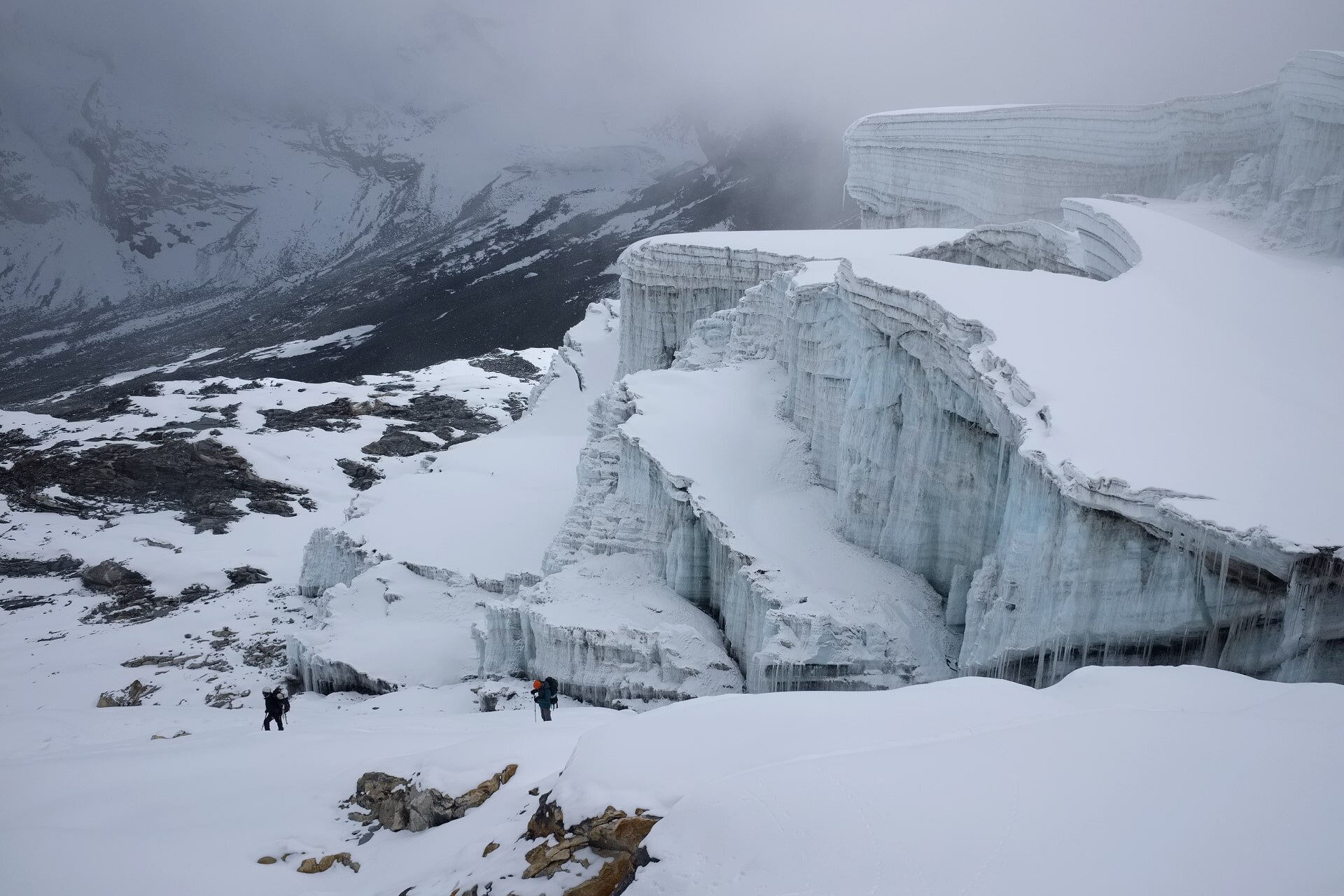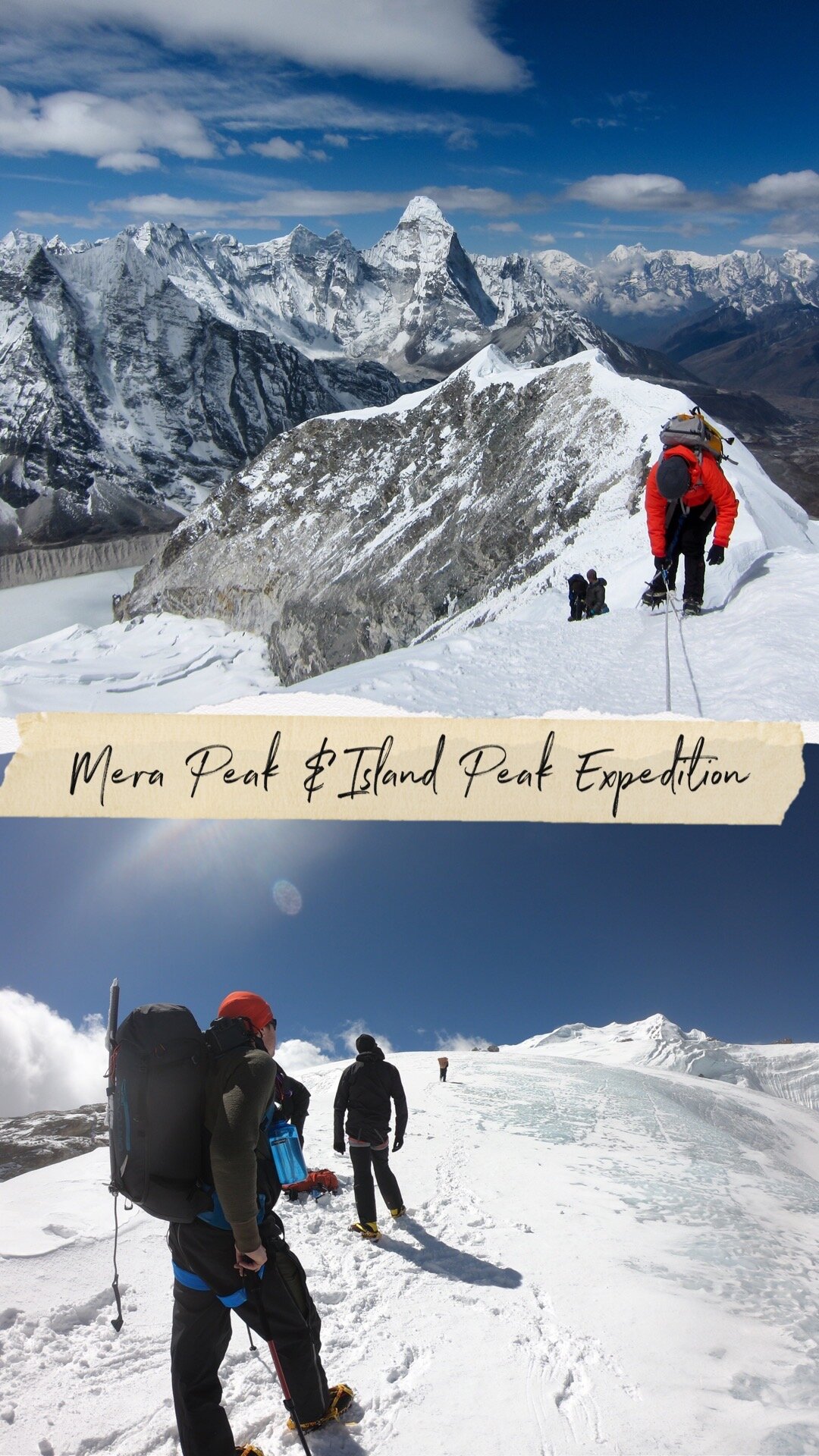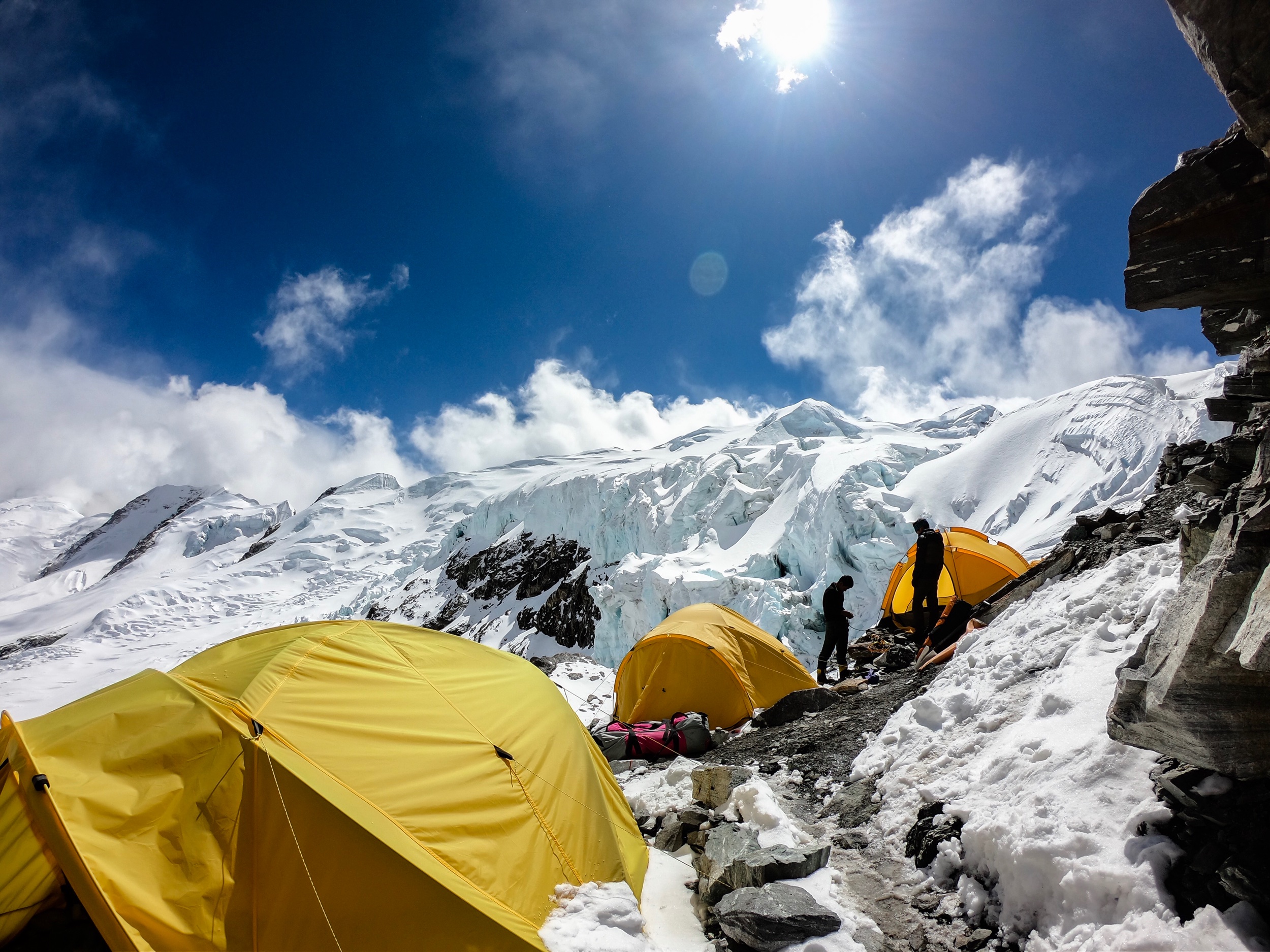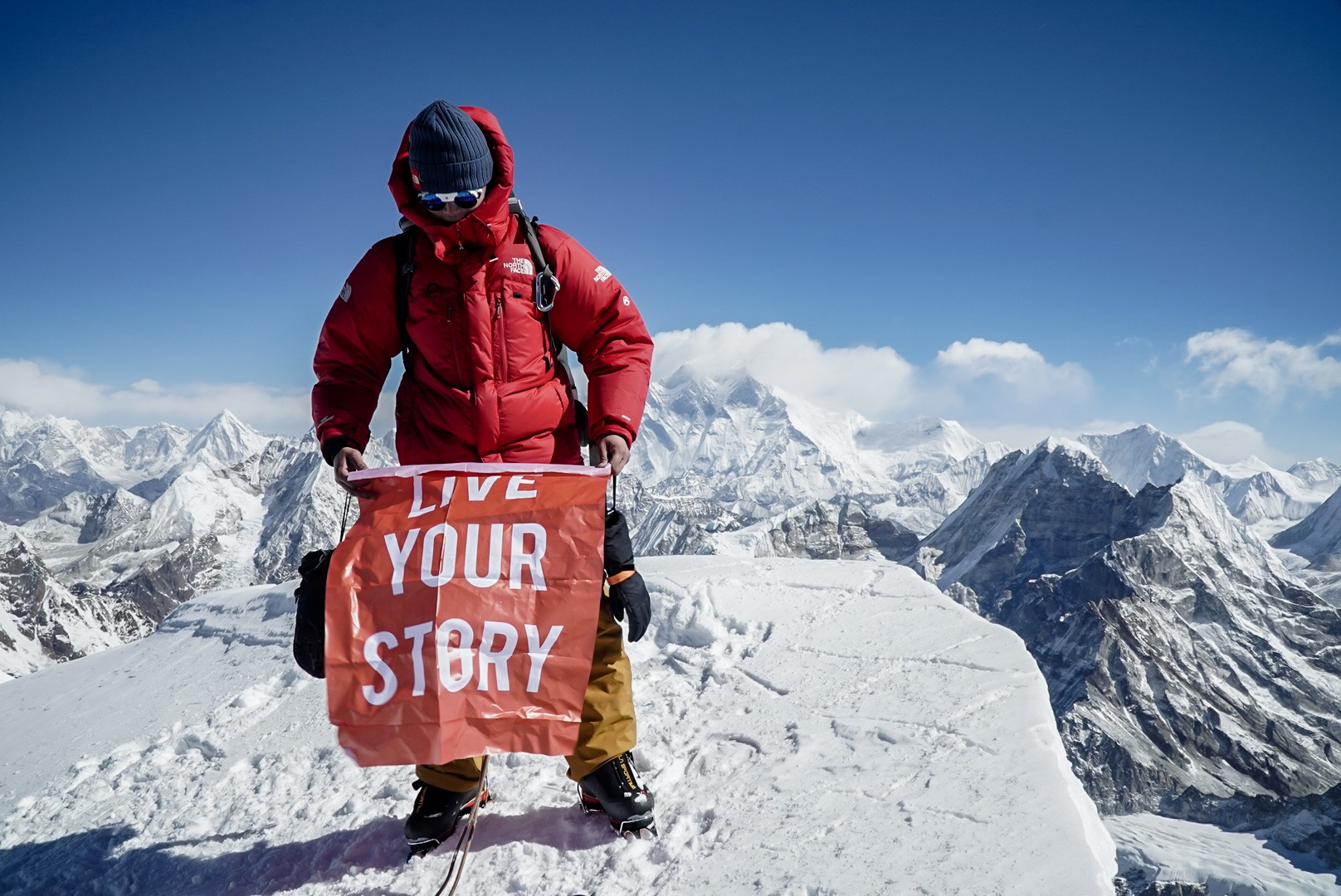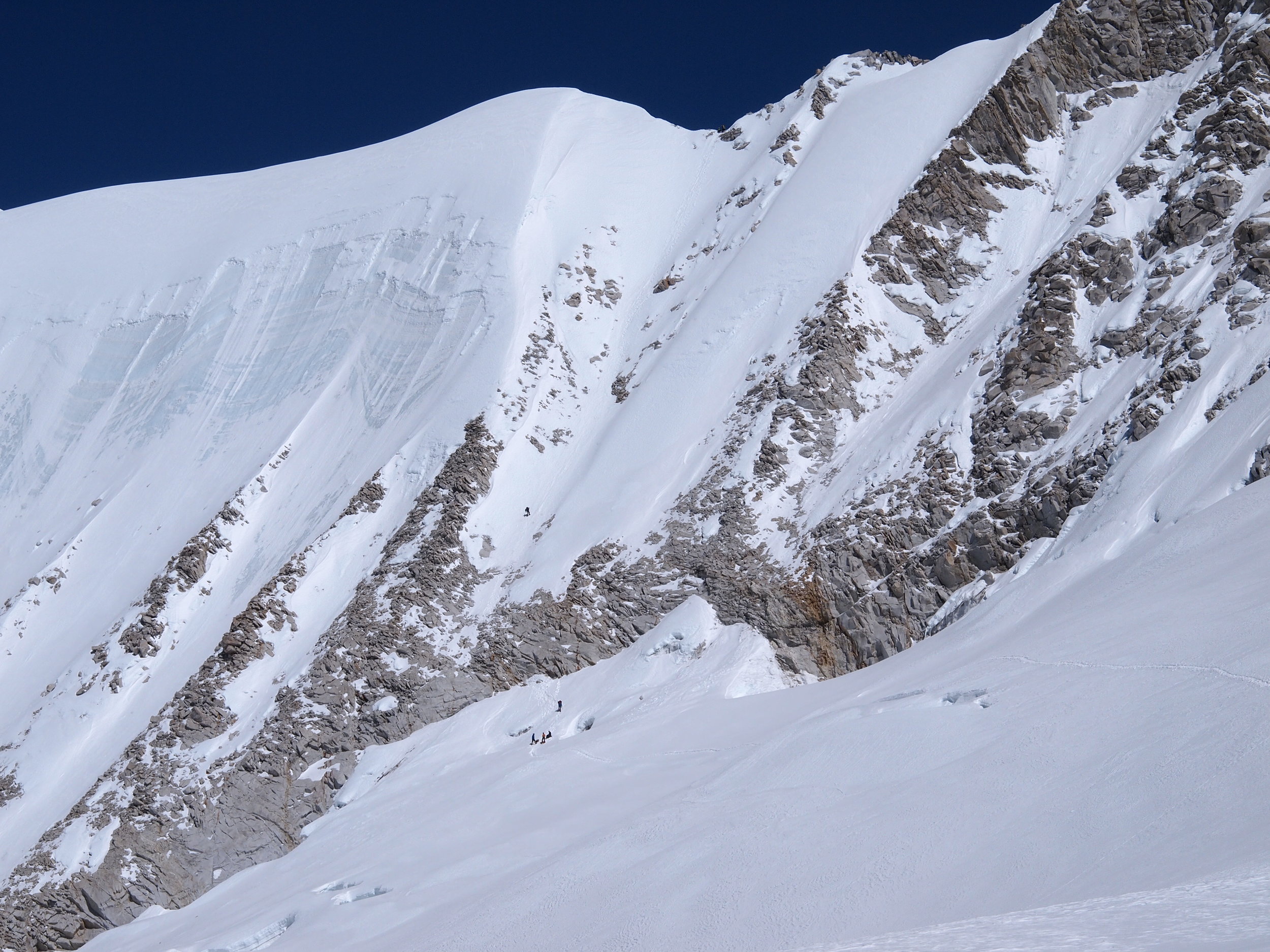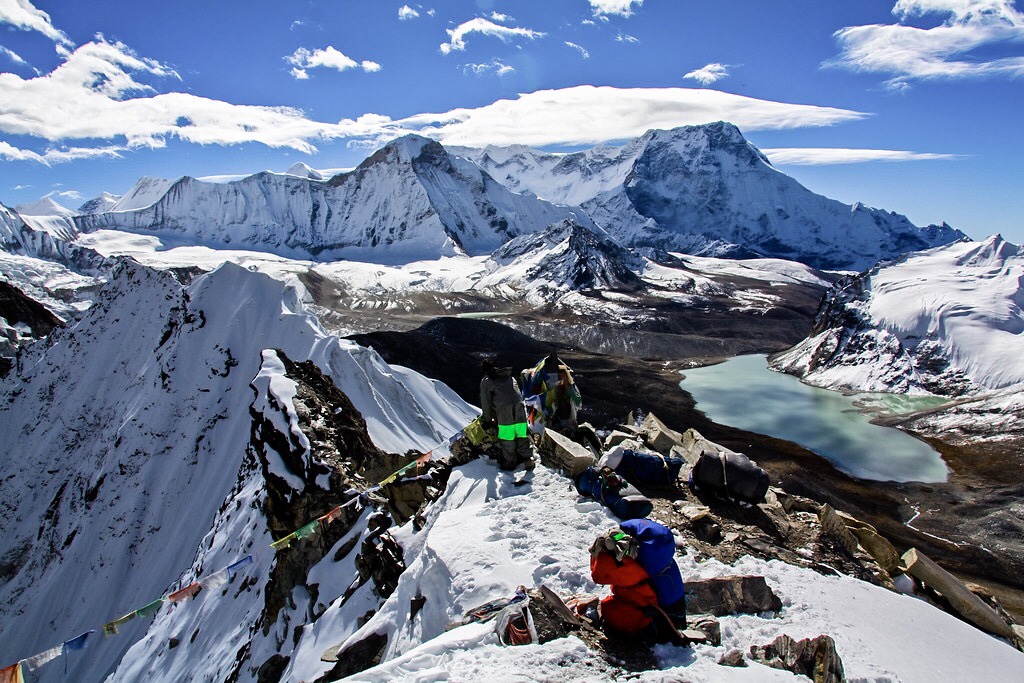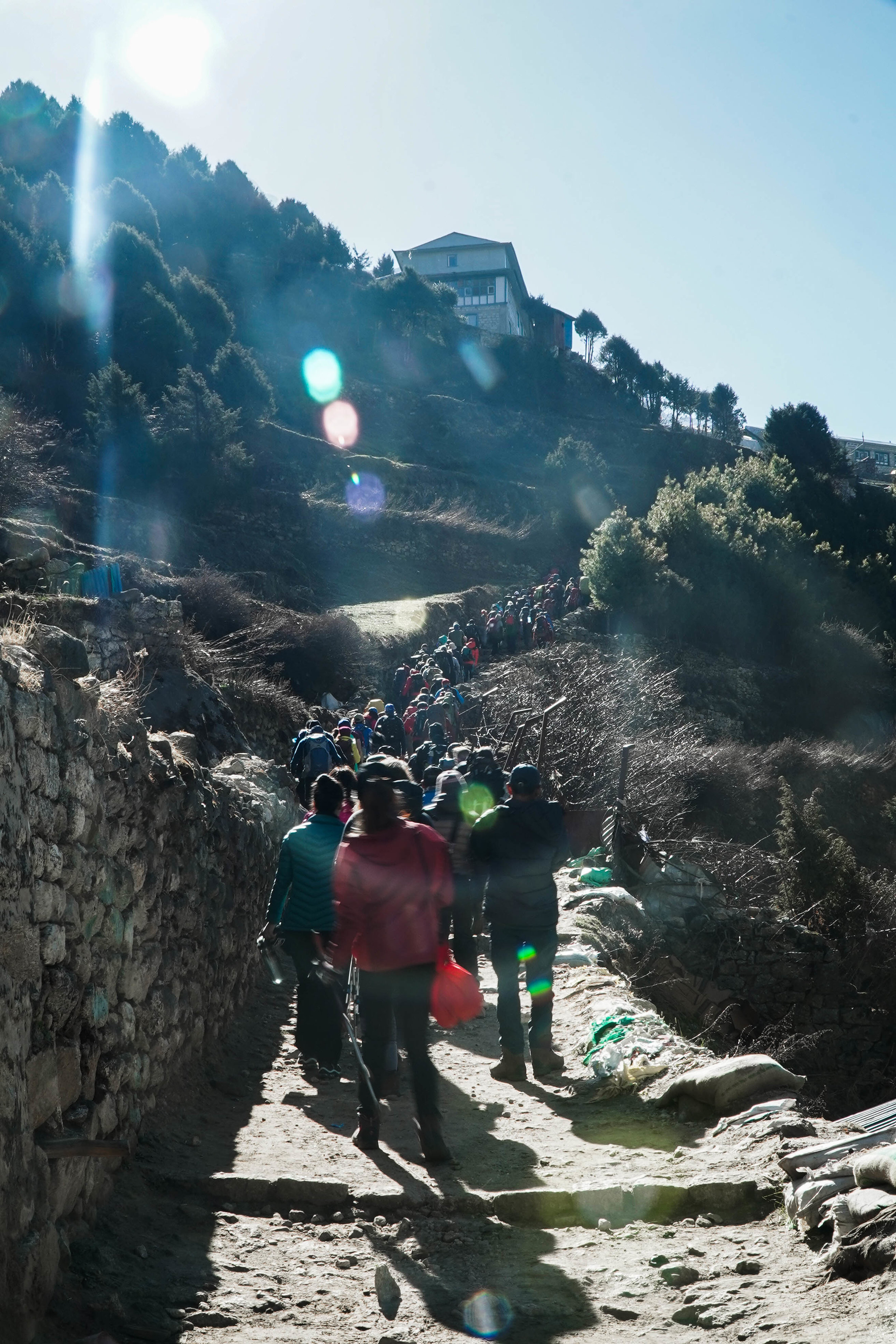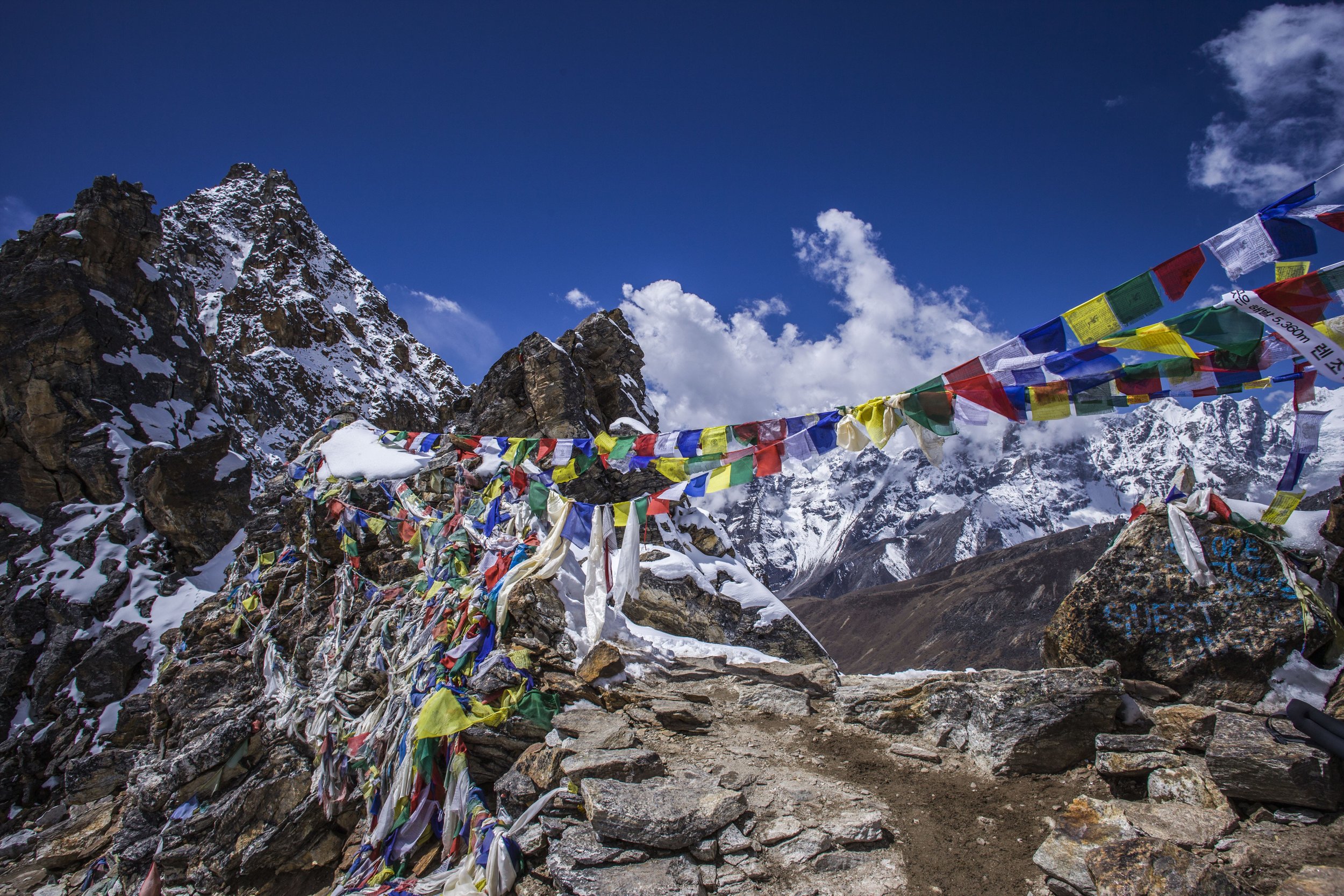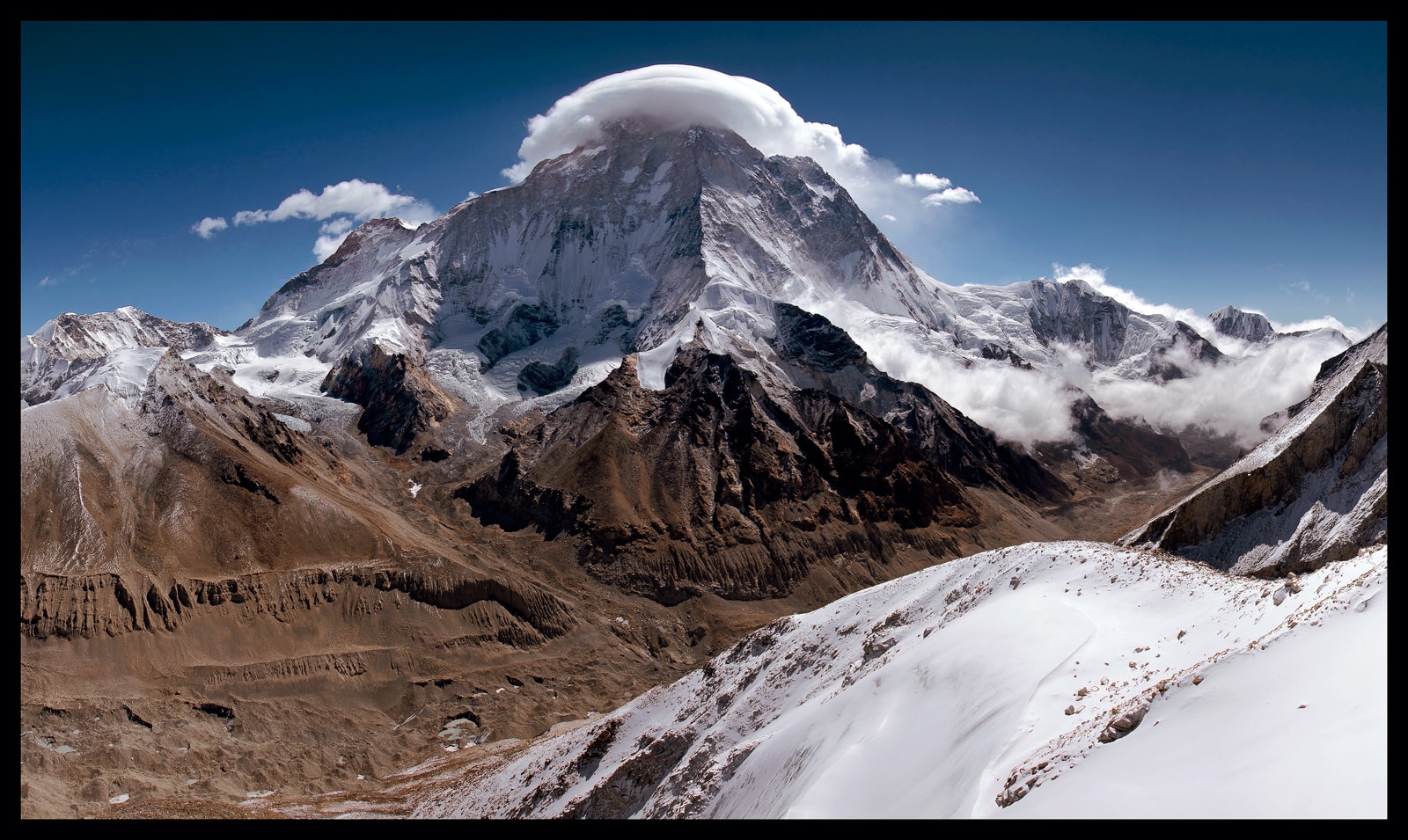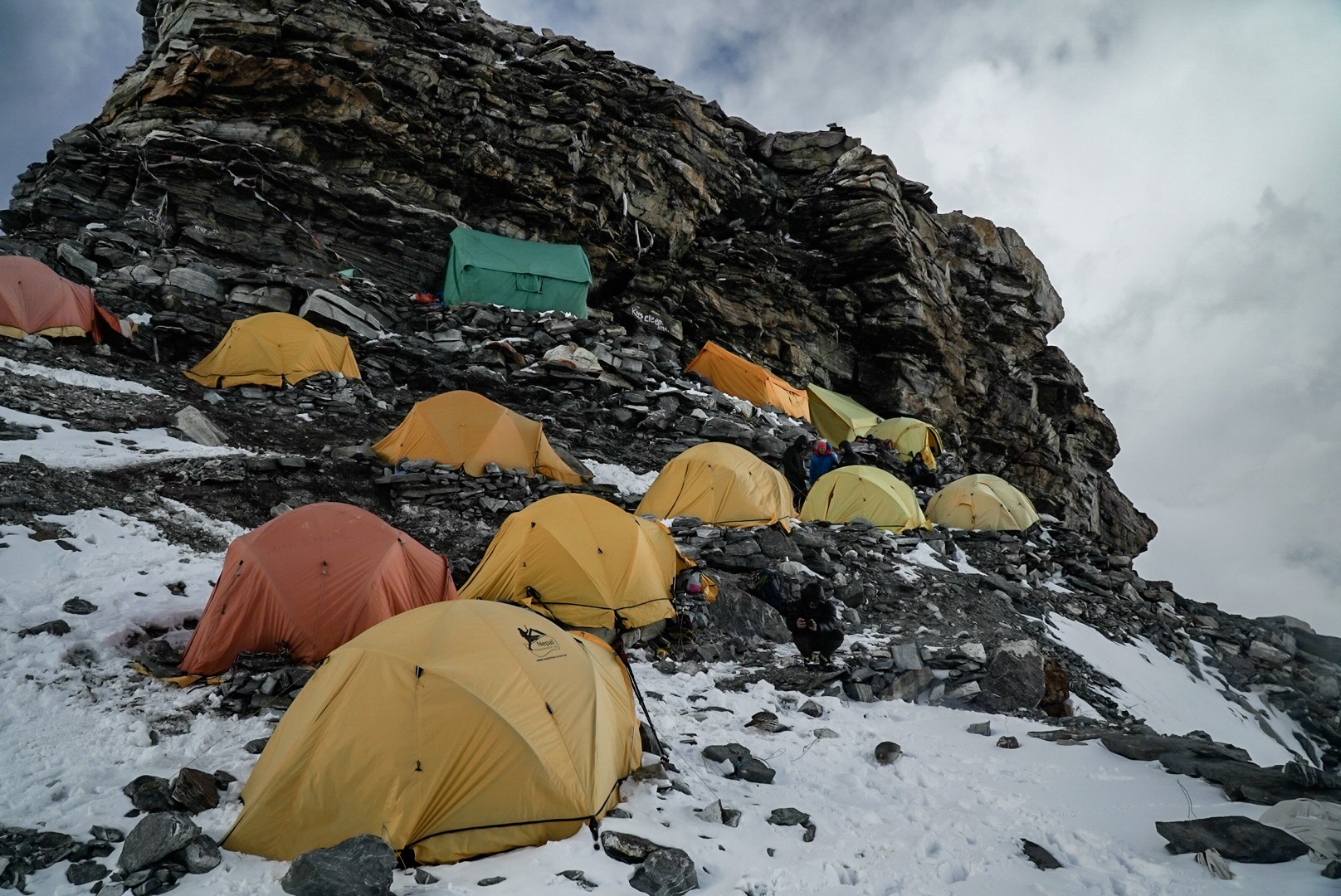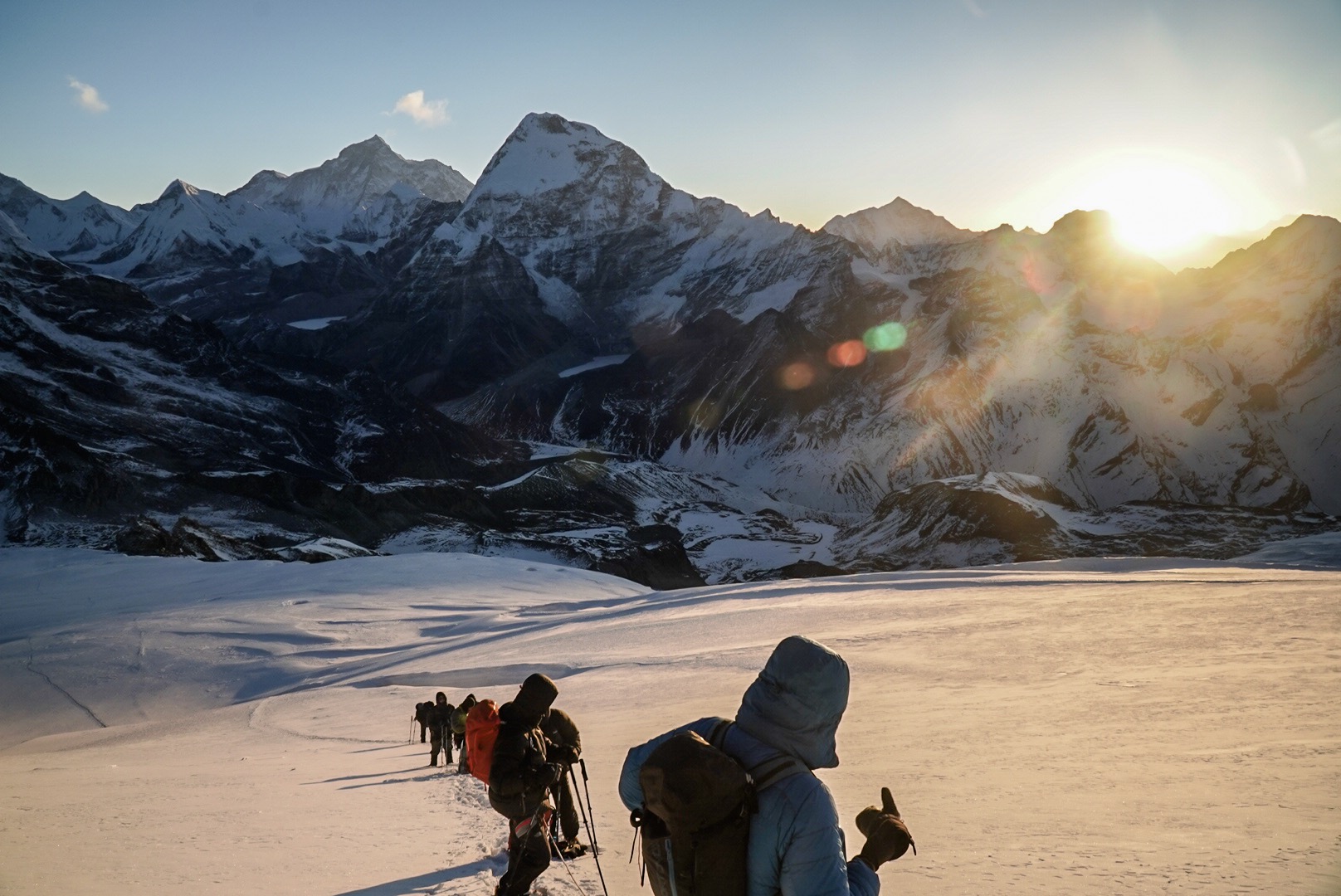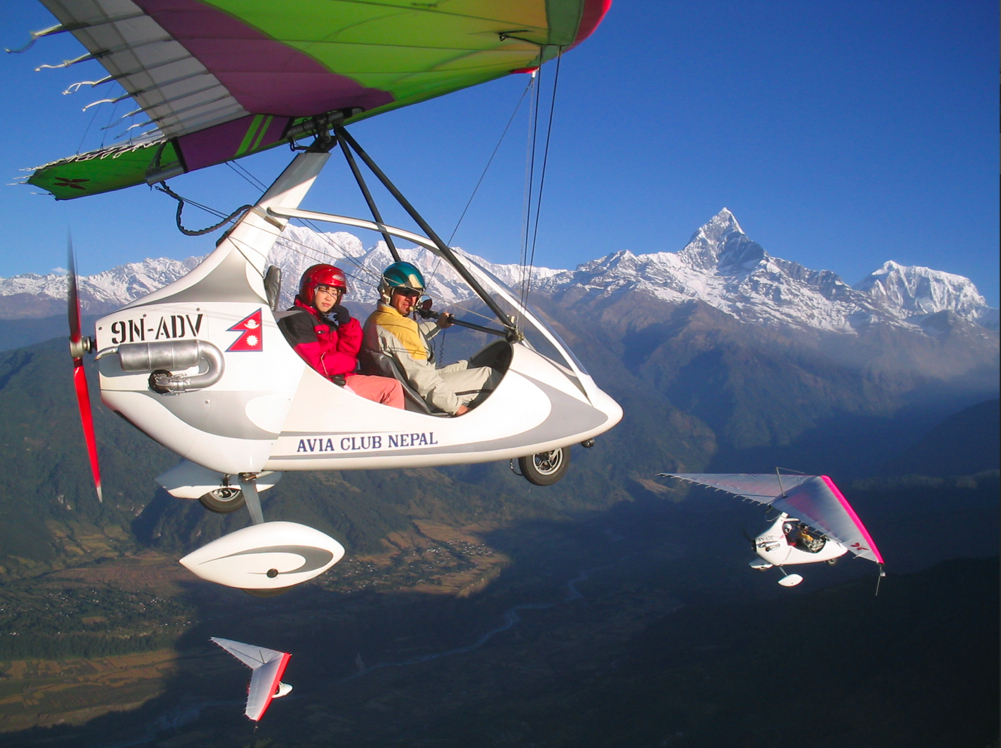Mera Peak Ski Expedition. New possibilities in the Himalayas - Namas Adventure
Mera Peak Ski Expedition. New possibilities in the Himalayas
Mera Peak has been attracting high-altitude ski lovers and we can understand why. Although ski adventure has yet to be a fully commercial adventure activity in Nepal, foreigners seeking high altitude ski thrill adventures have been navigating the slopes of the Himalayas. Nepal has some of the highest mountains in the world and all the ski enthusiasts must be wondering why does Nepal not already have ski facilities in place? Poor infrastructure and lack of knowledge in ski sport and business models have been a foreign thing for Nepal.
But with changing time and the need for more adventure options rather than just climbing, ski sport has been gaining attention and particularly on the slopes of Mera peak. We would say it’s pretty high, wild and off-piste but that is what makes it attractive when planning a ski expedition in Nepal. Spring sees a lot of fresh snow which may make it an ideal condition to but the ones who have skied in the past, rather prefers planning skiing during autumn. With a good amount of both stable and fresh snow, skiing in autumn is much more enjoyable. We understand why Mera Peak attracts skiers as it has fewer objective hazards in normal climbing routes (i.e. crevasse, rock falls, avalanches) and the mountain has a wide section to climb or ski down making it much safer to ski compared to a narrow couloir. Our guide members who are not ski trained would always say that skiing down Mera would be so much fun and less tiring 😅. But yes ski Expedition in Mera is a new possibility adding new adventure activity in the Nepalese mountaineering scene. Nepal now has IFMGA certified ski-trained guides who can assist you in making the climb and shred down the slopes of Mera peak together. This will be one hell of an adventure for anyone planning their expedition. To top that up, you will be skiing down a peak higher than the whole of North America or Europe, how about that for a portfolio of mountains you have skied down. Skiers will have to be proficient and at least have 50+ hours of ski sessions with few high altitudes off-piste ski experiences.
Permits are a must ($1000 for 1 - 10 skiers) and an additional $100 per additional member. A separate Mera Peak climbing permit is also needed. Want to plan your next high-altitude ski expedition in Nepal? Email us at bookings@namasadventure.com to plan your adventure and our team will be more than happy to assist you and help achieve the Mera Peak 6476M summit and safely ski down Mera Peak.
Go dare great things. Live your story.
12 Important things to know about Khumbu three peak expedition, Nepal - Namas Adventure
12 Important things to know about Khumbu three peak expedition, Nepal
1. Which mountains does Khumbu Three Peak expedition include?
Mera Peak 6476M is one of the best climbing peaks suitable for all beginner/novice climbers. Even if you are an experienced climber who wants to enjoy a decent climbing holiday, then Mera peak still is a good choice. Located in Makalu Barun Valley, this peak offers one of the most perfect remote adventure holiday experiences. Trekking through the remote villages, rugged trail paths up and down the hills, through forest trails, and of course beautiful mountains all around.
Island Peak 6189M is one of the most popular 6,000M+ climbing peaks in Nepal. The climb is suitable for beginner/intermediate level climbers. The peak is actually an extension of the ridge coming down off the south end of Lhotse Shar. Imja Tse is a popular mountaineering objective for climbers in Nepal, with its standard climbing route having a difficulty rating of 2B.
Lobuche East Peak 6119M is another popular 6,000+ m climbing peak in the Khumbu region. This peak is also suitable for beginner/intermediate-level climbers. The peak is mostly used by Everest summit teams as one of the training/acclimatisation peaks before making attempting the expedition.
2. When is the best time to climb Khumbu Three Peak Expedition?
Khumbu three peak is best suited to climbing during two climbing seasons. Spring (March-May) and Autumn (September - November). Climbers can expect the spring season to be busier because of all major 8000M+ expeditions.
For experienced climbers, winter climb is still possible but this comes with a lot of uncertainties. i.e unstable conditions, tea houses may not be operational or even the ones operating won’t be well-stocked. Pre-arrangements will have to be made but that will also depend on the number of climbers.
3. Is it possible to shorten the Khumbu Three Peak Expedition?
Helicopter in Nepal
Yes, the trip can be shortened, but it will incur additional costs. After reaching the summit of the final peak, the climbers will be flown via helicopter from the final base camp or village. The cost of the charter will depend on the drop-off location and the number of passengers, with prices ranging from $4000 to $4500. Our team at Namas Adventure has established relationships with reliable helicopter service providers and is able to offer flexible options. Contact us for further information.
4. How much does it cost to climb Khumbu Three Peak? What does the cost include?
At Namas Adventure, the cost of the Khumbu Three Peak Expedition is $6250 per person. Our company offers premium, all-inclusive peak climbing services, so climbers can fully focus on their adventure without worrying about any logistics. With our experienced team, you can have a stress-free and enjoyable climbing holiday.
List of what’s included in your booking.
NMA Certified Sherpa Mountain guide
$300 Individual tip pool. Tip pool will be fairly distributed among all Namas staff members. (Guides, porters, drivers, hotel security, and staff). Guest may personally hand in extra tips to our guides and porters.
Namas Branded merchandise (Down Jacket, Cap, Buff)
1:2 Sherpa Guide: Client ratio
Cook and helping team at Base Camp and High Camp
40 Kgs per person
Arrival at hotel in Kathmandu
All trekking and climbing permits (Khumbu Region Permit and TIMS)
All internal-local transportation to and from the trekking trailhead
Breakfast, Lunch, and Dinner on trek and expedition days.
1 Pot of hot water every night
Hydration tablet, frozen foods at BC and high camps
Lodge accommodation during the trek
Porters
Arrival pick up and departure
Internal flights
Basic First aid kit
Welcome/Farewell leave Dinner
5. Are guides necessary for the Khumbu Three Peak expedition?
To obtain a permit for climbing all three peaks, it is mandatory to work with a registered local company and hire guides. We strongly recommend that beginner to intermediate-level climbers climb with guides for their safety and to maximize their experience. This expedition lasts for 30 days, and the climb will be physically demanding, so having experienced guides is essential.
When climbing the Island Peak route, you will be required to navigate through crevasses and cross ladders, and new challenges may present themselves each climbing season. Even experienced climbers or guides who prefer to venture into new routes will still be required to have a local guide accompanying them. Thus, legally, guide assistance is mandatory for climbing these peaks.
6. What is the best acclimatisation itinerary for the Khumbu Three Peak expedition?
Mera Peak high camp 6100M
Proper acclimatization is crucial for high-altitude climbing trips and expeditions. Our team, with its years of climbing-guiding experience and a deep understanding of scientific literature, knows that the body needs sufficient time to adjust to the environment after reaching a certain elevation.
On the Khumbu Three Peak climbing trip, we prioritize acclimatization through our carefully designed itinerary, which includes climbing the Mera Peak first wich is a non-technical high-altitude trekking peak. This approach allows your body to adapt to altitudes above 6400M and provides you with opportunities to experience alpine camping, admire the stunning Himalayan scenery, and build up strength for your summit attempt.
Once you have successfully summited one Mera Peak, your body will have already adapted and be prepared for the challenges of the remaining 6000M peaks on the itinerary.
7. What training is required to climb the Khumbu Three Peak expedition? Can you suggest to me a training plan?
The Khumbu Three Peak itinerary, although classified as a beginner to intermediate-level climb, should not be underestimated. The grading of mountains is based on both technical and physical demands. This expedition demands climbers to be in a very good physically and mentally. To ensure optimal preparation for the climb, it's recommended that climbers focus on endurance and strength training. This can include aerobic exercises such as long-distance running (15km to 20km) 3 to 4 times a week, cycling (1 to 2 hours), and hiking with an added weight of 10 to 15 kgs. More on our training mountain expedition blog.
Courses like beginner mountaineering classes are also a helpful tool. You will learn technical skills like climbing with a rope on 5/6 anchor points using ascenders, how to walk with crampons on ice, snow, and rock, and to be efficient with abseiling and overall gear safety checks awareness.
8. How hard is Khumbu Three Peak Expedition climb?
The Mera Peak is rated as 1B, while Island Peak and Lobuche East Peak are rated as 2B. (Alpine grading link)
The summit climb is considered the most challenging and physically demanding part of the trip. At high altitudes, proper breathing can be a struggle, but with proper acclimatization, hydration, and nutrition, the body can adjust and recover. Once leaving the base camp, climbers will be faced with the true alpine challenge, which includes steep ascents and descents on ice and snow surfaces. Each summit day may last up to 10 or more hours of walking, climbing, and descending. The summit day usually begins early in the morning, with the goal of reaching the summit or as close to it as possible by sunrise.
To successfully complete the Khumbu Three Peak Expedition, a strong endurance and physical stamina is required. All previous training, willpower, mental strength, and a passion for adventure will be put to the test during this grueling, yet rewarding journey.
9. What are the clothing and gears - boots required for Khumbu Three Peak expedition (trekking and mountaineering)? Can I rent gears for Khumbu Three Peak climb?
Selecting the appropriate gear is essential for a successful climb. It is recommended to prioritize quality and comfort in your clothing and gear choices. Adequate layering is crucial, especially during nighttime when temperatures can drop below -10/-15°C. For our recommended clothing and gear, please consult our equipment blog.
For our Namas Adventure clients, we offer gear rental services that feature top-quality, well-maintained equipment from Kailas. Hiring gear from other local sources in Nepal is not recommended as we have found their equipment to be of subpar quality.
Investing in high-quality gear such as boots (trekking and mountaineering) is highly encouraged. With advancements in technology, climbing shoes have improved, and we suggest double-layered options such as La Sport G2Sm or Scarpa Phantom. Spending on good quality gear is a wise investment, as it can greatly impact the success and safety of your climb.
10. What types of foods are available during Khumbu Three Peak climb? Is clean water available and how much water intake is recommended?
Mineral water is readily available for purchase at most tea houses. During alpine camping, we will boil ice to produce drinking water that will be collected by our kitchen team. It's recommended that clients drink 4 to 6 liters of water daily to maintain proper hydration and acclimatization. We suggest taking hydration tablets or using a filtration bottle to ensure clean and safe drinking water.
Meals are typically prepared at the tea houses, and during climbing days, kitchen tents are set up by our Sherpa team. You can expect delicious food, but remember to eat enough, as at high altitudes the body may naturally resist food. Packed-dried meals are also available for those who prefer an alternative to the hot food being prepared in the tents.
It's important to avoid smoking and alcohol consumption during the climb. While you may observe our guiding leaders smoking or drinking, they are professionals who have adapted to high-altitude environments, unlike climbers who are there for adventure holidays.
11. What trip insurance will I need for this Khumbu Three Peak expedition? Do I need helicopter evacuation to be included in my insurance cover?
Helicopters are used for for any emergency evacuation in Nepal.
Having adequate insurance coverage is critical when embarking on a climbing expedition. Unexpected events, such as illness or altitude sickness, can occur at any time. For this reason, we strongly recommend purchasing insurance from one of our recommended providers (link).
In the event of an emergency, helicopter evacuation may be necessary. This is especially true in the Everest region where air transport is the only feasible option. Our guides will evaluate the situation and use their expertise to support and motivate you, but if a serious issue arises, helicopter evacuation will be initiated.
To initiate the evacuation process, we will contact the insurance company's emergency hotline for approval. The cost of the evacuation will need to be covered upfront but can be reimbursed upon returning home with the proper documentation, such as helicopter evacuation receipts and a doctor's certification letter.
Please note that there was a significant helicopter scam in Nepal in 2018, and insurance companies are now taking extra precautions to prevent similar incidents from happening. Our guides and staff in Kathmandu will also provide a briefing on the process for emergency evacuation and the necessary steps for successful reimbursement.
12. Which other high-altitude peak climbing can I aim for after Khumbu Three Peak Expedition?
Upon completion of your Khumbu Three Peak expedition, if you are looking to tackle even greater heights, we can recommend other peaks in the 7000M+ to 8000M+ range for you to strive for.
Ama Dablam Expedition 6810M
Conclusion
The Khumbu Three Peak expedition is an incredible and once-in-a-lifetime experience. Like all mountain climbing trips, this journey is well worth the effort. We hope that the information provided will assist you in properly preparing for your adventure. If you're seeking an outstanding climbing trip and want to have a fantastic time in Nepal, we would be thrilled to have you join us. Our professional and fun-loving guides, with 5-10+ years of experience leading peak climbing trips, will ensure that you receive quality services and have a great time. Our ultimate goal is to provide the best adventure experience in the world while prioritizing your safety and success on the summit.
Do you plan to climb and summit the amazing Three Peaks in the Khumbu region? If you do have any more questions, please ask us below in the comment section or you can email us at bookings@namasadventure.com and our team will get back to you as soon as they can.
Stay well. Challenge yourself. Dare great things and live your story.
Climb - Khumbu Three Peak link
Everything you need to know about Alpamayo climb - Namas Adventure
Alpamayo 5947M as seen from High camp.
Everything you need to know about Alpamayo climb
Alpamayo 5947M is one of the most popular and beautiful mountains to climb in the Cordillera Blanca range. This peak certainly attracts a lot of climbers from all across the globe and we can see why. Not only it is aesthetically eye-catching but the climb itself adds a technical climbing challenge in the vertical pyramid structure of the mountains.
1. Best time to climb Alpamyo
The best time to climb Alpamayo will be usually from June - September every year. Weather is usually stable during this time of the year in this region.
2. Which route and how long does it take to climb?
Namas team will climb through the Frech direct route. The entire trip takes 14 days once you land in Lima.
3. How much does it cost to climb Alpamayo? What does the cost include?
With Namas Adventure, the Alpamayo climb costs (Website - click here). We provide premium high-quality all-inclusive peak climbing services. Climbers do not have to worry about anything with our team and totally focus on their climbing holiday and fun times ahead.
Certified Mountain Guide (UIAGM – AGMP)
Transfer airport / 5* hotel / airport – Lima
City touring Lima
Bus ticket Huaraz / Lima, executive service in public bus-Movil Tours or Cruz del Sur
Transfer/bus station/5* Hotel – Lima
Transfer hotel/bus station – Huaraz in Hotel
Hotel In Huaraz, according to the program 04 nights. Double room with breakfast included
02 Nights Hotel in Lima / Double room with breakfast included
Tour of Acclimatization
Cook and Helpers
Porters (For Nevado Chopicalqui)
Donkey driver
Donkeys
Entrance fee National park Huascaran
Private transportation Huaraz / according to the program / Huaraz
Complete meals during the trek program and climbing program
Kitchen/dining tent
Cooking equipment
Collective technical equipment
Tent for 2 Person
Toilette tent
First Aid
4. Guides for Alpamyo?
All our guides are UIAGM – AGMP licensed guides who do have previous experience of leading clients and summiting Alpamayo successfully. You can rest assured of a safe climbing trip and fun overall experience.
5. Skills and Training required for Alpamyo
Alpamayo is one of the most technically challenging mountains to climb. Climbers must be proficient with technical mountain climbing skills. As an interested climber, you will need to be proficient with rope knot techniques and ice climbing skills. For strength building, we highly recommend climbers to focus on endurance and strength training. Any type of aerobic exercise, like long-distance running (10-15km) 3 to 4 times a week, cycling (1 hour - 2 hours), hiking gaining elevation with 10-15kgs weights on are some of the suggested training. More on our training mountain expedition blog.
6. How hard is Alpamayo climb?
Alpamayo mayo is graded 4D. The summit climb is rather more alpine-style climbing in a steep vertical section through ice and snow surfaces. The vertical climb to the summit is about 6 hours and descending back to base camp will be another 3 hours.
7. Climbing success rate?
Although there are no central statistical data records, it is estimated that only 50% of the climbers that attempt the climb actually summit.
8. Right clothing and gears- Boots (trekking and mountaineering)?
Choosing the right gear is very important. We advise climbers not to make compromises on the quality of gears and clothing, and to pay attention to layer up comfortably as well. You will highly depend on your clothes to keep you warm, especially during nighttime when temperatures can go down to -10/-15. Please check our equipment blog for recommended clothing and gear.
Boots (trekking and mountaineering) for Alpamayo
With better technologies, climbing shoes have improved every year. We highly recommend double-layered boots like La Sport G2Sm or Scarpa phantom. It is wise to spend on good mountaineering boots, as so with all the gears that we have mentioned in this post above.
Technical Ice Axe
This is a technical climb so technical ice axes are best suited. Petzl Quark, Black Diamond Viper, Grivel North Machine are some of the technical ice axes we can recommend.
9. Combine with other 5000+M peaks and next climbing goals after Alpamayo climbing.
Quitaraju 6040M is right next to Alpamayo and shares the same high camp. For additional 2 days and (2-3 days) contingency day you can climb Quitaraju. If you can add more climbing days then we have Andes Three peak expedition challenge.
Quitaraju 6040M. Pic by - ehodgesphoto
After climbing, Alpamayo climbers should be confident and well prepared for further higher climbing in the Himalayas. 6000M - 7000M climbs such as Island Peak, Chulu West, Baruntse, Ama Dablam are some of the trips you can climb with the Namas Expedition team in Nepal.
Alpamayo is a very challenging and rewarding climb. Peru hosts several technical and non-technical peak climbing experiences. If you are looking to enhance your climbing experience then Alpamayo should be on your climbing goal list. Nevertheless, this climbing experience is for a lifetime to remember. Want to add Alpamayo in your summit list? You can climb with our team every summer.
If you do have any more questions, please ask us below in the comment section or you can email us at bookings@namasadventure.com and our team will get back to you as soon as they can. Stay well. Challenge yourself. Dare great things and live your story.
Climb - Alpamayo Link
Alpamayo 5,947M/19,512fT . The Jewel of Peru - Namas Adventure
Alpamayo 5947M as seen from High camp.
Alpamayo 5,947M/19,512fT . The Jewel of Peru
Overview:
Altitude: 5,947 M / 19,512 ft
Climbers experience level: Intermediate / Advanced
Climbing route: French Direct
Location: Cordillera Blanca, Peru
When to climb: June - September
Total no of days: 12 Days
Difficulty grading: 4D (Alpine grading info)
Accommodation: Camping
Aesthetically beautiful and a technically challenging peak to climb, Alpamayo is one of the most beautiful peaks in the remote region of the Cordillera Blanca mountain range in Peru. After 2-3 days of trekking from Huaraz climbers finally reach Alpamyo basecamp and then set up high camp finally preparing for the final climb. Sitting tall and beautiful at 5947M / 19512ft Alpamayo was considered as the “most beautiful mountain in the world”. (Alpinismo paper May 1966)
Challenges are what motives any climbers. It is not the difficulty that inspires the climbers but it's magnificent setting and climbing technicalities, everlasting snow-caps of the Cordillera Blanca, altitude features are what attracts climbers from all around the world. Alpamayo is relatively smaller than its neighboring peaks but overcomes this shortcoming by its breathtaking form. It actually has two sharp summits, North and South, separated by a narrow corniced ridge. This is a great high-altitude technical adventure!
Climbing Technicalities
Our chosen route is the French Direct route. 6-pitches of technical tool climbing on vertical ice wall of 50-65 degrees in angle, just below the summit ridge. Steep final pitch topping out on a narrow ridge where we continue to the summit. The descent requires establishing 8 rappel stations with V-Threads. Getting to this point requires hard work and solid mountaineering and ice climbing skills. Alpamayo is the perfect climb to integrate light alpine climbing techniques with high altitude mountaineering skills. After successfully summiting Alpamayo, climbers should feel ready to be a competent team-member on big alpine peaks around the world.
Everything you need to know about Mera Peak 6476M climb - Namas Adventure
Summit of MeraCancel Peak 6476M
Everything you need to know about Mera Peak 6476M climb
Mera Peak is one of the best climbing peaks suitable for all beginner/novice climbers. Even if you are an experienced climber who wants to enjoy a decent climbing holiday, then Mera peak still is a good choice. Located in Makalu Barun Valley, this peak offers one of the most perfect remote adventure holiday experiences. Trekking through the remote villages, rugged trail paths up and down the hills, through forest trails and of course beautiful mountains all around.
But before you embark on one of the most amazing adventures, we have listed 11 useful informations that will help you prepare for your Mera peak climbing expedition.
1. When is the best time to climb Mera Peak?
Mera Peak is best suited to climb during two climbing seasons. Spring (March-May) and Autumn (September - November). During both the season there aren’t as many climbers as other peaks such as Island Peak. So climbers can expect a low-medium number of climbers.
For experienced climbers, winter climb is still possible but this comes with a lot of uncertainties. i.e unstable conditions, tea houses may not be operational or even the ones operating won’t be well-stocked. Pre-arrangements will have to be made but that will also depend on the number of climbers.
2. Is it possible to shorten Mera Peak climb?
Mera peak climbing can definitely be shortened but this comes at an additional cost. At Namas adventure, we do provide these services for private client groups ( 2+ members). The shortest Itinerary we can make it up to is 10 days Itinerary. Extra charges apply of an additional $4000 - $4500 applies since we will have to charter helicopter services. Please contact our team for other flexible options.
3. How much does it cost to climb Mera Peak? What does the cost include?
With Namas Adventure, Mera Peak costs $3650/£2850/€3300 per person. We provide premium high-quality all-inclusive peak climbing services. Climbers do not have to worry about anything with our team and totally focus on their climbing holiday and fun times ahead.
List of what’s included in your booking.
NMA Certified Sherpa Mountain guide
$300 Individual tip pool. Tip pool will be fairly distributed among all Namas staff members. (Guides, porters, drivers, hotel security, and staff). Guest may personally hand in extra tips to our guides and porters.
Namas Branded merchandise (Down Jacket, Cap, Buff)
1:2 Sherpa Guide: Client ratio
Cook and helping team at Base Camp and High Camp
35Kgs per person
Arrival hotel in Kathmandu
All trekking and climbing permits (Khumbu Region Permit and TIMS)
All internal-local transportation to and from the trekking trailhead
Breakfast, Lunch, and Dinner on trek and expedition days.
1 Pot of hot water every night
Hydration tablet, frozen foods at BC and high camps
Lodge accommodation during the trek
Porters
Arrival pick up and departure
Internal flights
Basic First aid kit
Welcome/Farewell leave Dinner
4. Are guides necessary for Mera Peak?
To issue a permit for Mera Peak climb, you will have to go through a registered local company, for this purpose guides are hired. For beginner to intermediate climbers, we highly suggest climbing the peak with guides. The usual climbing route does have a crevasse and new hazards may appear every climbing season. Experienced climbers/guides who want to venture into new routes will still have to be assigned a local guide even if they don’t prefer them climbing with them. So, yes legally speaking guide assistance is required.
5. What is the best acclimatisation itinerary for Mera Peak climb?
On high altitude climbing trips like Mera Peak climbing expedition, it’s imperative that climbers acclimatize properly so that the body is well-rested, adapted, and stronger to climb even higher. With years of climbing -guiding experiences and well-known scientific literature, we know that our bodies need an adequate acclimatization period to adapt to the environment after gaining a certain elevation. With that knowledge and experience, our team has built up the following Mera Peak Itinerary.
On Mera Peak climbing trip, we make sure your itinerary has both Mera Peak base camp and high camp. Your body needs these adaptation periods when you are above 5000M+. This way you can experience alpine camping, enjoy the Himalayas all around you, and had gain enough strength to make your summit climb.
6. What training required to climb Mera Peak? Can you suggest me a training plan?
Mera Peak is by no means an easy climb even though we grade it as a beginner’s climb. Mountains are graded based on their technical and physical difficulties. For your training, we highly recommend climbers to focus on endurance and strength training. Any type of aerobic exercise, like long-distance running (10-15km) 3 to 4 times a week, cycling (1 hour - 2 hours), hiking gaining elevation with 10-15kgs weights on are some of the suggested training. More on our training mountain expedition blog.
Courses like beginner mountaineering classes are also a helpful tool. You will learn technical skills like climbing with a rope on 5/6 anchor points using ascenders, how to walk with crampons on ice, snow, and rock, and to be efficient with abseiling and overall gear safety checks awareness.
7. How hard is Mera Peak climb?
Mera peak is graded at 1B. (Alpine grading link).
If you are physically fit, then the final 2 days of your climb are the most difficult sections. Breathing is always a challenge at high altitudes but with proper acclimatization done ahead of time, staying well hydrated, eating properly, your body should recover and adapt to the altitude. Once you depart from Mera Base camp the real alpine challenge begins, mostly climbing on steep ice and snow surfaces. You will be walking for 4-6 hours to reach high camp. Summit day climb starts early (3 or 4 am) with the goal to reach the summit or near to the summit by sunrise. This will be the most challenging and rewarding part of the climb. You can expect to hike around 10+ hours on this day as you will have to summit and then descend back to Khare village. All your previous physical training, your will, mental strength, and your grit for real adventure will take you through this final day and to the Summit.
8. What are the clothing and gears - boots required for Mera Peak climb (trekking and mountaineering)? Can I rent gears for Mera Peak climb?
Choosing the right gear is very important. We advise climbers not to make compromises on the quality of gears and clothing, and to pay attention to layer up comfortably as well. You will highly depend on your clothes to keep you warm, especially during nighttime when temperatures can go down to -10/-15. Please check our equipment blog for recommended clothing and gears.
Renting your gears in Nepal? We provide gear rentals exclusively for Namas Adventure clients during our climbs. All the gears are in the best condition, clean, and highest quality. Kailas equipment provides all-out mountaineering gears. (Namas Equipment hire link)
If you want to hire it from other local sources in Nepal, our simple answer is NO. This is one of the most frequently asked questions mainly by beginner climbers. We have tested and tried several gears in Nepal and frankly, we do not recommend hiring here. We know it might seem like a huge amount of expenses to buy all the gears, but they are well worth it.
Boots (trekking and mountaineering) for Mera Peak
With better technologies, climbing shoes have improved every year. We highly recommend double-layered boots like La Sport G2Sm or Scarpa phantom. It is wise to spend on good mountaineering boots, as so with all the gears that we have mentioned in this post above.
9. What types of foods are available during Mera Peak climb? Is clean water available and how much water intake is recommended?
We suggest all our clients drink 4-6 l of water every day. Staying hydrated will also help you with acclimatizing properly. It’s best to take hydration tablets or filtration bottles with you.
Most of the foods are prepared in the tea houses and during your climbing days, kitchen tents are set up by our Sherpa teams. You do not need to worry about food but remember to eat enough. In the high altitudes, your body will naturally want to reject food or avoid using energy on anything, which includes eating too. You might have to force yourself with the first few couple of bites and then eventually your body will start accepting the food. We also provide packed dried meals, so that clients have other options should they not want to eat what’s being cooked in the tents.
Remember to avoid smoking and any alcohol intake. You might see our guiding leaders smoking or drinking but remember they are professionals and they have adapted very well to these environments compared to the climbers who go there just for adventure holidays.
10. What trip insurance will I need for Mera Peak climb? Do I need helicopter evacuation to be included in my insurance cover?
No matter how prepared you are, you never know when or how things might go wrong. You might be sick suddenly or not that we wish but there might be some incident, you might suffer from altitude sickness or anything we can’t imagine yet. So, for these reasons, it is always good to have insurance cover. Our recommended Insurance companies (link)
Helicopter evacuation is our final emergency option and we do recommend you have one in your insurance, as it is the only means of transport in the Everest region. Our guides will assess your condition and examine if it is a major issue. If not, they will use their experience to motivate and push you through your trip. However, in case of emergency, helicopter evacuation will be called upon.
There is a procedure to follow when calling for emergency evacuation. We will call the insurance company hotline, get approval with your insurance and only then helicopters are sent to the distress call location. You will have to pay for the evacuation in Nepal from your own pocket but once you are back home you can claim your money back. Make sure you collect helicopter evacuation receipts, certified doctor’s approval letter. The insurance company will ask for this evidence to back up your claim. There was a huge helicopter scam in Nepal during 2018, so insurance companies are taking extra measures to stop this from happening. Our guides and staff members in Kathmandu will also remind you of this process during briefings.
11. Which other high-altitude peak climbing can I aim for after Mera Peak climb? Can I combine other 6000M+ peaks with Mera Peak climb?
If you want to extend your trip and combine other 6000M peaks along with Mera peak, then we would like to recommend the following two other itineraries.
Mera Peak and Island Peak climbing
Island Peak is another 6100+ M peak that includes some technical climbing sections compared to Mera peak. To reach Island peak after Mera Peak climbers will have to climb via Amphu Laptsa Pass 5845M and then descend to Imja valley. Island peak is also known as Imja Tse peak (Local name).
Island Peak 6189M
This expedition program is the holy grail and the best possible introduction to Himalayan climbing - we ascend three beautiful 20,000 foot (6000+ meter) peaks which is one of the most spectacular settings in the world. Join this trip for great trekking, a rewarding cultural experience with the Sherpa people, and a challenging feat on climbing on Mera Peak (6,476M), Island Peak (6189M), Lobuche East (6119M).
Once you have completed your Mera Peak climb and when you feel like you want to take on higher peaks we can suggest other 7000M+ - 8000M+ peaks that you can aim for. Baruntse Peak Expedition 7129M, Himlung Himal Expedition 7126M or Manaslu Expedition 8163M.
Baruntse Base Camp 5300M
Mera Peak is one of the most exhilarating adventure of a lifetime. Like every other mountain climbing trip this is a worthwhile adventure. We hope the information we have provided above will help you decide/prepare in the best way before you embark on your Mera Peak climbing expedition. If you are looking for a great climbing trip and have an amazing time in Nepal then we would love to have you onboard for our Mera Peak climbing trip. You can be assured that you are provided quality services with our fun-loving yet professional guides who have 5 - 10+ years of taking clients on such peak climbing trips. After all we do aim to be the best adventure specialist in the world and you having a great time, being safe and summiting will always be our priority.
If you do have any more questions, please ask us below in the comment section or you can email us at bookings@namasadventure.com and our team will get back to you as soon as they can. Stay well. Challenge yourself. Dare great things and live your story.
Climb - Mera Peak link
Top 5 peaks for beginner/novice climbers in Nepal, Himalayas - Namas Adventure
Mera Peak
Top 5 peaks for beginner/novice climbers in Nepal, Himalayas
Mountain climbing is one of the most amazing adventure sports. People climb mountains because of many reasons. The adventure thrill-seekers would like to challenge themselves, some climb for the excitement, but for others, the desire to reach the top of the peaks in Nepal has been growing over years. The journey through valleys, mountain ranges, and highlands is a sight to behold as it makes you realize why people spend sleepless nights and challenge themselves to the achievement of a mountain summit. Beyond the breathtaking views, there are many reasons to get motivated to climb mountains. Mountain climbing also provides an opportunity for cultural exchanges and a chance to see how people from rural areas live. Overall, mountain climbing is a fulfilling experience where you can develop friendships, gain new skills, and open up your mind to new possibilities.
If you are one of those curious challenge-seeking adventure lovers, then it’s only natural for you to question, is mountain climbing safe? I do not have any previous mountain climbing experience, can I climb and summit particular mountains? You may have trekked to high altitude places like Everest base camp, Annapurna region, or hiked around the world and you naturally want to explore higher ground? You may want to summit Everest one day or even all the highest peaks around the world but do not know where to start? Or you finally have the time and motivation to at least give mountain climbing a try or there may be thousand other inspirations.
On this blog, we want to help you by suggesting the best 5 peaks suitable for beginner/novice level or even intermediate level climbers. We promise you, there’s no shortage of awe-inspiring moments, adventure thrill and challenges in any of the suggested peaks below. The summit days will be tough but that’s the beauty of peak climbing. After-all “The best view only comes after the hardest climb”
1. Mera Peak 6476M
Summit of Mera Peak 6476M
Overview:
Altitude: 6,476M / 21,246FT
Climbers experience level: Beginners/Novice
Type: Non-technical/High altitude trekking style climb
Location: Makalu Barun National Park
When to climb: March-May or September - November
Total no of days: 18 Days
Difficulty grading: F / 2-3 (Alpine/fitness grading info)
Accommodation: Tea house and 1-2 high camps above 5000M
What makes Mera Peak suitable for all beginner-level climbers is its non-technical climbing style. What do we mean by that? Simply put the climb does not need fixed-line ropes, ice-axes, ladders, or other alpine techniques to climb to the summit. It is a good old fashion uphill steep walk with your mountaineering boots and crampons on. You may need a little practice walking with your crampons on but once those boots are on you will soon get the hang of it. From Mera base camp to the summit you will be walking on ice and snowy surfaces. This will be the most challenging part of your entire itinerary. Mera Base camp is not included in many other operators’ itineraries but we believe it is the best approach when attempting to climb Mera Peak. This will give our climbers an extra day to rest/acclimatize at 5400M altitude. There is no point in rushing into the mountains, your body not being acclimatized properly, and having to abort your final summit push.
Mera high camp 6100M, is another highlight of this expedition. The camp is set up just in the shadow of what seems like a half-scrapped-off part of a mountain. Both Mera base and high camp expose you to alpine-style camping. Totally secluded just you, fellow climbers, and the alpine environment. (lots of snow and mountains around).
Once you start your climb from the high camp, the view of the surrounding mountain gets better and better and endless beauty. From the Summit of Mera Peak, you will have the most widest and beautiful views of the Himalayas because of its geographic positioning in the region. 8000M + peaks such as Mt. Everest, Makalu, Lhotse, Cho-Oyu and Kanchenjunga are visible. Other iconic peaks like Ama Dablam, Baruntse, Chamlang are also seen in the distance. Like every other mountaineering adventure, the entire climb is physically and mentally challenging. But once you are at the summit it is well worth it.
Ridge climb to Summit of Island Peak 6189M
Overview:
Altitude: 6,189 M / 20,305 ft
Climbers experience level: Beginners/Novice to Intermediate
Type: Semi-technical climb/Jummar
Location: Everest Khumbu Region/Imja Valley
When to climb: March-May or September - November
Total no of days: 20 Days
Difficulty grading: PD/3 (Alpine /Fitness grading info)
Accommodation: Tea Houses and Alpine camping at Island Peak BC and high camp
Island Peak 6189M, is one of the most popular peaks to climb in Nepal. Island peak climb shares an itinerary with Everest base camp and is included in the trip itinerary. Although this peak is slightly smaller than Mera Peak, the final Summit push is the final crux, an almost 90-degree vertical climb.
Island Peak, is graded as a semi-technical climb, by this we mean climbers will need to use fixed-line ropes to climb up the peak and abseil/rappel down when descending down the peak. Summit day is the hardest, as it can be very physically and mentally challenging for beginner-level climbers. There are wide crevasses along the route, so climbers will also have to use steel ladders (which will already be set up) from base camp to high camp/crampon point. This feature of the climb makes it one of the best climbing experiences to learn basics mountaineering skills and also gives climbers an understanding of the level of fitness needed when climbing bigger mountains. The summit ridge is very exposed and not many climbers can fit at a single time. Having stated that, once you are at the summit, you will be over-filled with the joy of accomplishment and the Himalayan views all around will make it a worthwhile accomplishment.
Setting eyes on Chulu West Peak 6419M in far distant.
Overview:
Altitude: 6,419M / 21,059 ft
Climbers experience level: Beginners/Novice to Intermediate
Type: Semi-Technical/Jummar
Location: Annapurna region, Manang District
When to climb: April - May or September - November
Total no of days: 18 Days
Difficulty grading: PD/3 (Alpine/Fitness grading info)
Accommodation: Tea houses and Alpine camping to Chulu West BC and high camp
Chulu West 6419M Peak, is another 6000M+ climbing peak in the north-midwestern part of Nepal. The peak is located in the beautiful region of the Annapurna region. Trekking through one of the world’s most beautiful trekking routes, climbers set apart to Chulu base camp from Ledar village to embark on their peak climbing adventure. The peak resides on the backdrop of the great Annapurna Massif range, Himlung Himal on the northeast and further is the great Manaslu peak.
Chulu West Peak climb is a semi-technical climbing peak, making it suitable for beginner and intermediate experience level climbers. With fewer technical sections, climbers will mostly depend on their endurance and physical strength while climbing. The climb is mostly on ice and snow terrain all the way to the summit. Once on the summit, climbers are given a glimpse of the great Annapurna Massif ranges and other surrounding peaks of Mid-western Nepal. Climbing peaks in the Annapurna region can be a different experience compared to the Everest region. If you want to go even remotely and enjoy one of the world’s beautiful trails, climbing a peak in the Annapurna region is an experience on its own. Chulu West Peak is the right option to go for climbers seeking fewer crowd options.
Summit Push to Lobuche East Peak 6118M
Overview:
Altitude: 6,119M / 20,072 ft
Climbers experience level: Beginners/Novice to Intermediate
Type: Semi-technical/Jummar
Location: Everest Khumbu Region
When to climb: April - May or September - November
Total no of days: 20 Days
Difficulty grading: PD/3 (Alpine/fitness grading info)
Accommodation: Tea houses and Alpine camping at BC and high camp
Lobuche East 6119M Peak, is another popular 6,000M+ climbing peak in Nepal. This peak is mostly used by Everest summit teams, as one of the training peaks before heading for Everest Expedition. The base camp is located just a day away from Everest base camp.
Lobuche East Peak is graded 2B, the same as Island Peak. Climbers will have to use assisted fixed-line ropes, descend using abseiling techniques, and should be comfortable on exposed terrain. The climb is mostly on snow, ice, and rock surfaces. The summit is narrow, exposed and Everest is visible from the summit, unlike Island Peak summit. The climb is a 60-70 degrees climb and can be somewhat challenging for beginner/novice level climbers. This can also be a perfect mountain to climb whatever your climbing goals.
5. Pisang Peak
Pisang Peak 6100M, Pic by Oleg Bartunov
Overview:
Altitude: 6,100M / 20,013 ft
Climbers experience level: Beginners/Novice
Type: Semi-technical
Location: Annapurna region, Manang District
When to climb: April - May or September - November
Total no of days: 18 Days
Difficulty grading: F\2-3 (Alpine/Fitness grading info)
Accommodation: Lodges and Alpine camping to Chulu West BC
Pisang Peak sits in the Manang district, Nepal. The peak is tucked just between Annapurna I and Manaslu. This is another 6000M+ Peak in the Annapurna region suitable for beginner/novice level climbers. This peak also falls in the Annapurna circuit trail and the climb starts after the beautiful Pisang village.
Pisang Peak is graded at 1B climb but has some technical climbing feature during the summit climb. Fixed line ropes have to be used when climbing. Climbers will have to navigate through rocky, ice, and snowy surfaces. Climbers will need to have a good fitness level when climbing as other peak climbing in Nepal.
Climb - Pisang Peak (Email us for private climbing inquiry)
If you do have any more questions, please ask us below in the comment section or you can email us at bookings@namasadventure.com and our team will get back to you as soon as they can.
Stay well. Challenge yourself. Dare great things and live your story.
Other related articles:
Mountaineering Boots for Mera Peak climbing - Namas Adventure
Mountaineering Boots for Mera Peak climbing
Investing in the right boots is a must for any high altitude mountaineering activities. We highly suggest all climbers to not cut corners while purchasing these essential life-saving equipment. Comfort, support while carrying heavy loads, grip while climbing and scrambling on ice/rock, crampon compatible, warmth, sturdiness and should give you the confidence to walk comfortably on horizontal slopes. We recommend you go to your nearest store to try it on and give it a feel on how you feel when trying on these boots. In the end, you should feel comfortable with those boots. We have listed three of our favorite boots which are suitable for Mera Peak climbing.
La Sportiva G2SM
La Sportiva G2SM is one of the most versatile mountaineering boots performing extremely well at 6000M - 7000M altitude. The boot with it’s double-layered system can withstand up to - 30C keeping the feet warm during climbing days. The boots have a sturdy and quality feel and have BOA lace system for ease of tying the boots. This is especially helpful when tightening boots in extreme cold condition. Simply rotate the wheel to tighten the grip and plug off to loosen the boot. It’s only downfall maybe, the BOA system will be hard to replace or fix if for any reason it gets damaged, unlike traditional lacing system. (Boot Review link)
Scarpa Phantom 6000
Lightweight and more streamlined double boot designed boot, Scarpa 6000 is built for any 6000M - 7000M peak expedition. Providing incredible warmth and grip for any high climbing expedition. For a detailed review of the boot, you can check out the blog here by climbing gear review. (Click here)
GTX Mountaineering Boots 5000m
With classic style Kailas GTX performs well in the rugged conditions. Lightweight, insulated (able to withstand up to -30C, all crampons compatible, these boots are suitable for 5000M+ to 65000M mountaineering activities.
If you do have any more questions, please ask us below in the comment section or you can email us at bookings@namasadventure.com and our team will get back to you as soon as they can.
Stay well. Challenge yourself. Dare great things and live your story.
Namas Adventure team.
Mountaineering Boots for Baruntse Peak 7129M Expedition - Namas Adventure
Photo by - Mark Horrell
Mountaineering Boots for Baruntse Peak Expedition
Choosing the right footwear is critical to climb and summit higher peaks. Baruntse Peak standing tall at 7000M + peak demands climbers to wear appropriate mountaineering boots, which must fill in numerous roles. Comfort, support while carrying heavy loads, grip while climbing and scrambling on ice / rock, crampon compatible, warmth, sturdiness and should give you the confidence to walk comfortably on horizontal slopes. We have listed boots from several brands which is suitable for your Baruntse Peak expedition.
La Sportiva G2SM
La Sportiva G2SM is one of the most versatile mountaineering boots performing extremely well at 6000M - 7000M altitude. The boot with it’s double layered system can with stand up to - 30C keeping the feet warm during climbing days. The boots has a sturdy and quality feel and has BOA lace system for ease of tying the boots. This is especially helpful when tightening boots in extreme cold condition. Simply rotate the wheel to tighten the grip and plug off to loosen the boot. It’s only downfall maybe, the BOA system will be hard to replace or fix if for any reason it gets damaged unlike traditional lacing system. (Boot Review link)
La Sportiva Baruntse
The name itself suggest this boot particularly for Baruntse and any other 6000M-7000M peak expeditions. A sturdy built mountaineering boots specifically designed for high altitude mountaineering expedition. It is a double layered boot highly insulated boot with with tradition lacing style system. (Boot review)
Scarpa Pthanom 6000
Light weight and more streamlined double boot designed boot, Scarpa 6000 is build for any 6000M - 7000M peak expedition. Providing incredible warmth and grip for any high climbing expedition. For a detailed review of the boot, you can check out the blog here by climbing gear review. (Click here)
8000M Boots
For any climbers looking ahead for bigger expedition in near future, investing right away in a 8000M expedition can be a great idea, saving any extra expenses. Climbers normally use 8000M peak boots even during 6000M + expeditions. (Kailas Everest, La Sportiva Olympus Mons cube, Scarpa Phantom 8000)
Investing in a right gear is a must and a necessity when taking upon such great expeditions. We always advise our climbers to try them on when buying one and see which you feel most comfortable with, at the end it is your climb. If you want to take upon 7000M + peaks like Baruntse with Mera Peak expedition or Himlung Himal expedition , Namas team is here to be at your service and help you summit these amazing peaks while having a great time.
If you do have any more questions, please ask us below in the comment section or you can email us at bookings@namasadventure.com and our team will get back to you as soon as they can.
Stay well. Challenge yourself. Dare great things and live your story.
Namas Adventure team.
Himlung Himal 7126M Expedition strategy - Namas Adventure
Himlung Himal 7126M Expedition Strategy
Himlung Himal (7126M) is one of the most accessible peaks in the Himalayas (Nepal). Located just between North of Manaslu 8163M and the Annapurna Himalayan range, Himlung is a peak for any mountaineering enthusiast looking to climb a 7000M peak that is remotely situated and provides all the aspects of challenging mountaineering adventure. As we prepare to plan for this expedition from 2021 onwards, we want to share our climbing strategy which was pioneered by Paulo Grobel along with Nepalese guides, paving expedition strategy routes (safer/enjoyable) for future climbers. If you are looking for an amazing time in the Himalayas, do join our expedition. Another amazing 7000M peak to consider is Baruntse Peak expedition.
Base Camp to Camp 1 (Co-ordinates: N 28° 45 384 E 84° 22 147)
The new base camp also called ‘French base camp’ is comfortable, with water nearby and sheltered from avalanches. The logistical challenge remains to pitch the camp as it seems a bit complex when crossing through the Pangir Glacier on big inconvenient boulders and the way up the moraine on the right bank is exposed to rockfall.
Our strategy will be to conduct 2 rotations between BC- Camp 1 and Camp 2 (weather conditions permitting) and then summit push from camp 2. Note - Camp 3 is an alternative solution but due to its risky nature, the lead guide will only strategize camp 3, if needed after assessing the situations in the mountain while on expedition.
Camp 1 6000M to Camp 2, 6200M (2X rotations target)
Access to Base Camp from Camp 1, is quite simple and very quick (2 to 3 hours) on a trekking terrain, with moraines and small valleys. The snow conditions may alter the progression, of course, but there is no slope subject to avalanches on the way up.
From Camp 1 heading on to camp 2, then traverse across a perched scree slope that leads to the side of the glacier. Following the side of the glacier (crevasses and disturbed terrain, rocks, and snow) until climbers can stand up on the flatter glacier, with big steps; a few twists and turns are needed. Depending on the season and the snow conditions, this part represents the trickiest part of the ascent. We continue up on the glacier, avoiding a few crevasses. We find suitable terrains to set up our camp on the ‘Glacier Camp’. It is pleasant and vast enough to welcome several groups. It seems subject to little, if any, risk of avalanche (to be verified depending on conditions). We climb with ropes attached together on the glacier, which shows little danger of falling into crevasses.
Camp 2, 6200M - Camp 3 (Optional)
Camp 3 is only a short distance (1 hour) away from camp 2. Heading to Camp 3 from Camp 2 is a comfortable reach, we climb by continuing up on the icy escarpment up to the last place before the ridge (a few ups and downs). Camp 3 remains an option due to its risky nature of being on the ridge. Guide members will only decide after inspecting/discussing amongst themselves whether camp 3 is safe and actually required. (to be double-checked under exceptional snow conditions).
Camp 2, 6200M - Summit 7126M - Camp 2 or 1
Final ridge to Himlung Summit.
The climb is long and cannot be reduced with an additional high camp. The first part of the ascent consists of reaching the pass across snowy slopes, a little bit steep (30°) and exposed. Fixed ropes are often installed by the lead guide and once we are past that, then the slopes become less steep, with a few flat bits.
After the crevasse opening, which is generally not a problem, the slope on the side of the ridge becomes steeper. This is the steepest part of the whole climb: about 400m at 30/35°. In hard/frozen snow conditions, there is a high risk of falling, so we install fixed ropes on this part as well. The route then reaches a less steep ridge, up to a flatter section before the small final slope.
After the summit, we descend down to camp 2 or camp 1. Then the next day we head to base camp, pack all our gears and celebrate our summit success, reflect and have a more joyous night, and prepare for the next day’s journey towards Kathmandu and thus ending our trip.
If you do have any more questions or want to join our yearly spring or fall Himlung Himal expeditions then please ask us below in the comment section or you can email us at bookings@namasadventure.com and our team will get back to you as soon as we can.
Stay well. Challenge yourself. Dare great things. Live your story.
More route reference: Paulo Grobel
Everything you need to know about Island Peak climbing - Namas Adventure
Everything you need to know about
Island Peak 6189M climb
Planning on climbing Island Peak 6189M?
Here is everything you need to know about climbing this most popular 6000M+ peak in Nepal. Since 2016 we have been leading climbing groups to Island Peak and with our suggestions, our clients have been successfully able to enjoy while achieving their summit success.
Photo by - Brad
1) When is the best time to climb Island Peak?
For most climbers, Island Peak is best suited to climb during Spring (March-May) or Autumn (Mid-September - October) on any given year. The weather during these times in the Himalayan region and most of the places in Nepal remains stable, which is perfect for adventure activities. Spring season is chosen for most of the 8000+M expeditions in the Everest region, so you can expect trekkers’ crowd on the trails. However, once you reach your Island peak camping site, you can see the numbers dropping down drastically as the majority of the people on the trails are there for trekking.
Winter climbing is still possible, but we recommend this for individuals with a vast amount of mountaineering experiences, almost at the pro athletes’ level. Temperature is very low and weather conditions are harsh. It can be down to -25/-30 C and winds can pick up to 60mph+.
2) Are guides necessary for Island Peak?
Without the help of Sherpa guiding leaders, we do not recommend climbing in the Himalayas, unless you are a mountain guide yourself. You will have to walk through support ladders with crampons on while crossing the crevasse openings. The final climb to the summit is a 90-degree vertical climb where you will have to use ascenders to climb all the way up to the summit. Climbing a peak is not just about reaching the summit. You also need to consider the effort on descending back safely which can be equally exhausting as this requires your full focus as well. You will have to use atc or figure 8 gears to descend below from the peak.
We do collect mandatory pre-tour tips, which include summit bonus, tips to all the staff members involved in your climbing, porters, assistant guides, airport pickup/drop off drivers, and hotel helpers/securities. We fairly distribute these tips based on the type and amount of work each member has performed. Additionally, if our guests want to make extra personal tips, then they are more than welcome to do so.
3) What is the best acclimatisation itinerary for Island Peak climb?
When we want to commit to climbing adventure at a high altitude, slow and steady is the right way. Our itineraries have been refined and designed by our guides with years of climbing and guiding experiences. What we have found in general is that our bodies need an adequate acclimatization period to adapt to the environment after gaining a certain elevation.
On Island Peak climbing particularly, we highly suggest taking 2 days of acclimatization at Namche Bazar and an additional 2 Days stop at Dingboche. We then make sure your itinerary has both Island Peak base camp and Island Peak high camp afterward. Your body needs these adaptation periods when you are above 5000M. This way you can experience alpine camping, enjoy the Himalayas all around you, and had gained enough strength to make your final climb.
4) What training is required to climb Island Peak? Can you suggest me a training plan?
Island Peak is by no means an easy climb although we grade it as a beginner’s climb. Mountains are graded based on its technical and physical difficulties. For your training, it is very hard to mimic walking on ladders like the ones you will come across when crossing the crevasse. We highly recommend focusing on endurance and strength training. Any type of aerobic exercise, like long-distance running (10-15km) 3 to 4 times a week, cycling (1 hour - 2 hours), hiking gaining elevation with 10-15kgs weights on are some of the suggested training. More on our training mountain expedition blog.
Courses like beginner mountaineering classes are also a helpful tools. You will learn technical skills like climbing with a rope on 5/6 anchor points using ascenders, how to walk with crampons on ice, snow, and rock, and to be efficient with abseiling and overall gear safety checks awareness. Beginner Ice climbing alone is another course that will help you with all the required skills.
Photo by jemappelleguillaume(flickr)
5) How hard is Island Peak climb?
Island peak is graded at 2B in difficulty. (Alpine grading link).
If you are physically fit, then the final 2 days of your climb are the most difficult sections. Breathing is hard but with proper acclimatization done ahead of time and by staying well hydrated and consuming enough nutrition, you should be able to cope with the altitude. When you finally come across the vertical wall, this will be your final challenge. On top of that, you will be walking for 4-5 hours by the time you reach at this point. All your previous training of endurance and strength training should have prepared your body to face those challenges.
6) What are the clothing and gears - boots required for Island Peak climb (trekking and mountaineering)? Can I rent gears for Island Peak climb?
Choosing the right gear is very important. We advise climbers not to make compromises on the quality of gears and clothing, and to pay attention to layer up comfortably as well. You will depend highly on your clothes to keep you warm enough for the dropping temperatures at nighttime which can go down to -10/-15. Please check our equipment blog for recommended clothing and gear.
Renting your gears in Nepal? The simple answer is NO. This is one of the most frequently asked questions mainly by beginner climbers. We have tested and tried several gears in Nepal and frankly, we do not recommend hiring here. We know it might seem like a huge amount of expenses to buy all the gears, but they are well worth it. You can even hire from the city you live in. Make sure they are the original products from well-known adventure gear companies. (North face, Mountain hardware, Kailas, etc.)
Boots (trekking and mountaineering) for Island Peak
With better technologies, climbing shoes have improved every year. We highly recommend double-layered boots like La Sport G2Sm or Scarpa phantom. It is wise to spend on good mountaineering boots, as so with all the gears that we have mentioned in this post above.
7) What types of foods are available during Island Peak climb? Is clean water available and how much water intake is recommended?
We suggest all our clients drink 4-6 l of water every day. Staying hydrated will also help you with acclimatizing properly. It’s best to take hydration tablets or filtration bottles with you.
Most of the foods are prepared in the tea houses and during your climbing days, kitchen tents are set up by our Sherpa teams. You do not need to worry about food but remember to eat enough. In the high altitudes, although the weather is extremely cold, your body will naturally want to reject food or avoid using energy on anything, which includes eating too. You might have to force yourself with the first few couples of bites and then eventually your body will start accepting the food. We also provide packed dried meals, so that clients have other options should they not want to eat what’s being cooked in the tents.
Remember to avoid smoking and any alcohol intake. You might see our guiding leaders smoking or drinking but remember they are professionals and they have adapted very well to these environments compared to the climbers who go there just for adventure holidays.
8. How long do climbers hike or climb every day?
On usual trekking days, you will be walking for 5 - 6 hours a day covering 10km - 14 km. But on the summit day, your climb could last up to 8 - 9 hours since it is advised to go as slow as possible, using the right amount of energy for the long duration and inhaling as much air as possible.
9. Everest base camp tips
Island Peak itinerary falls right in the middle of the Everest base camp trek. That’s why we have chosen to have it on our itinerary so that climbers can visit this iconic Everest base camp and see the great Khumbu icefall, the doorway to Everest climbing. See more on our blogs about Everest base camp tips.
10. What trip insurance will I need for Island Peak climb? Do I need helicopter evacuation to be included in my insurance cover?
No matter how prepared you are, you never know when or how things might go wrong. You might be sick suddenly or not that we wish but there might be some incident, you might suffer from altitude sickness or anything we can’t imagine yet. So, for these reasons, it is always good to have insurance cover. Our recommended Insurance companies (link)
Photo by - fwarrenphinney
Helicopter evacuation is our final emergency option and we do recommend you have one in your insurance, as it is the only means of transport in the Everest region. Our guides will assess your condition and examine if it is a major issue. If not, they will use their experience to motivate and push you through your trip. However, in case of emergency, helicopter evacuation will be called upon.
There is a procedure to follow when calling for emergency evacuation. We will call the insurance company hotline, get approval with your insurance, and only then helicopters are sent to the distress call location. You will have to pay for the evacuation in Nepal from your own pocket but once you are back home you can claim your money back. Make sure you collect helicopter evacuation receipts, certified doctor’s approval letter. The insurance company will ask for this evidence to back up your claim. There was a huge helicopter scam in Nepal in 2018, so insurance companies are taking extra measures to stop this from happening. Our guides and staff members in Kathmandu will also remind you of this process during briefings.
11. Which other high-altitude peak climbing can I aim for after Island Peak climb? Can I combine other 6000M+ peaks with Island Peak climb?
If you want to extend your trip and combine other 6000 M peaks along with Island peak, then we would like to recommend the following two other itineraries.
This itinerary takes you through the highest trekking Peak Mera 6476 M and then down to cross Amphu Lapsta pass. The route takes you down towards Barun valley where Baruntse Peak 7129 M peaks stand tall and towards Mera Peak, the highest trekking Peak in Nepal.
Island Peak with Lobuche Peak climbing
Lobuche Peak is another 6100+ M peak that is often used by Everest summit climbers as acclimatization peaks. The peak is just two camps away from Island Peak and is a great combination should you want to take upon two peaks at once.
This expedition program is the holy grail and the best possible introduction to Himalayan climbing - we ascend three beautiful 20,000 foot (6000+ meter) peaks which is one of the most spectacular settings in the world. Join this trip for great trekking, a rewarding cultural experience with the Sherpa people, and a challenging feat on climbing on Mera Peak (6,476M), Island Peak (6189M), Lobuche East (6119M).
If you want to aim higher after Island Peak towards 7000M+ peaks then Baruntse 7129 M, Himlung Himal 7126 M are some of the peaks climbing we would recommend. Just climbing Island peak won’t be enough, we suggest you climb more different technical and non-technical peaks in Europe around the alps if possible. Amadablam Expedition is another super technical and tough mountain we would like to recommend but you will have to be extremely great with your mixed climbing skills and be fit both mentally and physically.
If you are planning to climb Island Peak in any given year, we run climbing trips every year during Spring and Autumn.
Please click the link to be directed to Island Peak Expedition page.
If you do have any more questions, please ask us below in the comment section or you can email us at bookings@namasadventure.com and our team will get back to you as soon as they can.
Stay well. Challenge yourself. Dare great things and live your story.
Namas Adventure team
5 Things to know about Mera Peak climb - Namas Adventure
Descending down Mera Peak Summit
5 things to know about Mera Peak climbing
When is the best time to trek/climb Mera Peak?
March-May ( Spring ) and September - November (Autumn) is the best time to trek/climb Mera Peak.
Is Mera Peak suitable for beginner climbers and what kind of fitness do I need?
Yes, Mera Peak is a non-technical high-altitude trekking peak. To reach summit 6476M you do not need any special climbing skills with ropes, gears, and use of an ice axe. Mera Peak is a very popular destination for clients with little or no mountaineering experience. The mountain has fewer to non-technical challenges, there are 3-4 small opening crevasses during the climb but apart from that, the climb is straightforward. All climbers are recommended to partake in preparative fitness and altitude training before attempting an ascent. You should be able to carry 5-8 kgs of your bag pack, walk up and downhill every day for 15/16 days and be able to push yourself during the summit climb.
Physically for beginners, Mera Peak can be demanding. We highly suggest you train yourself well over 6 - 4 months before your trip. You will need good endurance and body strength. Aerobic exercises mixing with overall body strength-building routines should help you prepare physically for your trip.
Can I see Mt. Everest from Mera Peak?
From the summit, five 8,000m peaks are visible: Mount Everest, Lhotse, Cho Oyu, Makalu, and Kangchenjunga, as well as many other Himalayan peaks. The standard route from the north involves high-altitude glacier walking. The west and south faces of the peak offer more difficult technical routes.
How hard is it to climb to the summit of Mera Peak?
Mera Peak is classed as 1B alpine grade. When it comes to an expedition the more fitter and stronger you are, the better your chances of successfully climbing to the summit and most of all enjoying the expedition. Summiting Mera Peak mostly depends on the weather condition and your fitness level. The climb normally starts around 3/4 am in the morning and it is about 3-4 hours climb to the summit. For any climbers it is a technically straightforward ascent, the main hurdle being proper acclimatization to the high altitude.
Which Mountain can I aim for after Mera Peak that’s above 6500M?
If you have got time and you are feeling extra adventurous then you can either Mix Mera Peak with Island Peak, which takes you through a beautiful and challenging Amphu Lapsta pass. On the way, you will also come across Baruntse 7129M and Makalu 8481M. Or you can simply take on our challenge of three 6000M+ Peak expeditions. (Mera, Island and Lobuche East) Peaks (Click for expedition Link)
Our main suggestion is to take it one step at a time. The lure of Everest is there but taking small steps, gaining the right experience, and understanding your physiology is very crucial for climbing higher mountains. Amadablam 6810M, Baruntse Peak 7129M, Manaslu 8163M, Tilicho Peak 7134M are some of the 7000M+ - 8000M+ Peak expedition we operate and organize at Namas adventure.
If you do have any more questions, please ask us below in the comment section or you can email us at bookings@namasadventure.com and our team will get back to you as soon as they can.
Stay well. Challenge yourself. Dare great things and live your story.
Mera Peak or Island Peak - Namas Adventure
Mera Peak or Island Peak
Mera Peak or Island Peak? Which 6000M peak to plan when you first want to start climbing a peak in Nepal. Which is the peak best suited for my abilities or which peak should I climb? To make your decision easier for you, we have laid out the details of each peak, which will help you decide with your 6000M peak climbing. The other option will be to combine both magnificent Mera and Island Peak climb in your itinerary.
Mera Peak 6476 M
Mera Peak 6476M, highest 6000M trekking Peak in Nepal
Non-technical climb up to 6476M. No use of ropes, ice-axe, ascender, or ladders
Beginners/novice suitable peak
Base camp and high camp strategy
Located in the Makalu Barun region of Nepal
Remote and less popular compared to Island Peak
March-May (Spring) and September - November (Autumn) is the best time to climb this peak
360 Panoramic view of Nepal Himalayan range. Everest, Cho-Oyu, Makalu, Lhotse, and many other peaks are visible from Summit and descend to high camp.
Mera Peak is considered the highest trekking peak in Nepal. The trails break off from Lukla going in a different direction to the Makalu Barun region, which completely avoids the normal Everest trek trail usually packed by Everest base camp trekkers and climbers. So, you can expect less traffic from trekkers on Mera Peak trails. With the mountain itself is a non-technical climb, Mera peak can be a perfect mountain climbing experience for those climbers not wanting to use ropes or ascender/descender gears to climb to the summit. Simply rely on the guidance of your guide and your strength to climb the peak. Physically it can be demanding, as on your summit day you will have to ascend for 4-6 hours depending on your speed of climbing uphill. The view from the summit is awe-inspiring, as you will be able to witness a 360-degree view of the great Himalayas range. Everest, Lhotse, Makalu, Cho-Oyu, Kanchanjhunga, and other peaks are clearly visible right in front of you during clear weather.
Island Peak 6189M
The most famous 6000M climbing peak in Nepal
Technical climb with summit approach 90 degrees ascend. Use of rope lines, ascender, figure 8 to descend, and ladders to cross the crevasse gaps.
Beginners/novice technical climbing
Base camp and high camp climbing strategy
Located in Everest trail route, in Imja valley
Remote and most popular climbing and summited 6000M peak
March-May (Spring) and September - November (Autumn) is the best time to climb this peak
Narrow summit ridge and is also a perfect peak to learn technical climbing approach
Island peak shares the same trail as the Everest base camp route up to Dingboche. Island peak is the most popular and summited 6000M in the Khumbu region. Island peak is suitable for first-time beginner climbers and is a perfect mountain for climbers who wants to experience and learn technical climbing in the mountains. You will be using the steel ladders (like they use in Everest) to cross the crevasse openings and use ascenders on fixed ropes to climb onto the final steep section, a 90-degree vertical wall. When climbing you will be using ascender on the fixed ropes to climb all the way to the summit. Training will be given prior to your climbing by our Sherpa guiding team on all our climbing expeditions. Like any expedition, this peak is physically demanding and on your summit day from high camp, you will be climbing for 6 - 8 hours, depending on your speed of climbing.
Or, simply you can make it extra challenging by combing both Mera Peak and Island Peak itinerary. The beauty of this itinerary is crossing the Amphu Laptsa pass which is challenging and awe-inspiring.
Amphu Laptsa Pass 5800M
Arrival
Day 1 Kathmandu ( Equipment check, induction with Expedition leader )
Day 2 Lukla / Monjo
Day 3 Monjo / Namche Bazaar
Day 4 Acclimatisation day
Day 5 Namche Bazaar / Tengboche
Day 6 Tengboche / Dingboche
Day 7 Acclimatisation
Day 8 Dingboche / Chukung
Day 9 Chukung / Island Peak base camp
Day 10 IPBC / Island peak high camp
Day 11 Ascend to Island peak summit / Chukung
Day 12 Chukung / Lobuche East Base Camp
Day 13 Lobuche High camp 5600M (5 to 6 hours)
Day 14 Summit day 6118M / High camp or Lobuche village
(1 Day Contingency Summit day, in case of bad weather to summit Lobuche east )
Day 15 Gorakshep / Everest Base Camp
Day 16 Dzongla
Day 17 Gokyo Via Cho-la-pass
Day 18 Gokyo ri trek
Day 19 Macahharmo
Day 20 Macahharmo to Doles
Day 21 Dole to Namche Bazaar
Day 22 To Lukla
Day 23 Kathmandu
Day 24 Departure
Or Another option would be Island Peak and Lobuche East peak.
Three Peak challenge (Mera, Island, and Lobuche East Peak)
We have set departures for all three peaks every year. To book your Spring or Autumn climb please email our team or head to the relevant page on our website for detailed pieces of information.
If you do have any more questions, please ask us below in the comment section or you can email us at bookings@namasadventure.com and our team will get back to you as soon as they can.
Stay well. Challenge yourself. Dare great things and live your story.
Meet these Badass Nepalese Adventurers
Nims dai definitely caught the world’s attention with his, once in a lifetime, attempt of climbing 14 Mountains which stands tall at 8000M+ in 7 months, ( but he did it in 6 months and 6 days ). Yes, not a big deal for Nims dai, he could just chill for the remaining 24 days or could have just taken a nap in the high altitude in his shorts (Jokes). To my imagination, only Nims dai can do that :D. We CONGRATULATE him on this bold historical success.
I did have the honour to meet him during his early days when he was just starting to pitch around the community and raise funds, which at that time seemed impossible. But with his sheer determination and focus he has pulled it all off, and now it’s in the history as one of the greatest mountaineering events, and not to mention the world records.
If Nepalese deserves an Olympic standard honour, then Mountaineering sport is the category they dominate. Nims dai has rightly so, put the name of great Nepalese adventurers right back on the map. Nepalese athletes, especially in mountain climbing, don’t get their fair share of recognition and praise. Getting a sponsorship as an athlete is a distant dream to them, but rightly so some female athletes are now recruited by The North face. Kudos to TNF. However, in this article, I wanted to make sure we can shed some light to these outstanding individuals and present some of the great Nepalese athletes to all our readers. Hold your breath tight, as some of these achievements, which you may have never heard may seem out of this planet’s achievements but these are the records of the brave Nepalese.
Tenzing Norgay Sherpa - Tenzing Norgay Sherpa and Sir Edmund Hillary were the first 2 individuals to summit Everest, the highest point on Earth, inspiring the generation of mountaineers to come and the rest is history.
Nims Purja MBE: AKA Nims Dai - What can I say about Nims dai? He has shifted the human perception of what’s possible. What’s remarkable is he started Mountain climbing in his early 30’s and then at 35, he embarked on the world’s great adventure and inspired many. I believe Nims dai is bringing out a movie around Janaury 2020, so that is something to watch out for.
Kami Rita Sherpa - Still going strong and guiding clients to Everest. He holds the world’s most Everest Summit at 24X and he may yet continue breaking his own world records. 24 times to Everest is a no joke and he is the only one standing on this planet with that record.
Apa Sherpa - Apa Sherpa stands at 21X Everest summit. Apa thought 21 was a lucky number and decided to hang up his boots for mountaineering. He has his Apa Sherpa foundation funding schools in Khumbu region.
Babu Gauchan (First person to Paraglide from Everest) - Babu is another Nepalese that came out of no where. Ever smiling and honest, Babu never climbed any mountains prior to this bold feat. He just decided he wants to Paraglide from Everest and head to the Ganges in one single adventure. Yes, that’s why he is a bad ass and he did all this without any sponsorship, just a deal with a fellow mountaineer Lakpa Tsheri Sherpa, where Lakpa takes him to summit of Everest and Babu glides him down from Everest and together they kayak to the Indian ocean. I mean who does that, this is madness and bravery at adventure every level only Nepalese dares. Babu did it all for the sake of adventurers. Babu and Lakpa were awarded People’s choice adventurers of the year (2012).
Let’s not forget the Female Adventurers
Pasang Lhamu Sherpa: Late Pasang Lhamu Sherpa was the first-ever Nepalese woman to summit Mt. Everest and she is a national icon for all the Nepalese. She paved the way and inspired many female adventurers globally and nationally.
Lhakpa Sherpa - What’s so astonishing story about Lhakpa's story is being the female athlete with most summit Everest ( 9 times ) She works as a dishwasher in Connecticut. No sponsors, trainers or any brand deals of any sort. I mean common has the adventure community totally missed out on her. This is why I say Nepalese are very underrepresented and it seems like Female athletes are left behind even further. The Northface, Mountain Hardwear, Arc'tyrex or any adventure brands here is an opportunity.
Pasang Lhamu Sherpa Akita - Pasang is one of the first Nepalese women to Summit K2, Everest and Amadablam. She is an inspiring figure and a humble mum. I met her on Everest trek trails and she was carrying her son all the way to Everest base camp and he was totally loving it. Guess we know already who the next generation of Nepalese mountaineer is!?
Dawa Yangzum Sherpa - Dawa is one of the first Nepalese athlete to represent from The North face. Kudos to North face, again. And she is one of the three Nepalese ladies team, to Summit K2. Dawa has further gained her recognition by being the first Nepalese female to summit Makalu and Cheki Go. One inspiring female adventurer to watch out. She now guides clients in mountains as well as take on several mountaineering projects.
Mira Rai - What makes Mira Rai’s story so powerful is the background she came from. At age 14 she joined Maoist insurgency and later when the insurgency ended only after coming out from that did her career into Ultra running take off. Now an inspiring figure in Nepal, Mira inspires the world of runners globally. She is actively participating in Ultrarunning events around the world.
What’s more is 46 more Nepalese have summited Mount Everest from 5 - 20 times. One can argue that Nepalese has to work hence they have to summit but if we look solely from the feat of climbing Everest then there is no argument that Nepalese beat this record by miles. (Wikipedia list of Everest Climbers)
There are more young Nepalese adventurers coming along the rank with Mingma David Sherpa being the youngest person in the world to summit all 14X8000 M peaks. He was a part of Nim’s Dai Bremont Project possible climbing team.
Nepalese will continue to work in the mountains and keep building on the records, with or without sponsorships from big brands. Their work is in the mountains but if big brands could back them up with sponsorship, more young Nepalese will be inspired to follow their passion into the mountains who might better represent Nepal and explore other unclimbed peaks, raise the standard of Nepalese guiding team which is a great news for all the climbers who seek better local guides coming out of Nepal.
Article by - Bisesh
Namas Adventure
Baruntse Peak 7129M Expedition strategy - Namas Adventure
Baruntse Peak 7129M Expedition strategy
Baruntse Peak standing at 7129 M mountain is situated in Nepal between Mount Everest and Makalu in the Barun-Makalu National Park. Mount Baruntse is a substantial and symmetrical snow peak, has four ridges and four summits. It is bounded on the east by the Barun Glacier flowing north-south from Cho, to the north-west by the Imja glacier and the Hunku glacier forms the south-east boundary. The three main ridges of Baruntse are situated between these glaciers and form an upturned ‘Y’running from Cho Polu (6695m) in the north past the Humni La, on to the north summit where it divides. Other well -known mountains in this area are Makalu, Lhotse, Chamlang, Everest, and the trekking-peak Mera Peak.
Bruntse was first climbed on 30 May 1954 by Colin Todd, Geoff Harrow of the Hilary New Zealand Expedition. They have climbed the mountain by the southeast Ridge. Since then many climbers have used this route and succeeded. This mountain has also been becoming coveted day by day like the other Pumori, Ama Dablam as well as Everest too.
Expedition Route
The south-east Ridge of Baruntse is a straightforward climb, mainly on snow but at high altitudes and crossing some steep sections of ice at 50°, with a prominent ice cliff at about 7,000 meters to be climbed on the way to the top. Sections of the upper summit ridge can be corniced, but there is little evidence of avalanche risk on the lower slopes of the mountain. The most successful ascents have been made in the spring when snow conditions have been good and the mountain has been found to be objectively safe at this time. There is still a debate on which season it is best to climb Baruntse as in the past few years 2013 - 2018 more summits have been done during the Autumn season. The steeper sections of the climb are safeguarded by fixed rope, as are the obvious cornices that need to be traversed between the camps on the mountain.
Expedition Strategy
Acclimatizing at Mera Peak 6476 M
Baruntse Base Camp (5640 M)
Baruntse expedition route
After summiting Mera Peak, the team heads towards Baruntse Base Camp 5460M. 500m descent down into the Honku valley climbers is assured with rich oxygen, warm weather, and sunny spell making good conditions for a good night's sleep. The natural environment around is utterly desolate and utterly magnificent in its desolation.
Baruntse base camp is at 5460M, a few kilometers further up the glacier at the entrance to the valley which gives access to East Col. From a camp set up immediately below the pass, it is easy to cross East Col to West col and reaching Camp 1 (6,146 M) at a large snowy plateau, on the Lower Barun Glacier. This places the expedition team immediately below the South-East Ridge of the mountain and provides a suitable spot for Camp 2 or Advanced Camp 2 (AC2). This plateau could be reached directly up the Lower Barun Glacier but this approach is not recommended as an icefall at the toe of the glacier has made the route impassable in previous years. So a different strategy where one more camp higher on the mountain, at about 6,500 M is placed, from where the summit is attempted.
The team will practice ascending fixed ropes and rappelling on steep, icy terrain. Hike glacier just outside of camp and spend a few sessions perfecting skills on overhanging ice. Meanwhile, the Sherpa team will be fixing ropes high in the mountain for the team. Additionally acclimatization hike to the base of the fixed lines below camp 1. The hike features dirt trails, scramble over rocks, and crossing the beautiful glaciers. The day is spent training and preparing for the expedition just below Baruntse peak and then head back to Baruntse base camp.
Puja Day Ceremony ( Rituals ) Base Camp - West Col - Camp 1 (6100 M) Approx 10 hours
Photos by - David
A Puja ceremony, rituals are performed praying and asking permission to the god mountain for safe passage, success, and safety of the team in the morning, which is customary before beginning a climb. Many of the western climbers participating takes part by placing an object to be used in the climb - an ice axe, crampons, boots - on an altar that was made from stones and adorned with Tibetan buddhist prayer flags. The ceremony is concluded with readings and ritual blessings.
Guiding Sherpa leader teams fix the rope on all the main difficulties of the summit ridge. Sherpas set up the safest way through the crevasses, overhangs, and icefalls.
Sirdar Sherpas team carry loads from basecamp at 5400 meters to camp 1 at 6100 meters and then returned to basecamp. The climb mostly consists of a moderate climb with steeper sections at the West col which is the final ascent before reaching Camp 1. Only the last part is more difficult, where the west col consist, 45 degrees 200-meter high ice wall. Beautiful views on the surrounding mountains: Ama Dablam, Baruntse, Makalu, and the Amphu Lambtsa La which all the climbers will have to cross in a few day’s time when returning to Lukla.
Clients are meant to carry their personal loads 8kgs - 12kgs throughout the climb.
Camp 1 - Camp 2 (6,400M) or Advanced camp 2.1 (6,500M) | Time approx: 3 - 4 hours
Photo by - Matthew D Thornton
Camp 2 (6,400M) or advanced Camp 2.1 around 6,500m, in a small col between Baruntse 2 and Baruntse itself. Baruntse 2 is also called Baruntse south-east. The camp lies between the two summits in a saddle-like slope.
Camp 2 - Summit Push - Back to Camp 2 or 1 | Time approx: 10 - 12 hours
Technical Challenges at 6900M ridge
Pic by - Karvaniers
Very sharp ridge at (approx 6900m). The sharp ridge provides excellent ice climbing over several steep ice walls and extremely exposed cornices. Sherpa team fixing the rope will assess the crevasse opening ridge and there is a consideration of adding a ladder at the top if needed. But normally combining the skills of ice climbing on overhanging ice and through the assistance of fixed rope walking on the narrow steep wall ice wall climbers can overcome the final section of the ridge, then a further 60 - 90 min climb to reach the summit. The summit hosts some of the best views of Everest, Lhotse, Makalu, and Cho Oyu that can be seen anywhere in the Himalayas.
Making it to the summit is 60% job done. Descending is one of the grueling parts of climbing parts of mountain climbing. From there the descendant with all the abseiling skills will demand the climber’s full attention. So, climbers can celebrate their moment at the top. If weather permits and stays are non windy then climbers might be able to enjoy 30 - 60 min of a celebratory moment with the panoramic view Himalayas. But normally our Guiding team will advise the climbers when to descend down. It’s best to celebrate and at the same time refuel and gain some of your energy back to be able to descend back to camp 2 or 1 safely. A lot of the mountain incident happens on the way back while descending.
Amphu Lapcha Pass 5800M
After summiting Baruntse mountain, the journey back still hosts more surprises, and before climbers reach to next civilization at Pangboche. Morene country, over boulders, passed lakes to the foot of the beautiful Amphu Lapcha. Amphu Lapcha hosts zigzag glaciers with base camp at North and south where we have to stop for a camp night. From Amphu Labtsa pass grants us views of Imja Valley, Everest, Lhotse, Nuptse, Island peak, Ama Dablam, Baruntse, just awesome.
Advice to climbers keen on climbing Baruntse Peak
Enthusiast climbers will definitely have to prepare themselves for technical climbing. On the last 250- 300 meters of altitude, the climbing gets rather technical. Route fixing guides/Sherpas have to take a large number of ropes to fix the way. Baruntse is not for novices climbers. Climbers need to have some experience at least. Climbing experiences on both the alps, Andes mountains, and the Himalayas is necessary. Climbers with some experience in mountain climbing it is another great experience to climb Baruntse to further bag and gain a lot of knowledge in mountaineering.
If you do have any more questions, please ask us below in the comment section or you can email us at bookings@namasadventure.com and our team will get back to you as soon as they can.
Stay well. Challenge yourself. Dare great things and live your story.
Further Source:
New Mt. Everest expedition rules 2019
Mt. Everest
We all know the news of Everest casualties during this year’s (2019) expedition. 11 climbers deaths, 9 from Nepalese side and 2 from Tibetan side. Nepal issued a record number of 381 permits issue this year. There has been conflicting ideas on why climbers died. Traffic jam near the Hillary ridge ( above 8000 M ) was pointed out by many but just that one problem does not address the key issue of the expedition. A lot has to do with inexperienced climbers, exhaustion, altitude sickness, incompetent/inexperienced guiding team and cheap expedition. This has been pointed by many experienced sherpa climbing leaders ( Kami Rita Sherpa, 24 Summits) as well as non-Nepalese veteran climbers.
Rules from Tibetan side of expedition are strict compared to the Nepalese side. Climbers requires a proof of having summited one 8000M peak before they can climb Everest from the tibet side, where as in Nepal rules were climbers should have climbed at least one 7000M peaks.
Photo by- Nims Dai / Nirmal Purja 2019 Project possible. Everest expedition.
Nepal’s ministry of tourism has proposed new rules and regulation to tackle issues in response to this years incidents. Also, this has to be passed through parliament first for the rules to come into effect for 2020 spring expeditions. New rules are focusing on operators, climbers and government officials at Everest base camp and the route. The government is also considering requiring mandatory health checkups at Everest Base Camp.
Climbers must prove ( certificate mostly ) that they have at least climbed one 6500 M Nepalese peaks before.
Climbers must also submit a certificate of good health and physical fitness and be accompanied by a trained Nepalese guide.
Expedition company must prove that they have 3 years of experience organising high altitude expedition before leading clients to Everest.
Minimum charges of Everest expedition $35000 per bookings ( $11000 permits included) to be charged. * Cheap Everest expedition were blamed by most of the Sherpa leaders for attracting in-experienced climbers.
Minimum charges of $20,000 for any expedition above 8000M+
Climbers attempting 8000M+ peaks to undergo basic and high altitude climbing training.
Other ideas passed on
improvements in the rope fixing process, primarily with respect to getting the ropes in earlier and some type of improved weather forecasting system
Theft of oxygen cylinders during the expeditions
Traffic monitoring at base camp and higher camps.
So, does this mean the quality of expeditions will improve dramatically? Maybe yes and No. The challenge has always remained with Everest expeditions and the traffic or long queue is not a new news. There has been rise in number of climbers since 1990 and only looks to grow.
The ideas proposed seems to just address the issues vaguely and does not take into account of finding solutions whole heartedly. Certainly expedition companies has to be more responsible when taking inexperienced clients to these extreme altitudes and government implementing tougher rules & regulations can be one way. Regulators needs to listen to experienced veteran Nepalese and non-Nepalese climbing leaders, operators, mountaineering community and boards on how to increase the quality and safety of Everest expeditions. It is no easy fix and the challenge will always remain but the obvious issues (like inexperience climbers or teams ) should be tackled with strict rules and implementation.
Everest is an optimum challenge we as an individual can choose to face. We support and encourage you on your aspiration to endeavour on taking the journey of the highest challenge that man kind can face. But all we ask is taking a route that protects you and your team, enriches you with the experience of alpinism and eventually fulfilling your aspirations.
* Cheap expedition - Discounted Expedition were ran on as low as $20,000 p/p which dramatically reduces
and impacts the quality of the expeditions both for the individuals and the operating team.
Nutrition for Mountain climbing - Namas Adventure
NUTRITION FOR MOUNTAIN CLIMBING
Image- Namas Adventure, Mera Peak summit
Climbing high altitude mountains for both sports and recreational purposes is an immense physical challenge. Altitudes above 4000M to 5000 M are considered high altitudes and 5000M above are considered extreme altitudes. You have to be physically, psychologically, and mentally prepared. Preparing yourself by exercising and practicing techniques, getting the right gears are important parts of mountain climbing. However, to be able to make yourself stronger during training and climbing days getting the right nutrition is very important. Did you know that taking the right diet can improve your effort ability by 20% overall? It is easier said than done but when it comes to mountains and high altitude you might want to dedicate yourself to this regime of the right amount of exercise to make you physically fit and eating well. The right nutrition is another factor in your performance.
“ Did you know that taking the right diet can improve your effort ability by 20% overall”
Image by - Brad
Research has shown that when climbing high altitude mountains climbers can burn anywhere from 6000 - 10,000 calories per day. Losing weight is very normal and you will have to gain your strength back quickly. Your digestive system won’t work the same way as it does at a lower altitude. Your system will want to reject food as it does not want to put in much effort and forcing yourself to eat is necessary. Carbohydrate (carbs) is your best friend when it comes to nutritional value but also do not forget the proteins and fats. You will have to snack a lot with easy-to-absorb carbs, hydrate often, during your climbing hours, and when you rest during dinner at your camps more carbs and proteins. Fill up that glucose in your body as it stores fats in your body which your body will use when needed or during the hard push.
“60% - 70% of your meal nutrition should be carbs, 20-30% proteins and 5% - 10% fats”
Recommendations
High carbohydrate foods - Rice or whole grain products, bread, pasta, fruits rich in natural sugar ( banana, oranges, blueberries, grapefruit, apple) sweet potatoes, potatoes, milk, Quinoa, kidney beans & chick peaks.
You can also pack dried frozen dried meals that are easily packable, 90% lighter, preserve the natural taste, gives you nutritional value. Easy to prepare, just pour boiling water, stir and wait about 10 minutes, and feast on it. This is highly practical as it makes logistical planning much easier. We recommend (LYO FOODS) they have some great options, especially for mountaineering.
Proteins sources mile & cheese, meats, tofu, eggs, lentils and seeds, and nuts.
Fats source dried meats, butter or ghee, chocolate, olives.
Keeping yourself hydrated throughout is very very important. You will sweat a lot, we recommend you to intake anywhere from 4l- 6l of water every day. Just drinking normal water is not enough. It is necessary to add hydrating tables with electrolytes in your water. Products recommended ( SIS hydration tablets, Nunu Hydration tablets )
Mini brunches when hiking/climbing for 6- 10+ hours is very crucial. Your body quickly burns all the nutrition within 2-3 hours and you will need to often replenish those nutrients. You will need foods that don’t have to be cooked, easily packable, and rich in nutrition. Bananas, chocolate, nuts& seeds, jerky or dried meat, hydration tablets, energy gels, and bars are highly recommended. Every night prepare it in a sealed bag or an area of your backpack where you can store and reach them easily. These superfoods will give you that much-needed energy, thus, you’ll feel active for a longer time.
I hope this article was helpful. It is very important that you pay attention to your diet nutrition especially during your climbing days. Remember to take in a lot of carbs during your trekking/expedition lunch or dinner time. Snack a lot, almost like a mini brunch every 2-3 hours, to give your body a constant flow of energy and stay hydrated (add hydrating tables) every time. I personally have suffered during my climbing days for not eating well or not staying properly hydrated. So I hope you can follow the suggestion and enjoy your climbing. During your trekking/expedition on all our itineraries, meals with these nutritional values are served at the lodges we rest or during camping. Extra food is always helpful. Please ask our team how much you will need to personally pack.
One more thing, do not intake any alcohol, especially during your climbing days. You will see Sherpas or porters who have always been climbing drink but you need to remember that their bodies have always been through this every year in and out. So comparing it won’t help, instead, save it for the last and enjoy your beer after your climbing is finished when you return to base camp or the nearest lodging area.
Also, please carry your waste with you all the time and dump them on your next village or lodging spot. Encourage your team not to litter the mountains as the waste might never be removed from these remote and pristine areas.
Keep exploring, eat well take on that challenge. Mountains are calling. Go live your story.
References -
https://lyofood.com/blogs/lyofood-blog/nutrition-at-high-altitude?welcome
https://www.healthline.com/nutrition/12-healthy-high-carb-foods
Written by - Bisesh
Alternative routes to Everest Base Camp - Nepal
Alternative routes to Everest Base Camp - Nepal
EBC tour 2019
When it comes to Everest trails, the Everest base camp route is the one with the most adventurers from around the globe. In 2018 the region welcomed 57,000 travelers, which is only set to grow more and more in coming years. This is my third time visiting Everest base camp with my group and I can clearly see the trails getting busier every year. I get it, it is a bucket list for a lot of us, that is why we want to go there. Which I clearly admire and just seeing the mountains and taking up the challenge can be an inspiring adventure. But when it comes to the trails the busyness and the crowd is something you won’t be expecting, believe me especially if it is your first time. The great news is that there are alternative routes to go to Everest base camp apart from just the normal trekking route. The only trade-off is 4-6 additional trekking days in your itinerary but it will be totally worth it. You can avoid 70% of the crowd, will be more challenging than just Everest Base camp but more adventure for yourself.
(Click on image for more tour infos)
Gokyo with Everest Base Camp - 20 days
My first recommendation is the Gokyo trail with Everest base camp. Once we visit Everest base camp we break away from the rest of the group trails from Lobuche (Day 12). Taking you through Cho-la pass and then on to Gokyo valley. This trip sums up all the mesmerizing beauty of the Everest region. The Gokyo Lakes region at the head of the Dudh Koshi Valley provides a great alternative to the popular Everest Base Camp trek. It is a more tranquil trek through the Sherpa heartland that affords ample time for acclimatization with opportunities to savor mountain panoramas from our private permanent campsites. The highlight of the trek is our ascent of Gokyo Ri. From the summit, at over 5000m we gain superb views of Everest as well as the 8000m peaks of Lhotse, Makalu, and Cho Oyu in Tibet. Many trekkers will argue that this is one of the finest views in the Himalaya, with the awesome bulk of Everest dominating the skyline.
Three Passes Trek - 22 Days
Renjo la pass ( 5345M), Photo by- Tomislav Gracan
If you are up for a bit of a challenge crossing 3 passes in the Everest region, visiting the emerald Gokyo lake, and then finally arriving in Everest base camp then three passes are the right option for you.
The Three Passes Trek to Everest Base Camp is arguably one of the most challenging treks in the Everest region. The trek covers a lot of variation making a traverse between the three high passes, that is how it’s named – Renjo La, Cho La, and Kongma La – each over 5,000m. The trek begins at the famous Lukla and then heading towards the famous Namche Bazaar. Here, the route splits from the main trek and heads up the Dudh Koshi valley, where you will encounter the first of the Three Passes – Renjo La (5,370m). After reaching the high point, the trail descends to the turquoise Gokyo Lakes and further on to the village of Gokyo.
I hope this article helps you in making an informed choice about visiting the Everest region and you can make alternate plans when visiting the Everest base camp. There is no way to escape the crowd during the trekking season but the alternatives routes take you on a different trail that exposes you to other gems of Everest trekking tails, which 80% of the crowd visiting won’t be attempting.
If you do have any more questions, please ask us below in the comment section or you can email us at bookings@namasadventure.com and our team will get back to you as soon as they can.
Stay well. Challenge yourself. Dare great things and live your story.
7 remote trekking destination in Nepal - Namas Adventure
7 REMOTE TREKKING DESTINATION IN NEPAL
Photo by - Jackson Ho
Everest base camp and Annapurna region treks have rightly become one of the most popular trekking choices for travelers visiting Nepal. Why wouldn't it be? Firstly it's the charm of the world's greatest Himalayan ranges and secondly, it is easier to access these areas via flights to Lukla for all Everest trails and from Pokhara for all Annapurna trails. The momentum has only been building with rising adventure travelers coming to Nepal. 2018 was a great year for Nepal with the highest arrival to date of 1.2M travelers.
Visit Nepal 2020 is just around the corner and Nepal is seeking to welcome 2 million travelers which will be the first time in the history of Nepal's inbound tourism. With, Everest and Annapurna being the charm for most travelers we expect to see a significant rise of trekkers particularly in these trekking areas. I would say Everest base camp will be the most overcrowded and then following up to Annapurna base camp. In 2018, the Everest region saw 57,000 trekkers and the Annapurna region welcomed 1,73,000 trekkers, bearing in mind that the Annapurna region holds 5 major trekking trails. Annapurna circuit issued 28,060 permits in 2018. Annapurna base camp and Poonhill trek are the popular choices for most travelers.
So, it is only self-evident that the trajectory will rise and If I had to choose a trek in the Annapurna region then I would choose the Annapurna circuit. There are still fewer travelers compared to Annapurna base camp or Poon hill even with the rise in numbers in 2018. The traveler ratio is still half that of Everest trails. The landscapes are vast and the trail host beautiful diverse landscapes, challenging routes with the world's highest pass and the highest lake, culturally rich, and very welcoming people. If you are one for varieties in nature then this definitely is the one. Having said that if you really opt for a trek that is remote and with fewer people and you want the whole of nature to yourself then, we recommend the five remote, with no queue or even no people for several days. Just amazing nature all around you.
(Click on the images to find more about the tour info)
Manaslu Circuit trek - 17 days
2017 travelers: 6600 | 2018 travelers: 7300
The Manaslu Circuit sees fewer trekkers compared to the established trekking routes in the Annapurna region. The circuit is a stunning trek with spectacular views of Mount Manaslu (8163 m) and the Ganesh Himal Range, among others. Along the trail, you encounter an interesting mix of authentic Hindu and Tibetan-style Buddhist villages. The trail follows the spectacular Budhi Gandaki River all the way from Arugath to its source just below the Larkya Pass (5125 m). As you start low, at around 700 m, the landscapes are incredibly varied ranging from the green countryside and lush forests to spectacular high altitude landscapes skirting huge glaciers.
Upper Dolpo region and Phoksundo - 12-30 days
2017 travelers: 1500 | 2018 travelers: 1800
Trekking the Dolpa Circuit is an experience you'll never forget. You'll have the opportunity to experience life in the remote highlands. The trail passes through a variety of landscapes ranging from green pastures (in some ways resemblant of the European Alps) to barren rocks that extend into the Tibetan plateau. The Phoksundo Lake is of incomparable beauty, with its deep blue and emerald colors surrounded by steep bold rocks. On the way, you'll encounter small authentic villages steeped in Tibetan culture and tradition. Buddhism and Bonpo are very important for the people living in these villages and interwoven in everyday life.
Makalu BC trek - 21 Days
2017 travelers: 1550 | 2018 travelers: 1250
Makalu Barun National Park offers some of the most spectacular scenery in the Himalayas. The rewards of trekking here are fantastic but hard-won - this is remote wilderness trekking for the experienced. The trail to Makalu Base Camp takes you deep into the high Himalayas with the giant of Makalu, The Great Black, looming above you and Everest, Lhotse, and Baruntse in view. The verdant Arun and Barun river valleys lead to Makalu Base Camp.
Upper Mustang - 17 Days
2017 travelers: 4250 | 2018 travelers: 4,100
Website link: (Upper Mustang, click here)
The Upper Mustang trek brings you into the hidden world of the old Buddhist kingdom of Mustang, also called Lo. Lo used to be part of the Tibetan empire and is therefore closely tied to Tibet in culture, language and geography.
The region’s isolation from the outside world has contributed to a highly preserved Tibetan culture and unspoiled nature. Mustang lies in the rain shadow of the Dhaulagiri massif creating a ruggedly arid land surrounded by rocks in all kinds of colors and impressive formations. This barren landscape is dotted with settlements of whitewashed houses, barley fields, and Chorten festooned with prayer flags which add a splash of color to the landscape.
Langtang trekking - 11 Days
2017 travelers: 8500 | 2018 travelers: 10,650
Langtang trekking takes us through a dense deciduous forest of oak, maple, spruce, fir, and blue pine and bamboo havens, the agricultural lands of the Sherpa and Tamang-Tibetan people until we reach the spectacular panoramic view of Dorje Larpa (6990m.), Langtang Ri (6370m.), Langtang Lirung (7245m.). Here, in the cusp, lies the resurrected village of Langtang, a beautiful sight for sore eyes, especially when under the veil of the night and its starry skies.
Kanchenjunga Trek - 22 Days
2017 travelers: 470 | 2018 travelers: 970
Image by- Craig cassover
Please email us at namas@namasadventure.com for Kanchenjunga details
Trekking in Kanchenjunga offers the most beautiful Himalayan scenery. You will see the best views of Mt. Kanchenjunga, Mt. Makalu, and Jahnu Himal. You will also see towering heights of Mt. Rothang and Kabru above a moraine on the Nepal-Sikkim border.
TSUM Valley Trek - 19 Days
2017 travelers: 1690 | 2018 travelers: 2050
Please email us at namas@namasadventure.com for Tsum Valley trek details
Tsum Valley was a restricted area until it was opened for trekking in 2008. The Tsum Valley is a sacred Himalayan pilgrimage valley situated in northern Gorkha, Nepal. Literally “Tsum” means vivid. Against the majestic backdrop of the Ganesh Himal and Sringi Himal, and Boudha ranges, this serene Himalayan valley is rich in ancient art, culture, and religion. The local people are mostly of Tibetan origin and speak unique dialects. Trails are strewn with artistic Chortens and lined with mani walls made of thousands of stone slabs carved with drawings of deities and inscribed with prayers. The famous Kyimu Lung, a pilgrimage circuit in the central Trans-Himalaya, is well known for its center of learning and meditation. This circuit traverses the Tsum Valley the Manaslu area in Nepal, and southern parts of Tibet.
If you are the kind of traveler who is seeking a more remote pristine adventure, want to stay off the grid, and just enjoy the pure joy of silence, amazing landscapes, and pristine wilder trek then these are definitely the choices for you. Nepal holds so much more beauty and the focus has been on the Everest region mostly, so if you want to travel away from the crowd, visiting these destinations won’t disappoint you. We at Namas Adventure can organize these trekking tours for you, please email us if you want to travel to these amazing pristine beautiful destinations.
If you do have any more questions, please ask us below in the comment section or you can email us at bookings@namasadventure.com and our team will get back to you as soon as they can.
Stay well. Challenge yourself. Dare great things and live your story.
Reference:
Nepal tourism data - http://www.tourism.gov.np/
Annapurna circuit - https://thehimalayantimes.com/nepal/annapurna-circuit-witnesses-highest-number-of-tourists-in-2018/
Mera Peak a treat of panoramic Himalayan vista - Namas Adventure
MERA PEAK A TREAT OF PANORAMIC HIMALAYAN VISTA
Now, I am not exaggerating by that headline for Mera Peak. In this blog post, I am trying to share the visual journey of the Mera Peak trek/climb. First let me admit, although Mera Peak is classed as a beginners peak, I was dead tired (exhausted) by the time I got back from Summit to high camp. To me, that climb did not feel like a beginner’s climb or maybe I just was not fit enough (gotta train harder). Every Sherpa leader that I met there was like yes, this is the easiest one and the only peak with a very wide 360 views of all the Himalayas. I could feel my whole body burning with tiredness and at the same time, I was ecstatic as well because I was back safely from the summit. It was not that I had doubts about making it to the summit but I wasn’t expecting the degree of fitness I needed to have to make that climb. I have so much respect for all the Sherpa leaders that can just march up these peaks like it’s a walk in the park and I could only imagine the level of fitness everyone has when they guide the guest to 7000 - 8000 M peaks. I have realized that I need to upgrade my level of fitness by some fold and have more experiences under my belt to climb higher mountains. Next stop Baruntse Peak 7129, Tilicho peak 7134, Amadablam (climbers consider this tougher than Everest) the tough one 6810 technically challenging, Manaslu 8156 in the next 2 years.
So first all the technical details about Mera peak. The peak stands tall at 6476 M tall in Makalu valley. The mountaineering association in Nepal considers Mera as a trekking peak rather than an expedition peak which is just about right.
Beginners/ Intermediate trekking peak. No mountain climbing experience is required for this trip. Although previous trekking experiences do help.
18 Days total climb. But can be shortened 12/13 days, Mera Peak express ( Taking helicopter from Lukla to Kothe or Khare to Lukla. Additional charges apply)
Fitness level required. Endurance and strength training suggested.
Pro tip: To better your chance of making it to the Summit, make sure your itinerary has Base camp 5200M and high camp day 5800M. Both are tented camping.
Gears rentals can be done in Khare but I would highly recommend getting your own gears. I rented their equipment ( sleeping bag ) for the sake of trying and I would not recommend it at all. You will need all the mountain climbing gear for this trek. Even the boots are made of plastic ones which do not provide enough protection from the cold.
Best time to visit. March-May ( less traffic ) September - November ( high traffic )
Next goal Baruntse or Tilicho Peak ( 7000+M) mountain.
360-degree views of the Himalayas from high camp all the way to the Summit. Mt. Everest, Lhotse, Cho Oyu, Nuptse, Makalu, Kanchenjunga, and hundreds of small peaks are visible. On a clear day expect yourself to be completely blown away by the never-ending view of Himalayan vistas.
Mera peak trip was a job as well as an adventure. So the trekking trail separates from Lukla going south in the other direction than the Everest trail. That helps us avoid all the huge traffic that goes to the iconic base camp trail. The trek up to Nimgsa is pretty much walking one hilly trail, passing through small villages. But after that, the trail gets tougher and the snow made the trails even harder at some point. Mera isn’t a popular choice as Everest trails so the trails are not as well taken care of or are built like most on Everest base camp trails. On some part, we literally had to use our hands and feet to just climb the steep stairs and the trail wasn’t a gradual one. One minute it goes straight up and the other minute it’s a steep downhill but after Kothe camp, it was gradual uphill which was good.
The Himalayas are only fully visible after we left the Kothe camp. As we were gradually going higher the mountain tops with different shapes slowly appear and the next thing you know it’s on your right/left and slowly the Mera range appears right above on the right corner. We made a pit stop at a nearby glacier lake, which was 90% frozen. Kothe was our final tea house camp place. By the time we get to Kothe, we are now pretty much walking by the mountains. I could see this frozen sharp ice on the cliffs of the mountains. Finally, upon arrival in Kothe, we could see Mera peak and the other range just above. Our guide (Lopsang Sherpa) pointed to us the glacier we were to walk on before reaching high camp. To my surprise, the tea house in Kothe was the best one out of all during the entire trek.
So we acclimatized and rested in Kothe for a day then we set about for Mera Peak base camp. Now, this is the most tricky bit in Mera. Mera base camp is only built upon request and many will say oh! why did you have to have Mera base camp or it is not necessary or you can make your way to high camp directly. A lot of the operators choose not to do this because it adds an extra day to the itinerary or is only 3 hours walk from Khare camp. But when it comes to mountain and you want to better your odds of making it to the summit and completing your trek/ expedition rather than rushing and not acclimatizing properly. So, as a company, we choose to have Mera la Base camp in our Itinerary so that our clients and group has a better chance of successfully completing the journey. Then once we rested at base camp and moved on to High camp that’s when the real test began. From this day onwards we are on our harness, ropes, crampons, and mountain climbing shoes. Perfect practice for the next day’s summit climb. From the base camp, the terrains is completely different. We started off with a steep 80 degree walk up the snowy hill and then to the blue ice glacier climbing 4 - 5 hills to Mera high camp. You are walking slowly on those ice paths all the way to the Summit. Still, a tiring walk but the place they chose for a high camp has such a great view. It looks crazily dangerous as the campsite is just on the flat base side of the cliff and a 500-600 m drop after that, somehow it’s safe to station the camp there. So, the group arrived there and we rested in our camp waiting for the big day tomorrow. We briefed our team the next day as we had to start our climb to the summit at 4 am in morning.
The next day we were all set and ready to go at 4 am. We started in the dark and sunshine was scheduled around 4:30 am-ish, so as we were making our climb on the snowy slopes we could slowly see the sun rising just behind the Himalayan ranges. What a sight, to see the colors change and the white snow slowly light up making the whole climb shinier and brighter. Shades on and we started to move up to the summit. The walk to the top was a killer one. So on the high altitudes, anyone climbing is not supposed to stay out exposed out in the cold/ wind for long. Every break we took was a quick 30s to 1 min and then off we go again. I can’t remember the number of breaks we took but I am pretty sure we take a handful of one. It took us around 4 hours to get to the summit. Just when we were to reach the summit the final climb was a 90-degree vertical ice block and at that moment in my head, I was like how am I to climb this and then our climbing leader just took us a sideways walk from and slowly side-stepping we climbed the to the summit. I was exhausted, tired but joy overfilled me with what we had achieved. The whole group was at the summit and we spoke on the radio with our team at Kothe camp. There were congratulation, hugs, laughter, and tears. This was one of the hardest things that I had done but definitely worth it. This was it all the month’s worth of planning and preparation was for this climb. All the clients were at the top which was another achievement for all the Namas adventure team.
This was definitely a great experience for me because as a founder of Namas Adventure I want to understand as much as I can of work that goes during our tour operations which gives me the perspective of how our staff is doing while on tours and expeditions, as well as understanding in what ways we can improve in our services, having a great time with people with the same interest and enjoying my passion of climbing mountains, inspiring through our work and seeking for greater adventures.
This is the story I chose and it has been an amazing learning and developing so far. The story continues ahead and our message as a company leads with inspiring human individuals to choose to live their story.
Live Your Story.
See you in future adventures and good luck with many adventures ahead. The upcoming expedition that I will be joining Baruntse Expedition, Manaslu Expedition, and Amadablam Expedition.
If you do have any more questions, please ask us below in the comment section or you can email us at bookings@namasadventure.com and our team will get back to you as soon as they can.
Stay well. Challenge yourself. Dare great things and live your story.
Things to do In Pokhara
Heaven on Earth, City of Pokhara
Pokhara is a remarkable place of natural beauty. Situated at an altitude of 827m from the sea level and 200km west of Kathmandu valley, the city is known as a center of adventure. This enchanting city has several beautiful lakes and offers stunning panaromic views of Himalayan peaks. The serenity of lakes and the magnificence of the Himalayas rising behind them create an ambience of peace and magic. So today the city has not only become the starting point for most popular trekking and rafting destinations but also a place to relax and enjoy the beauty of nature.
Pokhara is part of a once vibrant trade route extending between India and Tibet. To this day, mule trains can be seen camped on the outskirts of the town, bringing goods to trade from remote regions of the Himalaya. This is the land of Gurungs and Magars, hardworking farmers and valorous warriors who have earned worldwide fame as Gurkha soldiers. The Thakalis, another important ethnic group here, are known for their entrepreneurship.
Getting here
Domestic Flights - 30 - 45 Min flight time from Kathmandu domestic airport.
Ground Transport - 6 hours of scenic ride by passing smaller busy towns. There’s a good chance you might be stuck at a traffic in Thankot just before passing the hills of Kathmandu. It might be 4-5 hours our waiting time.
Phewa lake
Phewa lake, the second largest lake in the kingdom, roughly measuring 1.5 km by 4 km, is the center of all attractions in Pokhara. The enchanting lake is an idyllic playground. Brightly painted wooden boats and sailboats can be rented on reasonable cost around lakeside.
The lake is neither deep (roughly 47 meters at most) nor particulary clean, but the water is warm and swimming is pleasant if you don't think about the probable pollution.
The eastern shoreline of the lake, popularly known as Lakeside or Baidam, consists of seemingly endless strip of lodges, restaurants, bookshops and souvenir shops. One of the fascinating parts of lakeside is the splendid view of the mountains, especially when the still water reflects the peaks, creating a double image.
Paragliding, Zip wire and Bungee Jumping
Several paragliding operators can be found in Lakeside. The rates is USD 120 maximum for foreigner, USD 90 maximum for Indian national and USD 70 maximum for Nepalese during the season time. During off season it could go down to 60 USD for foreigners.
Highground adventure operates zipwire and bungee. Combo price $120.
Avia Ultra Flights
It is a unique type of mountain flight experience only found in Pokhara. Prices are details can be found in the Avia club’s website. More infos in: https://aviaclubnepal.com/
Hot air Balloon ride
Hot air balloon services resumed again from 2018 with sole operator Balloon Nepal currently in Pokhara only. Price rates ranges from USD $90 thetered flights, free flight for 30 minutes USD $120 and Magical Voyage experience, 1 hour flight USD $160.
NightLife and Entertainment
Lakeside is famous for its tourist lifestyle. Pokhara is very welcoming to touristic lifestyle and live band performances are usually open until late 2 - 3 am in the night especially for tourist. Great food and great people. Lakeside holds range of hotels, restaurants, bars, music live band venues and clubs. Places recommended Busy bee, Altitude restaurant, Irish Bar and many more can be found on the street of Lakeside.
Food and Culture
Pokhara shares distinctly different food than Kathmandu. Pokharalies as the local define themselves have almost similar yet different food and culture than the capital. Which makes it unique on its own way. Pokhara offers various types of foods. Wester, Asian, and Nepalese.
Short Trek trips to Near villages from Pokhara City
Most of the Annapurna region trek begins from Pokhara but if you would like 2-3 tailored trips we can recommend various trip packages. i.e. Mardi Himal trek and Poon Hill trek is the most famous taking you closer to the mountains and other 1 day treks such as Dhampus or Lwang 1 day trek.
Other attraction in Pokhara - David's fall, Bat Cave, Villages, Power House, Pokhara Museum, Sarangkot for Pokhara View and World Peace Pagoda and many more.





